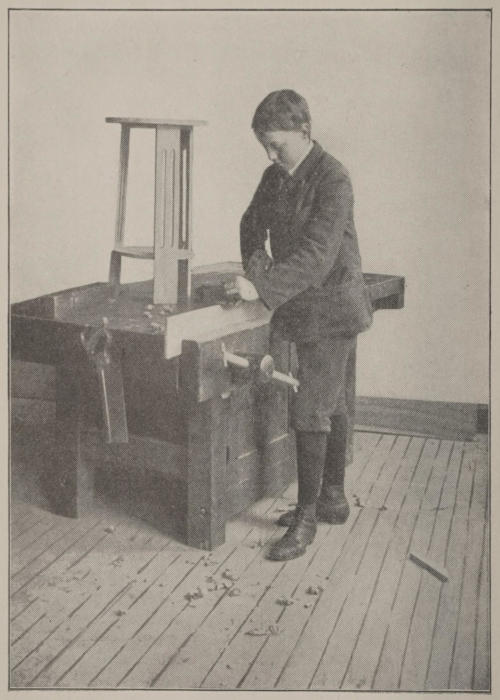
WOOD-WORKING
Title: Harper's indoor book for boys
Author: Joseph H. Adams
Release date: July 30, 2022 [eBook #68650]
Most recently updated: October 18, 2024
Language: English
Original publication: United States: Harper & Brothers Publishers, 1908
Credits: Richard Hulse and the Online Distributed Proofreading Team at https://www.pgdp.net (This file was produced from images generously made available by The Internet Archive/American Libraries.)

WOOD-WORKING
HARPER’S
INDOOR BOOK
FOR BOYS
BY
JOSEPH H. ADAMS
AUTHOR OF
“HARPER’S ELECTRICITY BOOK FOR BOYS”
AND JOINT AUTHOR OF
“HARPER’S OUTDOOR BOOK FOR BOYS”
WITH MANY ILLUSTRATIONS

HARPER & BROTHERS PUBLISHERS
NEW YORK AND LONDON
MCMVIII
Copyright, 1908, by Harper & Brothers.
All rights reserved.
Published April, 1908.
| PAGE | |
| INTRODUCTION | xi |
| Part I WOOD-WORKING |
|
| CHAPTER I—CARPENTRY | 3 |
| Tools: How to use them—The Work-bench—A Tool-rack—A Tool-chest—Joints—A Low Bench—A High Bench—A Step-bench—A Shoe-box—A Shoe-blacking-box—A Shoe-blacking-ledge—An Easel—A Clothes-tree—Hanging Book-shelves—A Corner Cabinet—A Chair—A Table—A Settle—A Suspended Settle—A Coal and Wood Box—A Flat-iron Holder—An Umbrella-stand—A Plant-box—A Final Word | |
| CHAPTER II—WOOD-CARVING | 38 |
| Method and Material—Tools—A Carver’s Bench—Chip-carving—A Frame for a Small Clock—Other Designs—Relief-carving—Mouldings | |
| CHAPTER III.—FRETWORK AND WOOD-TURNING | 56 |
| The Tools—The Practice of the Art—The Preparation of the Work—A Match-safe—A Wall-bracket—A Fretwork-box—Other Designs—Wood-turning | |
| CHAPTER IV—PICTURE MOUNTING AND FRAMING | 71 |
| A Dutch Head Mounting—A Dark Card Mounting—A Triple Mounting—Plain Framing—A Sporting Mount—A Round-robin Mounting[viii] | |
| Part II METAL-WORKING |
|
| CHAPTER V.—VENETIAN AND FLORENTINE METAL-WORK | 81 |
| Tools and Material—A Lamp-screen—Pattern-making—A Standard Screen—A Candlestick—A Candelabra—A Fairy Lamp—A Burned-match Holder—A Photograph-frame—A Handkerchief-box—A Sign-board—Double Doorway Grille—A Moorish Lantern | |
| CHAPTER VI.—METAL-BOUND WORK | 103 |
| A Metal-bound Box—A Wood-holder—A Plant-box—A Coal-box—A Table-lamp—A Hanging-lamp—A Hanging-plant Box | |
| CHAPTER VII.—DECORATIVE HARDWARE | 115 |
| Materials and Tools—Escutcheons—Short Hinge-straps—Long Hinge-straps—Drawer-pulls and Handle-plates—Door-plates—Large Lock-plates—Door-knockers and Miscellaneous Ornaments | |
| CHAPTER VIII.—WIRE-WORK | 125 |
| A Bird-cage Bracket—A Photograph Easel—A Match-box—A Fairy Lamp—A Picture-frame—A Glove-box—A Window-grille | |
| CHAPTER IX.—GAS AND ELECTRIC SHADES | 133 |
| A Simple Gas-shade—Another Gas-shade—A Metal Shade—An Electric-light Screen—A Bell-shaped Shade—A Pear-shaped Shade—A Dome-shaped Shade—Another Dining-room Shade—A Canopy—A Panel Shade | |
| CHAPTER X.—RELIEF ETCHING | 139 |
| Equipment—The Technique of the Process—The Acid Solution—Some Typical Designs | |
| Part III HOUSEHOLD ARTS |
|
| CHAPTER XI.—CLAY-MODELLING AND PLASTER-CASTING | 151 |
| Tools and Methods—The Technique of the Art—Glue and Gelatine Moulds—Hollow Casting—Modelling a[ix] Foot—Bas-relief Modelling—A Medallion Head—Coin and Metal Casts—Plaster-casting in General—How to Find and Mount Signets | |
| CHAPTER XII.—PYROGRAPHY | 170 |
| Fire-etching on Wood and Leather—Explanation of Methods—A Platinum-point Outfit—A Variety of Work on Wood—Suggestive Designs—Leather-work | |
| CHAPTER XIII.—BOOKBINDING AND EXTRA-ILLUSTRATION | 186 |
| Sheets and Signatures—The Tools—The Practice of the Art—Rebinding Books—How to Extra-illustrate a Book—A Circulating Library | |
| CHAPTER XIV.—MAGIC LANTERNS AND STEREOPTICONS | 203 |
| A Home-made Magic Lantern—A Stereopticon—Lantern Slides by Contact-printing—Lantern Slides by Reduction | |
| CHAPTER XV.—PRINTING, STAMPING, AND EMBOSSING | 222 |
| A Simple Flat-bed Press—An Upright Press—A Lever-press—Stamping—Embossing | |
| Part IV ROUND ABOUT THE HOUSE |
|
| CHAPTER XVI.—A HOUSE GYMNASIUM | 237 |
| Indoor Physical Development—Dumb-bells—Indian Clubs—Calisthenic Wands and Ball-bars—Swinging-rings—Trapeze Bars—Parallel Bars—A Floor Horizontal Bar—Striking-bags—A Medicine-ball—Pulley-weights and Exercisers—An Attic Gymnasium | |
| CHAPTER XVII.—A MINIATURE THEATRE | 259 |
| Arrangement and Lighting—Scenery and Equipment—The Puppets[x] | |
| CHAPTER XVIII.—FITTING UP A BOY’S ROOM | 267 |
| Simple Methods and Materials—A Plain Chair—An Odd Chair—A Morris Chair—A Settle—A Box-desk—A Writing-table—A Whatnot—A Treasure-chest—Studying-table and Stool | |
| CHAPTER XIX.—PAINTING, DECORATING, AND STENCILLING | 283 |
| How to Mix and Use Paints—Schemes of Decoration—Decorating a Bedroom—A Boy’s Room—Another Plan for a Room—A Nursery—Stencilling | |
| CHAPTER XX.—NOOKS FOR BOOKS | 302 |
| A Variety of Practical Designs—A Wall-rack—A Book-nest—Another Book-rack—A Corner-nook—A Book-tower—Hanging-shelves—A Book-castle—A Book-chair—A Book-table—A Magazine-rack—A Box Book-case—A Nursery Book-rack—Another Book-rack—A Handy Piece of Furniture—A Book-ledge and Stool | |
| CHAPTER XXI.—CLOCKS AND TIMEPIECES | 321 |
| Designs and Materials—A Bracket-clock—A Mantel-clock—A Wall-clock—A High Wall-clock—An Odd Mantel-clock—A Shelf-clock—An Old-style Timepiece | |
| CHAPTER XXII.—SCREENS, SHOE-BOXES, AND WINDOW SEATS | 331 |
| A Light-screen—A Fire-screen—A Shoe-screen—A Bedroom-door Screen—A Heavy Fire-screen—A Window-seat with Under Ledge—A Shoe-box Seat—A Dressing-room Settle—A Short Settle—A Foot-rest—A Combination Shoe-box and Seat—A Double Shoe-box and Seat—A Curved-back Window-seat—A Window-seat and Shoe-box | |
| CHAPTER XXIII.—HOUSEHOLD CONVENIENCES | 347 |
| A Plate-rail—A Cup and Plate Rack—A Cup and Plate Pyramid—A Butler’s Tray—Cup-pins and Brush-rack—Lock-shelves—A Vegetable-bin—A Spoon-bar and Saucepan-rack—A Medicine-chest—A Convenient Plant-tray—An Indispensable Clothes-press—A Divan—A Corner Dressing-table | |
The success of Harper’s Outdoor Book for Boys seems to insure a welcome for an indoor handy book, equally practical and comprehensive, which shall show how leisure time indoors can be spent most pleasantly and profitably. When stress of weather, or the coming of long winter evenings, or any other reason gives the indoor part of life a larger importance, this indoor handy book will be found an invaluable companion. Good books and good games have their value always, but there is also a large place for the joy of actual accomplishment. It is good to do things. It is worth while to learn to use hands and eyes in the production of working results. And when, as in the case of the explanation of this book, achievement goes hand in hand with amusement, it is clear that Mr. Adams and his associates are the best of companions for an indoor day or evening.
Expensive tools and apparatus are not called for. A boy should have good but not necessarily costly tools, and he should take proper care of them. Furthermore, whether his working-place is in his room or elsewhere, he should feel that he is put upon his honor to remove any rubbish and to avoid injury to floor or walls. Let us understand at the outset that the explanation in these pages can be followed[xii] at very little expense, but in this work, as in everything else, common-sense is necessary. To use one tool for work to which another is adapted, or to neglect one’s implements, or allow them to get wet and to rust or to become hopelessly dulled or nicked, is a sign of shiftlessness. A good workman always takes care of his tools, and he also keeps his work-bench in order. The very mention of work in a boy’s room, or even indoors, may excite fears of disorder on the part of the mother; but experience has shown that with care on the part of the boy, and some concessions from the mother, these fears are groundless.
It is desirable that a boy should have a place, whether it be in the cellar or attic, or a corner of his room, definitely devoted to his own work. It is also a useful training for him to feel that he is put upon honor both to confine his work to his own bounds, and also to “tidy up” whenever he leaves his task. With a little patience and oversight all this can be adjusted to the mutual satisfaction of the household and the boy.
In addition to the training in various directions which we have indicated, the suggestions in these pages will help the boy to make things which are useful—to become a contributor to his home. A glance at the Table of Contents shows, under “Wood-working,” an introduction to the use of carpenters’ tools, and instructions in making picture-frames and ornamented wood-carving. Of late years ornamental work for lamps, sconces, hinges, and a variety of purposes has steadily grown in favor, and the second division of the book tells how a great variety of decorative and useful objects in metal may be made. When so much experience[xiii] has been gained, the boy can readily take up more advanced work, such as modelling in clay, and plaster casting; bookbinding, and the kindred craft of extra-illustration; pyrography, or decorative work in burnt wood; printing, stamping, and embossing; and the construction and use of the stereopticon. In Part IV. the young craftsman is shown how he may employ the technical knowledge he has acquired in the fitting up and decoration of his room; in the building and operating of a miniature theatre; in the installation of a home gymnasium; and in the making of various objects of ornament and utility for the household. Amateur photography has been purposely omitted, since there are many excellent and practical manuals on the subject that have been published by the various camera manufacturers for gratuitous distribution. It is easy to see the possibilities for usefulness, for beauty, and for amusement in the home, which are brought within reach in these pages; and these instructions also represent possibilities for earning money. In, schools where manual training receives attention, and, indeed, in any school library, this book will prove peculiarly useful.
Here, as in the Outdoor Handy Book, it has been kept in mind that there will be neither fun nor profit in doing these things unless the way is made clear, and it is certain that the desired results will follow if the directions are carried out. Everything, therefore, has been tested, and all the instructions are put in simple, practical form. It is a friendly, well-tried, and reliable household companion that comes to young Americans in Harper’s Indoor Book for Boys.
Carpentry, or the science of making things out of wood, is the oldest and comes the closest to us of any of the applied arts and crafts. The earliest men made clubs at least. Later they began to build, to construct, and it is interesting to remember that this ability to construct is a faculty shared with man by the animals. There are many species of birds that build well-designed nests; the spider is a weaver; the bee is a geometrician; the ant is a tunnel builder; the beaver, in the construction of his dams and breakwaters, displays engineering ability of a high order. The vital difference between the animal and the human intelligence lies in the fact that the latter is progressive. The spider weaves just the same pattern to-day that he did when the Pyramids were young; the mathematical section of the bee cell is invariable; the mud-swallows build the same kind of houses as their remotest ancestors. The common explanation is that instinct and not reason guides the animal in his work, and instinct is a reproductive faculty, not an inventive one. It is for man alone to progress from the crude beginnings of an art to its highest and most perfect development.
Perhaps the first and most urgent need of all living creatures is for shelter. The oriole weaves his hanging nest; the beaver constructs his wonderfully domed house; primitive man builds his hut of interlaced boughs. But it is man alone who is not content with the first crude efforts; he is constantly aiming after something more substantial and better adapted to his increasing needs. So man becomes the true builder, and as wood is the simple and almost universally obtainable material, carpentry, or the art of working in wood, stands at the head of the applied sciences upon which the civilization of the race depends.
The average boy takes to carpentry as naturally as ducks take to water, and beginning with the tacks a baby boy will hammer in a board, the young builder goes on from the simple to the more complex forms until he attains the full mastery of his material and his tools. He has now obtained the dignity of manhood; he is a maker of things.
Once proficient in the art of cutting, joining, and fastening wood-work, and in the use and care of tools, a boy may begin to call himself a carpenter. But he must learn to work systematically and accurately if he is ever to become a genuine craftsman. In the first place, he should understand the possibilities and limitations of his tools. He should never use a chisel for a screw-driver, nor drive nails with the butt end of a plane. Good tools should have good care. Inanimate things that they are, they yet resent ill-usage, and retaliate, in their own way, by becoming dull and otherwise unfit for their work. Indeed, a good carpenter may be known by the condition of his tool-chest and work-bench. Carpentry, when properly carried on, is[5] a most fascinating occupation for out-of-school hours, especially in the winter season, when bad weather keeps one indoors. Needless to say, it may be made a profitable way of passing time as well as an amusing one.
The tools that a boy will need in order to do good joiner-work should be the same as carpenters use, but they may be smaller and not so cumbersome to handle. The set of tools in a chest, put up for the use of children and sold at toyshops, are not the sort that can be relied upon for good carpentry work, since they are usually dull and made of soft steel that will not hold an edge. Possibly the manufacturer thinks that he is justified in turning out this kind of rubbish, bearing in mind the old saying, “Children should not play with edged tools.” But the boy who is old enough to take up carpentry in earnest is entitled to the use of good and serviceable implements, and without them it is hardly worth while starting at the business.
Competition has brought down the cost of good tools to a point where they are not beyond the means of the average boy who is prepared to save his pocket-money. It is better to purchase only a small kit at first, and then to add to it from time to time, until the complete outfit is obtained.
Good tools may be purchased at nearly every hardware shop or general store throughout the country. For ordinary work you will require a good rip and cross-cut saw, with twenty and twenty-four inch blades, respectively; a claw-hammer, and a smaller one; a wooden mallet for[6] chisels, and to knock together the lap joints of wood; a jack and a smoothing plane; a compass-saw; a brace and several sizes of bitts, ranging from a quarter to one inch in diameter; a draw-knife; a square; awls; pliers; a rule; several firmer-chisels, and a screw-driver. There are many other useful tools, but they may be added as they are required.
It is a difficult matter to instruct a boy, by written description, how to handle tools; and rather than attempt it, I should advise the young workman to watch a carpenter at his work. Most carpenters are quite willing to have you follow their movements, and many of them will even offer advice, if they see that you are really interested. But remember that a good workman never likes to have a boy meddle with his tools, and you should not ask foolish or unnecessary questions.
Perhaps there is a carpenter’s shop near your home in which the owner may let you work occasionally (if you keep out of his way), and where, in the atmosphere of the craft, you will make faster progress than you can possibly do at home with no one to tell or show you how things should be done.
One of the indispensable pieces of equipment for the boy carpenter is a good work-bench. The bench must be substantially made, and provided with a planing-stop, a vise, and a drawer in which to keep small tools, nails, screws, and the various odds and ends that are employed in carpentry.
To begin with, obtain four spruce or white-wood sticks,[7] three inches square and thirty-six inches long, planed on all sides. These are for the legs. You will also need two pieces of clear pine, or white-wood, three feet long and six inches wide, and two more the same length and three inches wide. These pieces should be one and an eighth inches thick, and planed on all sides and edges.
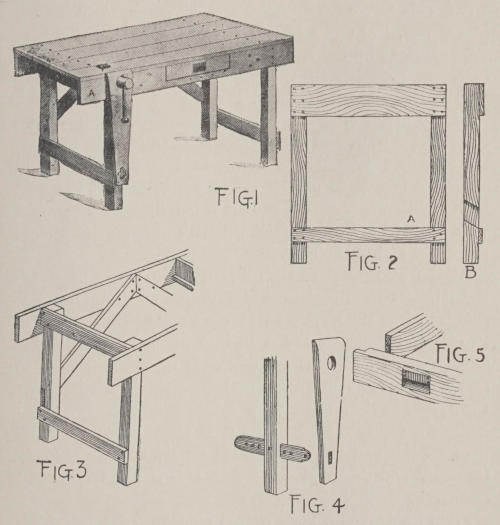
Fig. 1. Fig. 2. Fig. 3. Fig. 4. Fig. 5.
Lay two of the legs on the floor, three feet apart, and join the ends with one of the six-inch strips. Six inches up from the free ends fasten a narrow strip, as shown in Fig. 2 A. This finishes one of the end supports. Flat-headed iron screws, two and a half inches long, should be used for the unions, and a tighter joint may be secured by also using glue.
Prepare, in similar fashion, the other pair of legs, and, with two pieces of clear pine, or white-wood, five feet long, eight inches wide, and seven-eighths of an inch thick, bind the four legs together, as shown in Fig. 3. You should allow the boards to project six inches beyond the legs at both ends. These pieces are the side-rails, or aprons, and they should be securely fastened with glue and screws to the upper end of each leg.
At the back of the bench arrange two braces of wood, three inches wide and seven-eighths of an inch thick, as shown in Fig. 3. Bevelled laps are to be cut in the side of two legs, as shown in Fig. 2 B, into which the ends of the strips will fit flush. The upper ends of the strips are to be mitred (cut at an angle), and attached to the inside of the apron, as shown in Fig. 3.
For the top of the bench use clear pine planking not less than one inch in thickness. This should be fitted closely together, and fastened to the cross-pieces with stout screws.
From hard-wood a piece should be shaped for a vise-jaw thirty-two inches long, three inches wide at the bottom, and seven inches wide at the top. Near the bottom of the jaw an oblong hole should be cut to receive the end of a[9] sliding piece, which in turn is provided with several holes for a peg to fit into. A corresponding oblong hole is cut near the foot of one leg, through which the piece containing the holes will pass. This last regulates the spread of the jaw. This construction may be seen in Fig. 4, and its final position is shown in the illustration of the finished bench (Fig. 1).
Near the top of the jaw a hole is cut to receive the screw that is turned with the lever-stick to tighten the jaw. A bench-screw may be purchased at any hardware store, and fitted to the work-bench. If it should prove too much of an undertaking for the youthful workman, a carpenter will put it in place at a trifling cost. The wood screws are the cheapest, but the steel ones are the most satisfactory, and will cost about one dollar for a small one.
From the apron (at the front of the bench) a piece should be cut fifteen inches long and six inches wide. This opening will admit a drawer of the same width and height, and as deep as may be desired. Twenty-four inches will be quite deep enough.
Rabbets are cut in the ends of a front piece, and the sides are let into them, as shown in Fig. 5. The bottom and back are fastened in with screws, and the drawer is arranged to slide on runners that are fastened across the bench inside the aprons, as shown in the upper corner of Fig. 3.
At the front of the drawer a cove may be cut out, and a thin plate of iron screwed fast across the top of it, so that the fingers may be passed in behind the plate to pull out the drawer (Fig. 5). It will not do to use a projecting drawer-pull, as that would interfere with pieces of work[10] when clamped in the vise. In planing strips, or boards, that are too long for the vise to hold securely, a wooden peg, inserted in a hole at the opposite end of the apron from the vise, will be found convenient. Two or three holes may be made for boards of different widths, and the peg adjusted to the proper one as occasion requires.
A planing-stop, with teeth, may be purchased at a hardware store and set in place near the vise-jaw. The complete bench will then be ready for use.
For the accommodation of chisels, gouges, screw-drivers, awls, compass-saws, pliers, and other small tools a tool-rack will be found convenient. It should be fastened against the wall immediately over the work-bench.
The one shown in Fig. 6 is thirty-six inches long and twelve inches high, with a ledge projecting two inches from the back-board. A leather strap is caught along the upper part of the board with nails to form loops, into which the tools are slipped.
The ledge is made from two strips of wood. One of them, one and a half inches in width, is cut with a saw, as shown in Fig. 7, and the superfluous wood, between the saw-cuts, is removed with a chisel. When all the notches are cut, a narrow strip, half an inch in width, is screwed fast to the notched strip. The ledge is then attached to the lower edge of the back-board with long screws, as indicated in the illustration.
The hanging tool-cabinet shown in Fig. 8 should be constructed with two doors of nearly equal size, so that four instead of two surfaces may be available, against which to hang tools.
The body part of the chest is thirty inches high, twenty inches wide, and nine inches deep, outside measure. It is made of wood three-quarters of an inch in thickness, fastened together with screws and glue, and varnished to improve its appearance.
The right side of the cabinet is but three and a half inches wide, and to this the inner door is made fast with hinges, so that it will swing in against a stop-moulding on the opposite side, as shown at A in Fig. 9. A small bolt will fasten the door in place when shut in, and on both sides of this door hooks and pegs may be arranged for the reception of tools. The back-board of the cabinet may be used for hanging saws, squares, and other flat tools, as indicated in Fig. 8.
The outer door is provided with a side-strip (Fig. 9 B) of such size that when the doors are closed in and locked the appearance of the chest will be uniform, with a cross-section appearing, as shown in Fig. 9 C. With a little careful planning and figuring it will not be a difficult matter to construct this cabinet. Take particular care to have the doors fit snugly and close easily. The doors will keep their shape better if they are made from narrow matched boards, held together at the ends with battens, or strips, nailed across the ends of the boards, as shown in Fig. 9 D.[12] Two-inch wrought butts will be heavy enough for the doors, and a cabinet-lock at the edge of the outer door will make all secure.
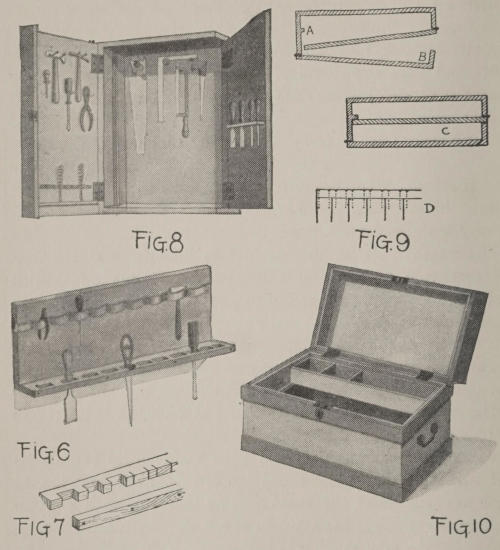
Fig. 6. Fig. 7. Fig. 8. Fig. 9. Fig. 10.
On the inside of the outer door some tool-pegs may be arranged. Near the bottom a bitt-rack should be fitted,[13] with a leather strap formed into loops, as described for the tool-rack. Under each loop a hole should be bored in a strip of wood, into which the square end of the bitts will fit, and thus insure their orderly position. For chisels a similar set of pockets may be designed as shown in Fig. 8.
The tool-chest shown in Fig. 10 is twenty-eight inches long, fifteen wide, and twelve inches high. This is a good size for the accommodation of a moderate-sized kit of tools. The interior fittings should include two or three trays arranged to rest on runners and to slide back and forth, so that tools may be reached at the bottom of the chest without removing the trays.
Obtain a pine or white-wood board fifteen inches wide, and free from knots or sappy places. Cut two pieces twenty-eight inches long, and two shorter ones twelve inches long. These will form the top, bottom, and ends. Cut out the front and back pieces twenty-eight inches long and twelve inches wide; then with glue and screws form a box, and let it stand a day until the glue is hard. Make the joints as perfect and tight as possible, so as to present a good appearance; then mark a line around the box two and a half inches from the top.
With a rip-saw cut the cover free from the body, and plane the rough edges of the cut, so that the cover will fit the body snugly. Bind the lid and the top and bottom edges of the chest with a strip of wood three-eighths of an inch in width, as shown in the illustration; to look well,[14] the corners should be mitred. The lid is attached to the chest with stout hinges, and a lock is arranged at the front. Stout handles at the sides will be found a convenience.
Two or three coats of olive-green paint, with a slightly darker shade for the bands, will improve the appearance of the chest. To keep the hardware from rusting, the lock, hinges, and handles should receive a coat or two of black paint.
One of the first lessons for the young carpenter to learn will be that of making wood joints. Without good joiner-work there is no such thing as carpentry, and it is the sign-manual of the competent artificer. There are a great variety of joints employed in carpentry, but many of them are too complicated for the boy carpenter to make, and the simple forms will answer every reasonable requirement.
The easiest joint to make is the straight, or box, joint. It is constructed by butting the end of one board against the edge of another and nailing, or screwing, them fast.
Fig. 11 shows a lap-joint made by cutting away a portion of the wood on opposite sides of the ends which are to be joined. When fastened the wood will appear as a continuous piece. For corners and angles, where a mitre-box is not available, the lap-joint is a very good substitute, and for many uses it is stronger than the mitred-joint, and, therefore, to be preferred.
Fig. 12 is another form of lap-joint, where the end of a strip is embedded in the surface of a stout piece of wood.[15] This joint will be found useful in furniture work, and also for frame construction in general.
Fig. 13 is a bevelled lap-joint, and is used for timbers and posts, particularly under conditions where the joint can be reinforced by another piece of wood at one or two sides.
Fig. 14 shows a mortise and tenon. The hole in the upright piece is the mortise and the shaped end on the stick is the tenon. The shaped end should fit the hole accurately, and the joint is usually held with a pin, or nails, driven through the side of the upright piece and into the body of the stick embedded in the mortise. The mortise and tenon is used extensively in framing, and for doors, window-sashes, and blinds. In cabinet work it is indispensable.
Fig. 15 is the mitred-joint. In narrow wood it is usually cut in a mitre-box with a stiff back-saw to insure accuracy in the angles. The mitred-joint is employed for picture-frames, screens, mouldings, and all sorts of angle-joints.
Fig. 16 is the tongue-and-groove joint, and is cut on the edges of boards that are to be laid side by side, such as flooring, weather-boards, and partitions. Before wood-working machinery came into general use the tongues and grooves were all hand-cut with planes, but a tongue-and-groove plane is now almost obsolete, all this class of building material being mill finished.
Fig. 17 A is a rabbet. It is cut on the edges of wood, and another similarly shaped piece fits into it. It is also useful where wood laps over some other material, such as glass or metal. The inner moulding of picture-frames are always provided with a rabbet, behind which the edge of the glass, picture, and backing-boards will fit.
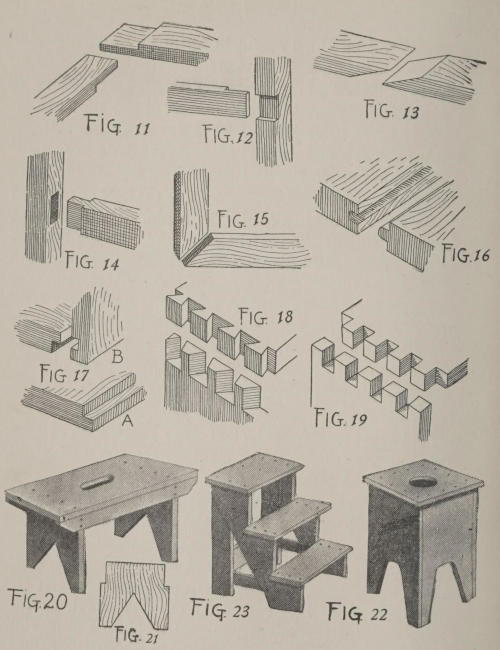
JOINTS, RABBETS, AND BENCHES
Fig. 11. Fig. 12. Fig. 13. Fig. 14. Fig. 15. Fig. 16. Fig. 17. Fig. 18. Fig. 19. Fig. 20. Fig. 21. Fig. 22. Fig. 23.
Fig. 17 B is a rabbet-joint made with a rabbet and groove. It is a good one to employ for box corners, and where the edges of two pieces of wood come together.
Fig. 18 is the dovetail-joint used for boxes, drawer corners, chests, and sometimes in cabinet work, where the corners are to be covered with mouldings or edging-strips.
Fig. 19 is the straight dovetail employed in the cheap construction of small boxes for hardware, groceries, and other wares. Since the edges are straight, this is the easier one to make, but care must be taken to have the fitting accurate.
Small benches are useful to work upon when sawing, nailing, and matching boards; and they are handy for many purposes about the house. The low bench shown in Fig. 20 is fifteen inches high and twelve inches wide, and the top is twenty-two inches long. The foot-pieces are cut as shown in Fig. 21, and at the upper end at each side a piece is cut out to let in the side-aprons. The aprons are three inches wide and seven-eighths of an inch thick; they are held to the foot-pieces with glue and screws. In the top a finger-hole is cut so that the bench may be quickly picked up and the more easily handled.
The high bench shown in Fig. 22 is twelve inches square and twenty-four inches high, with a top fourteen inches square. The wood is seven-eighths of an inch thick, and[18] all the joints are made with screws. A hand-hole is cut in the top with a compass or key-hole saw, and all the edges are sand-papered to round them off.
A step-bench will be found useful for various purposes. It does not take up so much room as a step-ladder and affords a more solid footing. The bench shown in Fig. 23 is thirty inches high, fifteen inches wide, and eighteen inches deep. The uprights that support the sides are five inches wide; the treads of the first and second steps are six inches wide, and that of the top step eight inches wide. The wood is seven-eighths of an inch thick, planed on both sides, and all the unions are made with screws. The cross-brace at the back and near the bottom is set into laps cut in the edges of the upright supports, and to prevent the support and side-pieces from spreading, stanchion-bars may be screwed fast to the sides, under the first tread, and to the foot of the uprights.
Two or three coats of paint will finish these benches and make them fit for use about the house.
A shoe-box and seat (Fig. 24) is a useful piece of furniture in any bedroom. Two boxes, purchased at a grocery store, may be made to serve the purpose, but for a really neat and workmanlike job the frame should be constructed of boards three-quarters or seven-eighths of an inch in thickness.[19] A good size for the shoe receptacle is twenty-four inches high, fifteen inches deep, and sixteen inches wide. The seat-box should be thirty inches long, and fifteen inches high and deep.
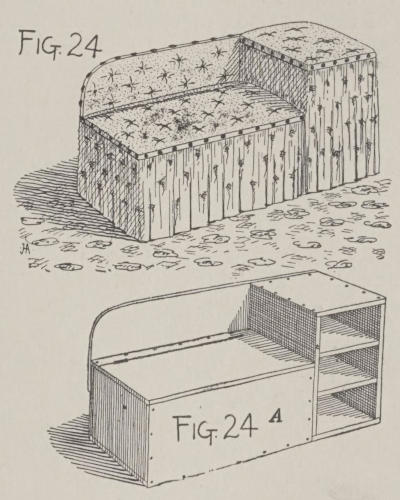
Fig. 24. Fig. 24 A.
These boxes are to be attached to each other with stout screws, and a back the length of the two boxes, and having a rounded corner is to be securely fastened to the rear of each box, as shown in Fig. 24 A. In the shoe-box two shelves are screwed fast, and to the lower box a corner should be arranged on hinges so that it may be raised from the front. The back and seat and also the top of the shoe-box should be covered with denim, under which a padding of hair or cotton may be placed. The denim should be caught down[20] with carriage-buttons and string, the latter being passed through holes made in the wood and tied at the underside. Around the front and sides a flounce of cretonne or denim may be gathered, and hung from the top edge of the box and seat. If finished with gimp and brass-headed tacks it will present a good appearance. Where the drop-curtain at the edge of the shoe-box meets the seat the fabric is to be divided, in order that it may be drawn to one side when taking out or replacing shoes.
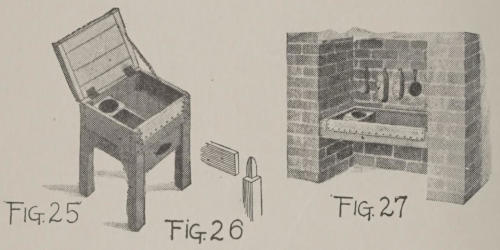
Fig. 25. Fig. 26. Fig. 27.
A coat of shellac, or paint, will cover such parts of the wood-work as are not hidden by the upholstery. Fig. 24 shows the finished article of furniture.
Every boy should own a shoe-blacking-box, such as is shown in Fig. 25. Otherwise, the brushes and blacking-box are apt to get widely separated, and are never at hand when they are wanted. Moreover, it is a slovenly practice to use a chair or stool as a foot-rest when engaged in polishing[21] one’s shoes, since the blacking is sure to discolor and dirty whatever it touches. This shoe-blacking-box is twenty-four inches high and eighteen inches square, the compartment being four inches deep. Four sticks, two inches square and twenty-four inches long, will form the legs. Each stick should be cut away at one end three-quarters of an inch deep for a distance of five inches, as shown in Fig. 26, so that when the side boards are fastened to them the joints will be flush. Two sides of each stick should thus be cut away, and the small end of the stick may be tapered slightly. The side boards, of three-quarter-inch wood and five inches wide, are screwed fast to the top of the legs.
A bottom sixteen and a half inches square is cut from boards and fastened inside the frame, where it is held in place with steel-wire nails driven through the lower edge of the side boards and into the edge of the bottom, all around.
Four brackets are cut and fastened with screws at each side of the box, under the side boards. A cover is made and hinged to the box, where it is prevented from falling too far back by a chain attached to the underside of the lid and to the inside of the box.
Over the front edge of the box bend a strip of zinc and tack it fast to both the in and outside of the front board. This will prevent shoes from chafing the wood away, and is easily cleaned when muddied up.
With a thin piece of wood make a division in the box at one side, where blacking and daubers may be kept. Also a drawer may be fitted to slide in and out under the box. It should be constructed, as described for the work-bench, and arranged to work on runners fastened to the inside of[22] the legs. Screw-eyes or staples should be driven into the ends of the brushes and daubers, so that they may be hung up in an orderly manner on hooks set in the wall immediately over the ledge.
A few thin coats of olive-green or light-brown paint will add to the appearance of this shoe-blacking-box, and the owner should take pride in keeping it clean, and the brushes in good order.
In a cellar where one of the chimneys is built with a recess, a shoe-blacking-ledge may be made from four boards five inches wide. The bottom is slatted, so that dirt will fall through. Fig. 27 shows quite clearly how this can be done. One end is partitioned off to hold the box of blacking.
The ledge is twenty-four inches high, and the front board is bound with a strip of zinc along the upper edge. The blacking-brushes may be kept in the tray, but it is a better plan to hang them up against the brick-work on steel nails. If the brushes are to be kept inside the tray, a lid should be made and hinged to the back strip of the tray. When the lid is raised it may be held against the brick wall with a wooden button.
Boys who have a talent for drawing and painting would undoubtedly like to have an easel on which to work, and a good strong one may be made, at moderate cost, in the following manner (Fig. 28).
Obtain four pieces of clear white pine six feet long, two[23] and a half inches wide, and seven-eighths of an inch in thickness. These should be planed on all sides. Two of the sticks should be tapered off at one end, and slightly bevelled at the other. Nine inches from the top and twelve inches up from the bottom laps are to be cut in the sticks at the back, as shown in Fig. 29. Into these the ends of cross-pieces will fit. If the concealed lap is too bothersome to make, it can be cut clear across the sticks, as shown in Fig. 30. Glue and screws will make a strong joint.
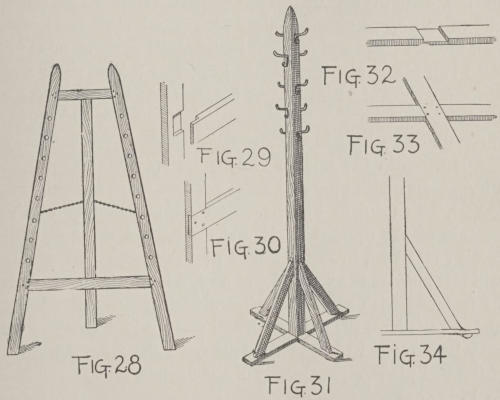
Fig. 28. Fig. 29. Fig. 30. Fig. 31. Fig. 32. Fig. 33. Fig. 34.
The remaining long stick is the back support, or leg, and is to be hinged to the upper cross-piece. With this leg the easel may be pitched at any angle, and to prevent it from[24] going back too far a guide-chain should be attached to the leg, and the ends secured to the back of each upright with staples. Holes are bored along the uprights at even distances apart, and two wooden pegs are cut to fit snugly in the holes, and so hold a drawing-board or canvas-stretcher.
A clothes-tree is a most serviceable article of furniture, and helps a boy to form habits of neatness and orderliness in the care of his wearing apparel. To make the one shown in Fig. 31 obtain a clear pine or ash stick one and a half inches square and five feet long for the upright, or staff. Also two pieces eighteen inches long, two inches wide, and three-quarters of an inch thick for the feet; and four braces twelve inches long, one and a half inches wide, and three-quarters of an inch in thickness.
Cut a lap in the middle of each foot-piece, as shown in Fig. 32, and with glue and screws fasten them securely together, as shown in Fig. 33. Screw this foot fast to the bottom of the upright stick, and strengthen the four projecting feet with braces bevelled at the ends, so that they will rest against the upright and on the foot, where they can be fastened with screws, as shown in Fig. 34. Under the end of each foot, the half of a small wooden ball, or a castor, may be arranged to raise the tree from the floor. With a chisel and plane taper the top of the upright stick, as shown in Fig. 31.
At a hardware store purchase eight hooks and arrange them in alternating pairs, as shown in the drawing. The[25] wood-work should be shellacked or painted to give it a finished appearance.
When hanging clothes upon this tree place the coat, vest, and trousers on the lower hooks, the shirt and underclothing on the hooks next above, and on the top hooks the necktie and collar and cuffs. When dressing, the clothing needed first will then be the nearest to hand.
In a room where space cannot be given up to a standing bookcase, it may be possible to arrange a set of shelves to form a book-rack that will hang against the wall. The construction of the hanging shelves shown in Fig. 35 is very simple, and will require but a few boards, two wall-strips, and a few yards of strong rope.
For the shelves, obtain five pine boards eight inches wide, seven-eighths of an inch thick, and from three to four feet long; also two pine strips three inches wide, an inch thick, and four feet long. In the rear edge of each board, at the ends, cut notches three inches long and an inch wide, as shown in Fig. 35 A, into which the wall-strips will fit. Round off the top of each wall-strip and screw them fast to the notched edges of the shelves, first boring gimlet holes in both strips and shelves to prevent splitting of the wood.
Half-inch holes at the top of each wall-strip will admit the suspension rope, which is of manila, and half an inch in diameter. Knot one end of the rope and pass it up through holes made at the outer corners of each shelf, and finally through the hole at the top of the wall-strips, and cut it off[26] three inches back of the hole. With a gouge-chisel a groove should be made at the back of the wall-strip for an inch or two below the hole, so that the rope end may be carried down and ravelled out. It can then be glued and held fast to the wood with staples. Where the rope passes through the hole in each shelf, drive several long steel-wire nails into the edge and end of the board, allowing the nails to pass through the rope and into the wood.
Paint or varnish the wood-work, and securely anchor the wall-plates with stout screws driven into the frame timbers, through the lath and plaster of the wall.
A corner cabinet of odd design and simple construction is shown in Fig. 36. The total height of the wall-plates should be thirty-four inches, and at the top the shelf measures eighteen inches across. Each shelf is rounded out at the front so as to afford more surface on which to place books and bric-à-brac. The ends of each shelf are securely attached to the side or wall-plates with screws, thus insuring a perfect anchorage and a strong construction.
Fig. 37 is a plan showing the shape of the sides or wall-plates. At the widest part they should measure twelve inches across. Fig. 38 is a plan of the top shelf, which is followed in shape by the others. They decrease, however, in size as they near the bottom. The notch at the middle of each shelf breaks the long curved line in a pleasing manner. Two light metal rods from which curtains hang may be arranged under the top shelf and the one next the bottom. Shellac or paint of some appropriate shade will add to the appearance of this useful piece of furniture.
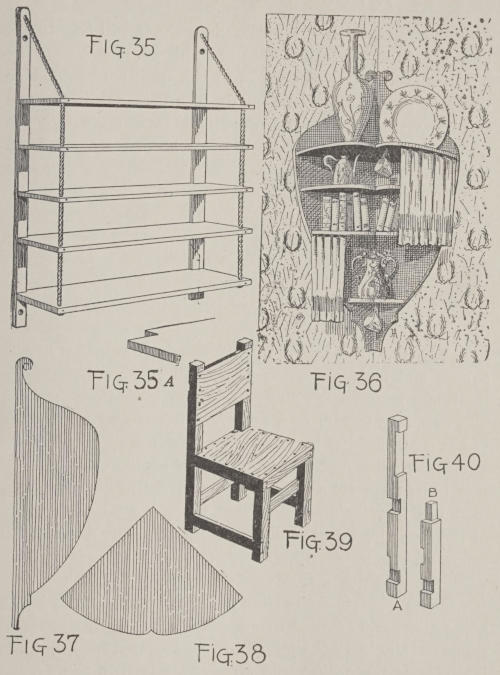
HANGING BOOK-SHELVES AND CHAIR CABINET
Fig. 35. Fig. 35 A. Fig. 36. Fig. 37. Fig. 38. Fig. 39. Fig. 40.
When fastening this cabinet to the wall, care should be taken to pass the screws securely into the studding or uprights. Otherwise the screws might pull out under the accumulated weight, and a fall would be disastrous to both the cabinet and its contents.
The construction of a chair is perhaps as interesting as anything in carpentry. The one shown in Fig. 39 may be made from either soft or hard-wood, the joints being all open and simple to cut.
The legs are two inches square, the seat is sixteen inches square and eighteen inches high, and the back posts are thirty-six inches long. The front and back posts are cut out, as shown in Fig. 40 A and B. These receive the cross-pieces that bind the legs and back together. The posts are two inches wide and three-quarters of an inch thick. The side braces are set two inches up from the floor and the back one four inches. The front brace is let into the rear of the front legs, and is eight inches from the floor to the lower edge.
The seat is made from matched boards, and the back, ten inches wide, is made from a single board, all the joints being glued and screwed together. Chairs that are made in shops usually have the joints dowelled or mortised, but the lap-joint is the easiest and strongest one to make. Take care, however, that the cuts are accurately sawed, and that[29] the cross-pieces fit the laps so snugly that a mallet is necessary to help drive the strips home.
The seat and back of this chair may be covered with denim, leather, or other upholstery material, drawn over curled hair, or cotton may be used for padding, and fastened down around the edges with large flat-headed tacks or upholstery nails. Shellac, varnish, or paint may be used to give the wood-work a good appearance.
It is not so difficult as it may seem to make a good strong table, but care and perseverance must be exercised to obtain a satisfactory result. When constructing a table bear in mind that every joint should be made to fit accurately; otherwise it will quickly rack and become useless. The proportions and shape for a serviceable table are shown in Fig. 41. Only well-seasoned wood should be employed, and it should be free from knots or sappy places.
For the legs, obtain four sticks thirty-three inches long and two and a half inches square. From two sides, near the end of each stick, cut the wood away for five inches to a depth of seven-eighths of an inch, as shown (at the top) in Fig. 40 B. Now cut two boards five inches wide and forty-two inches long, and four more thirty inches long for the frame. Six inches from the uncut ends of the legs saw and chisel out laps, so that two of the thirty-inch lengths will fit into them, and with two long and two short boards unite the legs, thereby forming a frame thirty inches wide, forty-two inches long, and thirty-three inches high. An under-shelf[30] may be made twelve inches wide and long enough to extend two or three inches over the cross-strips.
The table top extends over the framework for three inches all around, and it is made of narrow tongue-and-grooved boards driven together and screwed down to the band around the top, formed by the thirty and forty-two-inch boards. To finish this top nicely it may be covered with felt, or with imitation leather, in old-red, green, or brown shades, caught under the edge and made fast with stout tacks.
A comfortable settle (Fig. 42), for the piazza or yard, may be made from pine, white-wood, cypress, or almost any other wood that may be at hand.
It is fifty-four inches long, eighteen inches wide, and the seat is eighteen inches above the ground. The sides are made from strips three inches wide and seven-eighths of an inch thick, as shown in Fig. 43 A. The arms are twenty inches long, six inches broad at the front, and cut the shape shown in Fig. 43 B. The notches or laps cut in the rear posts are to let in the strips forming the back and lower brace.
The joints should be made with screws rather than nails, as they hold better and do not work loose. Small brackets support the arms at the front corner posts, and a batten at the middle strengthens the back of the settle. A close inspection of the drawings will show the joints clearly and indicate how the frame is put together. A few coats of paint will finish the wood nicely, or it may be stained and[31] varnished if the wood has a pretty grain. Cushions and a sofa-pillow or two will add to the comfort of this commodious seat.
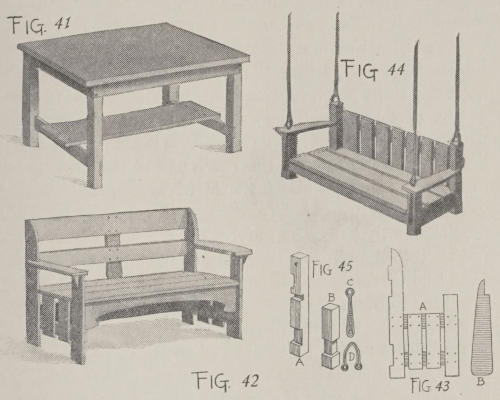
Fig. 41. Fig. 42. Fig. 43. Fig. 44. Fig. 45.
A suspended settle (Fig. 44) is a convenient piece of piazza furniture, and not a difficult thing for the young carpenter to make.
The corner posts are two and a half inches square, and the boards used in its construction are seven-eighths of an inch thick and four inches wide. The seat is forty-two[32] inches long and eighteen inches wide, and the back is fifteen inches high from the seat. The arms are cut as shown in Fig. 43 B, and securely screwed to the corner posts. The frame-pieces supporting the seat-boards are let into the back and front posts, in which laps have been cut, as shown at Fig. 45 A and B. They should be securely fastened with flat-headed screws. Both the rail to which the backing-boards are attached and the rear ends of the arms are let into the corner post and fastened with screws.
The seat is suspended from the ceiling of the piazza on four chains that may be purchased at a hardware store or from a ship-chandler, or they may be made by a blacksmith from iron three-eighths of an inch in diameter. If it is not possible to obtain the chains, rope may be substituted, but it will not look or last so well.
Two yokes bolted to the top of the back posts and eye-straps for the front posts will anchor the chains securely to the settle. The yoke is shown at Fig. 45 C, and the eye-strap at Fig. 45 D. A bolt passed through the top of the rear posts and through the holes in the yoke will secure the latter firmly, and a nut will prevent it from slipping loose. Holes are made in the arms, and the eye-straps are passed down through them and attached to the front corner posts with screws, as shown in Fig. 44. The back of the settle is composed of boards four inches wide and placed an inch apart.
A combination box for coal and wood may be made from an ordinary shoe-box, the sides and one end being cut down[33] as shown in Fig. 46; but a more serviceable one is constructed of boards seven-eighths of an inch thick, planed on both sides, and with the joints securely glued and screwed.
The sides are twenty-six inches long and twelve inches high at the back. At the front they are but four inches high. A back-piece ten inches wide and twelve inches high is cut and fastened in place, and a front strip four inches high is also made fast with glue and long, slim screws.
A division-board is placed in the middle of the box, as indicated by the line of screw-heads, and a bottom, ten by twenty-four inches, is held in place with screws passed through the lower edge of the front, back, and sides, and into the edges of the bottom.
A lid the width of the box is hinged to a cross-strip over the partition. A handle at the lower end will make it easy to lift the lid. Blocks with the corners rounded off will serve as feet, one at each corner.
Thin stain and two coats of varnish will finish the wood-work on the outside. A coat or two of asphaltum varnish will be better for the inside.
Sticks of wood for the open fire or kindling for the grate fire may be kept in the square receptacle, while under the lid at least two bucketfuls of coal may be stowed away. If the fuel-holder is used only at the open fire, logs may be stood on end in the square box, and kindling may be kept in the covered half.
A rack of shelves to hold flat-irons may be made of white-wood or pine seven-eighths of an inch thick, the several[34] pieces being securely fastened together with screws. Two side-plates are cut four inches wide and thirty inches long. The tops are bevelled and the bottom of each piece is curved, as shown in Fig. 47.
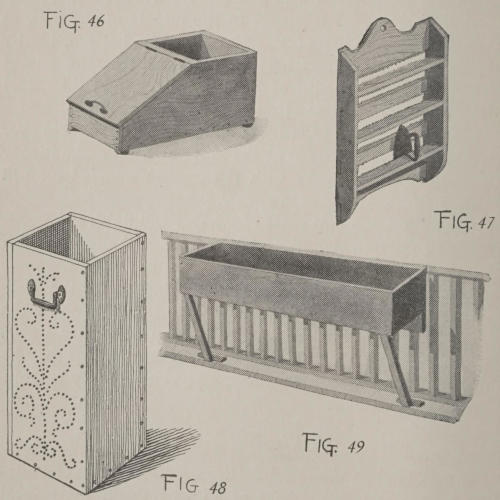
Fig. 46. Fig. 47. Fig. 48. Fig. 49.
The shelves are two inches wide and eighteen inches long. They are spaced eight inches apart, having the front edge flush with the edge of the side-plates, and leaving a space[35] two inches wide from the rear edge to the wall. Wall-plates two inches wide are let into the rear edge of the side-plates two inches above the shelves. Against these the bottom of the irons will rest.
A top and a bottom board, cut as shown in the illustration, are to be attached to the wall-plates, and the complete rack of shelves should be fastened to the kitchen or laundry wall with stout screws set firmly into the studding.
Two coats of olive-green or brown paint will finish this holder nicely, or it may be painted any color to match the wood-work in the kitchen or laundry.
An umbrella-stand does not occupy much space, and it is a convenient receptacle for umbrellas, canes, ball-bats, and golf-clubs (Fig. 48).
To make one it will require four pieces of clear pine or white-wood thirty inches long, ten inches wide, and half an inch in thickness. There is also a bottom board nine and a half inches square and seven-eighths of an inch thick, to which the lower ends of the boards are to be screwed fast. A high, narrow box is to be formed of the boards, one side of each board being attached to the edge of the next one, as the illustration shows. Shellac or varnish will give the wood-work a pleasing finish, especially if it is white-wood, cypress, or spruce.
A design may be worked out on one side with large oval-headed hobnails painted black. These may be purchased at a shoemakers for a few cents a paper. The design should[36] first be drawn on thin brown paper and held on the wood with pins. The nails are driven along the lines of the ornament, but before they are hammered home, the paper should be torn away so that none of it is caught under the nail-heads.
A zinc tray six inches high, and made to fit in the bottom of the box, will hold the drippings from wet umbrellas. Rings soldered at the top edge of the tray will permit it to be removed for cleaning.
For growing plants and flowers that always look well around a piazza rail, the plant-box shown in Fig. 49 will be found useful. One or more boxes may be made from pine boards an inch thick and eight inches wide. The boxes should be six inches deep, outside measure, and they may be as long as desired to fill the spaces between the piazza posts.
Straight or box joints are made at the corners and fastened with screws. The inside of the boxes should be treated to several successive coats of asphaltum varnish to render them water-proof. Several small holes must be bored in the bottom of each box to drain off surplus moisture, and the boxes and supports may be painted a color to match the trimmings of the house.
To anchor the boxes, screw a batten to the balustrade, on which the inner edge of the box may rest. The outer edge is supported by means of braces attached firmly to the underside of the box and to the piazza floor, as shown in[37] the illustration. Two small brackets attached to the underside of the box and to the batten will hold the box in place and prevent it from slipping off the top of the batten.
The few objects shown and described in this chapter are, of course, but a small part of the things a wide-awake boy will think of and wish to make. The principles involved in these examples, however, will apply to scores of other things that may be constructed. Once these simpler forms of workmanship are mastered the young craftsman will go forward naturally to the higher exercise of his art. Carpentry is a fascinating occupation, and it is well worth while, since its results are of practical use and value.
A knowledge of drawing and modelling will be most helpful to the young carver, as then the outline of ornament can be readily drawn, while to carve objects from wood the art of modelling form is most desirable.
If the beginner possesses a knowledge of form acquired by drawing and modelling, the art of wood-carving may be readily and quickly mastered; but even if these advantages should be lacking, it is possible that considerable progress can be made by those who will follow the instructions given on these pages.
The most important feature of carving is the ability to sharpen and maintain the little tools, and when this is mastered, more than half the difficulty has been overcome. The dexterity to handle, with a firm and sure hand, the various chisels and gouges comes, of course, with practice only.
It is better to begin with a soft wood. Pine, poplar, button-wood, cypress, or red woods are all of close grain and are easy to work. The harder woods, and those with a very open grain—such as chestnut, ash, and oak—should[39] not be carved until the first principles are learned in the softer woods.
Carving takes time, and it is not an art that can be quickly mastered, unless it be the chip-and-line variety. But this last can hardly be compared to the more beautiful relief-carving, with its well-modelled form and undercutting.
A boy may learn the first principles of carving, using only his small, flat carpenter’s chisels and gouges; but for more advanced work he will need the regular carving-chisels. These latter are sharpened on both sides, while the carpenter’s chisels are ground on one side only. Nevertheless, some very good work has been done by boys who had nothing better than a small gouge, a flat chisel, and a penknife. The true artist can work in any material and with the most indifferent of implements.
At the start a numerous assortment of tools will not be necessary, as the flat work and chip-carving will naturally be the first department of the art to be taken up by the young carver.
Six or eight chisels constitute a good set, and those shown from Fig. 1 to 6 will answer very well. Fig. 1 is a plain, flat chisel with a straight edge, as shown at A; it is commonly called a firmer. Fig. 2 is also a flat tool, but possessing an angle or oblique edge; it is commonly called a skew-firmer. Figs. 3 and 4 are gouges. Fig. 5 is a V gouge, and Fig. 6 is a grounder. G, H, I, J, and K are gouges of various circles. L is an angle, or V, gouge. M, N,[40] and O are gouges of various curves, and P, Q, and R are V gouges of various widths and angles. These last are used for furrows, chip-carving, and lining.

A Fig. 1.
B Fig. 2.
C Fig. 3.
D Fig. 4.
E Fig. 5.
F Fig. 6.
G H I J K L M N O P Q R
A flat felt or denim case should be made for the tools, so[41] that they may be kept in good order. It is made of two strips of the goods, one wider than the other. Two edges are brought together and sewed, and lines of stitching form pockets for the chisels. The flap left by the wider strip of goods is folded over the chisel ends, and the pockets containing the tools may be rolled up and tied with tape-strings. When opened it will appear as shown in Fig. 7. The edges of chisels kept in this manner are insured against injury and rust, since the case protects them from atmospheric moisture.
The stones needed for sharpening the tools will be an ordinary flat oil-stone (preferably a fine-grained India stone), and two or three Turkey or Arkansas slips, four or five inches long, having the shapes shown in Fig. 8. A, with the rounded edges, is for the gouge tools; B, with the sharp edges, is for V-shaped tools; and any of the flat chisels may be sharpened on the regular oil-stone, C.
In Fig. 9 end views of some slips are shown. A and B are round-edged slips for gouge-chisels; C and D are angle stones for V chisels; while small, flat tools may be finished on the sides. These stones are held in the hand, and lightly but firmly rubbed against both surfaces of a tool to give it the fine cutting edge.
In Fig. 10 an oil-stone in a case is shown. A boxed cover fits over it and protects it from grit and dust. This is important, for often a little gritty dust will do more harm to the edge of a fine tool than the stone can do it good.
The other tools necessary to complete the kit will be several clamps, similar to those shown in Figs. 11 and 12, and a fret-saw (Fig. 13). If you happen to possess a bracket-machine[42] or jig-saw the fret-saw will not be necessary. A glue-pot will also be found useful.
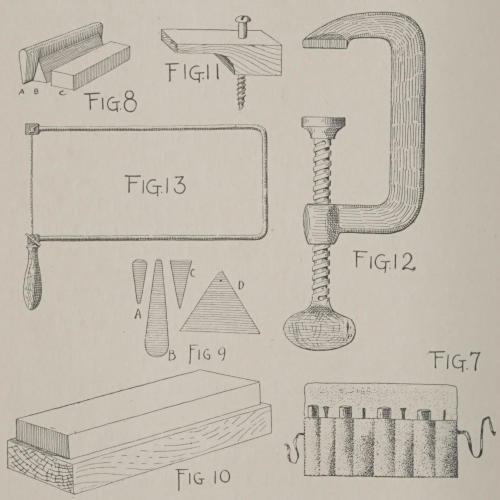
Fig. 7. Fig. 8. Fig. 9. Fig. 10. Fig. 11. Fig. 12. Fig. 13.
The first essential to good, clean cutting is that the tools shall be absolutely sharp and in a workmanlike condition. It is often the case that an amateur’s tools are in such a state that no professional carver could produce satisfactory results with them. And yet the variety of carving tools is[43] so limited that if the difficulties of sharpening a firmer and gouge are mastered the task is practically ended.
If the tools should be unusually dull they must first be ground on a grindstone, and as carvers’ tools are sharpened on both sides, they must be ground on both sides. The firmers may be sharpened on the oil-stone laid flat on the bench, but the gouges must be held in the hand, in order to sharpen the inside curve with a slip. The outer curve can be sharpened on the flat oil-stone, or held in the hand and dressed with the flat side of a slip. Great care must be taken to give the tools a finished and smooth edge. When they have reached the proper degree of sharpness it will be an easy matter to cut across the grain of white pine, leaving a furrow that is entirely smooth and almost polished.
In the use of the oil-stone and slips, neat’s-foot oil, or a good, thin machine oil, should be employed. Astral oil is too thin, but the oil sold in small bottles for sewing-machines or bicycles will answer every purpose. Water should not be used, as it would spoil the stones, and not produce the sharp edge on the tools.
The finest stones are the best for use, and although they take longer to give the keen edge required, they will be found the most satisfactory in the end. Avoid grit and dust on the stones, and before using them they should be wiped off with an oiled rag. The beginner must not consider any pains too great to make himself thorough master of the tools, and to keep a perfect edge on all of them.
The tools being in proper condition, the next step is to acquire a knowledge of the best methods of handling them.[44] It will require some time and practice to become thoroughly familiar with the manner in which tools are used, and, if it is possible, it would be well to watch some carver at work.
The chisels should always be held with one hand on the handle, with two fingers of the other hand near the edge of the tool. This is to give sufficient pressure at the end to keep it down to the wood, while the hand on the handle gives the necessary push to make the tool cut.
A carver’s bench is a necessity for the young craftsman, but if it is not possible to get one, a heavy, wooden-top kitchen table will answer almost as well. The proper kind of a bench gives greater facility for working, since it is more solid and the height is better than that of an ordinary table. Any boy who is handy with tools can make a bench in a short time of pine or white wood, the top being of hard-wood. If the joiner-work is not too difficult to carry out, it would be better to make the legs and braces of hard-wood also, to lend weight and solidity to the table.
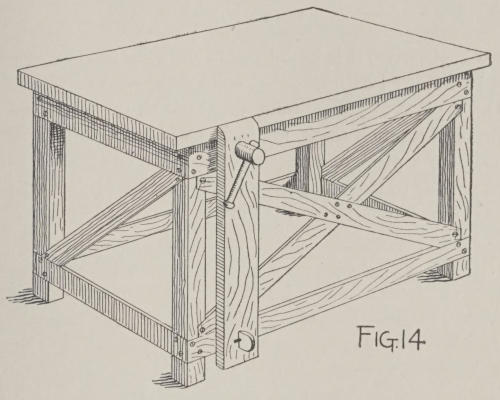
Fig. 14.
The wood should be free from knots and sappy places, and as heavy as it is possible to get it, so as to make a really substantial bench. The top should measure four feet long and thirty inches wide, and not less than one inch and a half in thickness. The framework must be well made, and the corner-posts and braces securely fastened with lap-joints, glue, and screws. The top of the bench should be thirty-nine inches high, and to one side of the bench a carpenter’s[45] vise may be attached, as shown in Fig. 14. The jaw of the vise is seven inches wide, one and an eighth inches thick, and thirty-four inches long. It is hung as described for the carpenter’s bench (see Carpentry, Chapter I.). A wood or steel screw may be purchased at a hardware store, and set near the top and into the solid apron side-rail. The posts are four inches thick, and the cross-pieces and rails should be of seven-eighth-inch hard-wood four inches wide. The top overhangs the framework two inches all around, thus forming a ledge, to which the plates of wood or panels may be bound with the clamps and bench-screws. Where a clamp cannot be used, a cleat, as shown in Fig. 11, is screwed fast to the top of the table, and the projecting ear catches the edge of the wood and holds it securely.
A coat of varnish or paint on the legs and braces will finish this bench nicely, and it will then be ready for the young workman’s use.
To begin with, it is best to work on a simple pattern that can be followed easily.

Fig. 15 A.
Get a piece of yellow pine, white-wood, or cypress seven-eighths of an inch thick, six inches wide, and twelve inches long. On a piece of smooth paper draw one-half of a pattern similar to the one shown in Fig. 15 A; or you may use any other simple design that is free in line and open in the ornament. Upon the wood lay a sheet of transfer-paper, with the black surface down, and on top of the transfer-sheet the paper bearing the design. Go over all the lines with a hard lead-pencil, bearing down firmly on the point,[47] so that the lines will be transferred to the wood. Turn the design around and repeat the drawing, so that the wood will bear the complete pattern. Clamp the wood to one side or corner of the bench with three or four clamps. Do not screw the clamps directly on the wood, but place between the jaw and the wood a piece of heavy card-board, or another piece of thin wood, to prevent the clamps from bruising the surface of the panel.
First, with a small V, or gouge-chisel, cut the lines; after that the leaves, using a flat, or spade, chisel. Two curved incisions will shape out the leaf, and the angle through the centre describes the main vein. The chipping may be shallow or deep, as a matter of choice, but more effect may be had by cutting fairly deep.
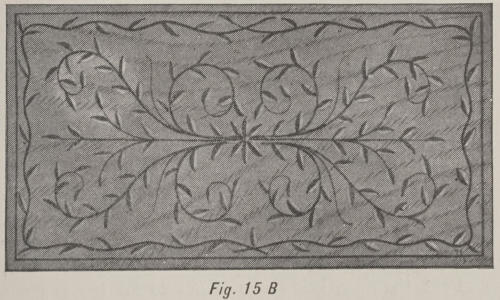
Fig. 15 B.
The finished result will appear as shown in the illustration of the chip-carved panel (Fig. 15 B). For light ornamenting or drawer-panels, fancy boxes, and picture-frames,[48] this form of carving may be made both pleasing and effective. Moreover, its mastery leads naturally to the more artistic relief-carving.
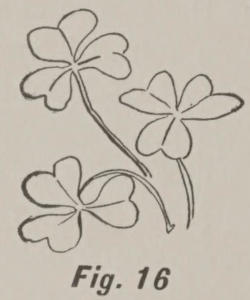
Fig. 16.
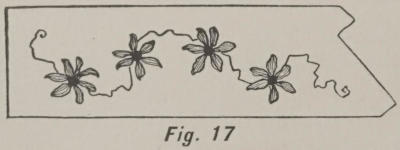
Fig. 17.
Get one of the little nickel-plated clocks (sold at sixty cents and upwards). Lay it down on a smooth piece of soft wood—pine or cedar—about seven by eight inches. Mark around it closely with a lead-pencil, and cut out the circular opening with your knife. If you happen to have a fret-saw or suitable tools, you can make it of hard-wood. Smooth nicely with sand-paper. The clock must fit closely into the opening. You will find Fig. 16 very easy to do. Cut out the lines, being careful not to let the tool slip[49] when cutting with the grain. Dilute the walnut stain with turpentine, and paint the design inside the lines; the grooves prevent the color spreading. Let it dry. The next day, with a wad of cotton or piece of canton flannel, rub on some varnish. Soft wood absorbs it very rapidly at first until the pores are filled. When quite dry, sand-paper nicely. Then rub again with varnish, a little at a time. Keep raw linseed-oil near you in a cup; dip one finger of your left hand in this when the work becomes sticky, and apply to the pad; it helps to spread the varnish. Rub briskly with a circular motion. The varnish will dry quickly, when it must have a final polish; this brings out the beauty of the grain. If carefully done, your work will resemble inlaying.
The daisy design (Fig. 17) is charming when finished, and has the additional merit of being easy. Cut the daisy form from a visiting-card, and mark around it. Stain the centre much darker than the petals.
Table-tops, jewel-boxes, calendar frames, chairs, etc., may be purchased already polished, and outlined in some dainty pattern. A finer tool (No. 11, 1/64) comes for this kind of work. Of course it cannot be stained, but if desired the background may be stamped with a star-pointed “marker” to give the design prominence.
These patterns may be adapted for the decoration of glove-boxes, bread-plates, knife-boxes, stools, blotting-books, card-cases, match-boxes, music-portfolios, and many[50] other things, which will sell well at fancy fairs, or be highly appreciated as presents.
Relief-carving differs from the chip work in that the ornament is raised instead of being cut in. Solid relief-carving, such as appears on panels, box-covers, and furniture, is produced either by cutting the background away or by carving the ornament separately and then gluing it onto the surface of the article to be decorated. Of course, this latter process is only a makeshift, and the first method is the really artistic one.
It is best to begin with something simple and then go on to the more complicated forms of ornamental work. A neat pattern for a long panel is shown in Fig. 18 A. This panel is twelve inches long and four and a half inches wide.
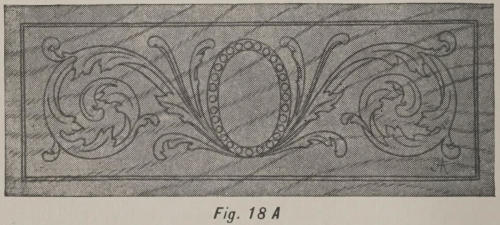
Fig. 18 A.
On a smooth piece of paper draw one-half of the design and transfer it to the wood, as described for the chip-carved panel. Clamp the wood to a corner of the bench and, with[51] a small wooden mallet and both firmer and gouge-chisels, cut down on the lines and into the face of the wood. Then, with the gouges and grounding-tool, cut away the background to a depth of one-eighth of an inch or more, until a result is obtained similar to that shown in Fig. 18 B. The entire design and edge of the panel will then be in relief, but its surface will be flat and consequently devoid of artistic feeling. With the flat and extra flat gouge-chisels begin to carve some life into the ornament. A little practice will soon enable the young craftsman to observe which parts should be high and which should be low. The intermediate surfaces should be left neutral, or between high and low relief. This finishing process depends for its effect upon the good taste and feeling of the craftsman; it is the quality that gives artistic beauty and meaning to the work. The panel, when completed, should have the appearance shown in Fig. 18 C.
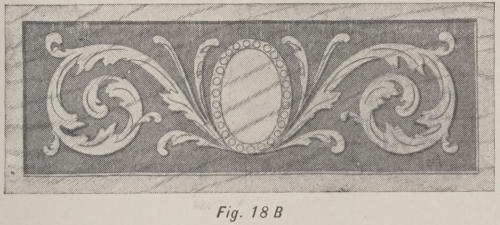
Fig. 18 B.
As already stated, the general effect of relief-carving may be also obtained through the “applied” method, a simpler[52] and less tedious process, but neither so artistic nor so substantial.
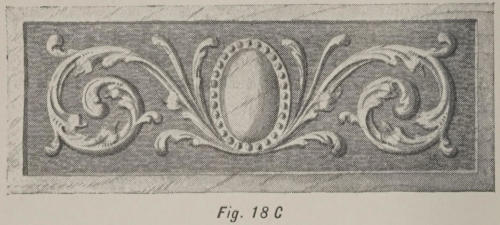
Fig. 18 C.

Fig. 19 A.
The design is transferred to a thin piece of wood and cut out with a fret or jig saw. Fig. 19 A shows a suitable pattern for this class of work. The pieces are then glued in position on a thick piece of wood, and the “feeling” carved in after the fashion already indicated. This “applied” carving may be used on the panels of small drawers, cabinets, and boxes of various sizes and shapes. The inventive[53] boy will be able to design patterns for himself, or they may be cheaply bought. Fig. 19 B shows the effect of the finished work.

Fig. 19 B.
In Fig. 20 some designs are given for carved mouldings, and at the side, end views are shown.
Plain mouldings of various shapes may also be bought at a mill, or from a carpenter, and may be given “life” with a little care and work. Both hard and soft wood mouldings are available, but at first the softer woods will be found the easier to work.
A plain corner on a wooden picture-frame may be built up with blocks of wood glued on as shown in Fig. 21 A. When carved this piece will have the appearance of the finished corner shown in Fig. 21 B. The arms of chairs, corners of furniture, and the like may be treated in this same manner.
When flat and relief carving have been mastered, it would be well to attempt something in figure and free-hand work, such as animals, fruit, or heads. But it will take a good[54] deal of practice on the simple and conventional forms before the amateur will feel himself competent for the more advanced art. As improvement in the flat work is noticed, the ornament may be “undercut” to give it richness and boldness.
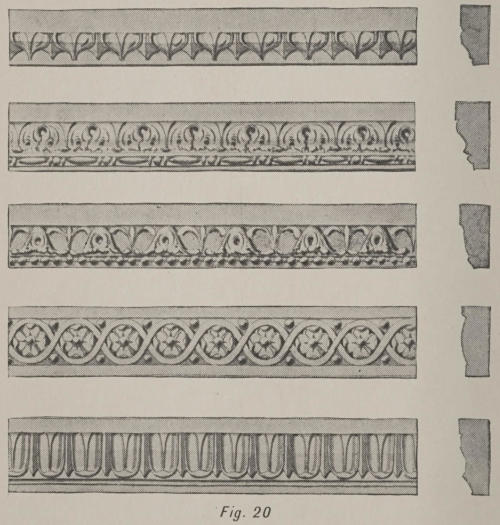
Fig. 20.
To finish wood in any desired color, stains may be purchased[55] at a paint or hardware shop. Over the stained surface, when dry, several thin coats of hard-oil finish or furniture varnish should be applied. The back and edges of a carved panel must always be painted to protect them from moisture and dampness; warping and splitting are thereby avoided. Some pieces of carving need only a coating of raw linseed-oil, while others may be treated to a wax finish composed of beeswax cut in turpentine, rubbed in with a cloth, and polished off. Another method of darkening oak (before it is varnished) is to expose it to the fumes of ammonia, or to paint on liquid ammonia, with a brush, until the desired antique shade is obtained. The staining process, however, is preferable.
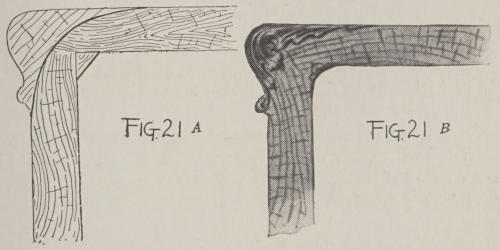
Fig. 21 A. Fig. 21 B.
Nearly every boy has had, at one time or another, a desire to make scroll-brackets, fretwork-boxes, and filigree wood-work of various sorts. The art is naturally affiliated with other decorative processes in wood-working, such as wood-turning, carving, and marquetry, or the art of inlaying woods. Both fretwork and wood-turning are very old crafts, and were practised by the ancient Egyptians, specimens of their work being still extant.
A great deal of amusement and pleasure may be had in the possession of a scroll-saw, or “bracket machine,” as it was commonly known among boys some years ago. And first, as to the implements required.
To those who can go to the dealer and pay for just what their fancy dictates, there is no trouble to procure all the tools that may be needed for the finest work; but others who cannot afford this luxury may get along nicely with a very small outlay. In fact, in nearly every instance known to the writer where the amateur has really rigged up his[57] own machine, he has become master of the art sooner. A number of years ago the writer, then a school-boy, transformed an old sewing-machine table into a scroll-saw and lathe, and to-day this homely old stand and crudely put together machine does as good work, with as little effort, as the finest and most expensive outfit. This machine, all complete, with the drilling attachment, cost: old machine, one dollar; dozen saws, assorted, twenty-five cents; new material, rivets, etc., sixty-five cents; drills (still in use), fifteen cents; total, two dollars and five cents.
This money was saved from building fires and taking up ashes, and the first time the saw was run—one cold, stormy day in late November—there was cut up material which, when put together and sold (playmates and school-fellows being the customers), amounted to over three dollars in cash, besides a few pocket-knives, bits of rare wood, and the like that were taken in exchange.
Making a fine scroll-saw from a sewing-machine is of itself an easy matter. The balance-wheels should be retained, in order that all back lash can be easily overcome. The two arms holding the saw are to be geared from some wheel in the rear or connected with a belt. If the wrist-pin (the crank, or pitman wrist) gives too long a motion, it can be easily taken up by either drilling another hole nearer the centre or using a bent crank-pin. In any event the cut should not be over one inch.
Another method of shortening the stroke (and a very good one if the means of making the other changes are not at hand) is by changing the bearing of the arm. The nearer the saw the shorter the stroke. The clamp-screws holding[58] the saws should be adjustable, so that either a long or a short saw-blade may be used. Those who break their blades (and there are none who do not) will find great economy in using adjustable clamps, as the short pieces can be used for sawing thin stuff, veneers, and the like. The best kind of clamp is provided with a slit to receive the blade and a set-screw for tightening.
The tools necessary for hand-sawing are very simple and inexpensive, consisting of a wooden saw-frame, one dollar; dozen saw-blades, twenty cents; one clamp-screw, twenty-five cents; drill and stock, fifty cents; total, one dollar and ninety-five cents.
In selecting saw-blades be careful to buy only those with sharp and regular-cut teeth. Saws are graded by number for hand-sawing. Numbers 0 and 1 are the best sizes, unless for very delicate work, when finer ones should be used. The larger blades have coarse teeth, which are liable to catch in the work and tear it. Since, at the best, the motion of the hand-saw is jerky, not nearly so nice work can be done as with the treadle-saw, which has an even, steady gait.
For all open-work it is necessary to have something to punch holes, so that a start may be made on the inside. Many use an ordinary brad-awl, but this is liable to split the wood. Besides, it is not possible to punch a hole so smooth and nice as it can be drilled or bored; hence, a drill is included in the list, and it will be found a very handy tool for either hand or treadle saws. The most serviceable article of this kind is the small German drill-stock, that can be bought with six drill-points, assorted sizes, for fifty[59] cents, or the small hand-drills, with side wheel and handle, and provided with a small chuck to clutch the drill.
From what I have said, it should not be inferred that any objections are made to any of the beautiful little machines now to be bought at moderate cost. By all means, when the expense can be afforded, these should be used. The good ones will do the most delicate work, can be run with great ease, and will cut from eight to twenty pieces at a time, according to the thickness of the wood, leaving the edges of the work perfectly smooth. In using treadle-machines, insert the saw-blades with the teeth pointing downward and towards the front of the machine, and guide the wood easily with the fingers, with the wrists resting firmly on the table, being careful not to feed too fast or crowd against the saw sideways. Otherwise the blades will be heated and broken, and they will wear away the little wooden button set at the centre of the plate to prevent the saw from touching the metal work-table.
Most boys know how to run a scroll-saw, or think they do, yet a few practical hints should not come amiss.
To begin with, the machine should be well oiled, all nuts, screws, and bolts turned up tight, and the belts adjusted at sufficient tension to run at a high rate of speed without slipping. Many machines, even in large mills, are groaning and filing out their journals and bearings simply because the belts are too tight. One of the first principles to be mastered in applied mechanics is that of power transmission,[60] and right here the young workman has the best of opportunities to solve, in a measure, a great mechanical problem—namely, a belt tight enough to drive the machine and do the work, and loose enough to run easy and cause no unnecessary friction or wear on the journals and boxings.
For your first practice take some cigar-box wood (of which a good stock should be kept), and trace upon the dark sides a series of angles and curved lines. Never, under any circumstances, begin sawing without a tracing, or a pattern of some kind, to saw to, for now is the time to cultivate habits of accuracy. With no design or objective-point, nothing but a bit of useless board will result; besides, you will form a habit of working without a guide, a habit that has made more poor artisans than the love of idleness and bad company. Lay the wood on the rest, or plate, and see that it lies solidly. If it shakes, the wood is uneven and should be straightened, for no one can saw a warped board and make accurate work; besides, it is impossible to work in such wood without breaking the saws. The wood being level, hold it down with the left hand, fasten securely a No. 1 blade in the frame, and begin sawing, being careful to keep the motion very high and feeding slowly, sawing out the tracing lines, or keeping close to one side of them. If an ordinary hand-frame is used, work it firmly in one direction, keeping the blade perpendicular, and turning the wood so that the saw may follow the pattern.
After you have thoroughly learned the motion of the machine, the cutting of the saw, feeding, etc., try sawing a straight line, being careful not to push or crowd the blade sideways, as this will not only make the lines crooked, but[61] will heat and ruin the blades, if it does not break them. When you have become an adept in following a straight line, and cutting the lines of a curve accurately, mark out several Vs and squares. To saw a V begin at the upper end and saw down to the point; now back the saw out, and saw from the other end down to the same point. If the line is carefully followed, this will insure a sharp, clean-cut angle. To cut out a square hole, saw down to the angle, then work the blade up and down in one place rapidly until it becomes loose; then turn the wood at right angles and saw carefully along the line to the other corner, when the operation may be repeated. Just as soon as you can saw straight and curved lines true to tracings, it is safe to begin good work with little if any fear of spoiling lumber or breaking an undue number of saws.
One of the simplest objects for a beginner to try his skill upon is a wall-bracket such as shown in Fig. 1. A piece of cedar—the bottom and lid of a cigar-box will answer the purpose excellently—from seven to eight inches in length by six and a half in width is a convenient size. The shelf is a semicircular piece either plain or scalloped in front, and its support must be of light, open, but strong design to match one-half of the lower design to the wall-plate. Hinges are sometimes placed to all parts in order to make it easy to pack the bracket. But such additions can only be made by the expert craftsman.
The first thing to be done is to trace the design on a thin[62] piece of paper after it has been drawn roughly on a smooth sheet of brown paper. When the tracing is complete, lay it face downward, and cover it with powdered red chalk. The tracing is then imposed on the wood, with the red side downward. With a blunt bodkin or lead-pencil we now draw firmly along the lines, thus reproducing the tracing on the surface of the wood. Having accomplished this, we remove the paper, and with pen and ink make a complete drawing of the outlined design on the wood.
In designing fretwork great care must be taken to get the two sides of the pattern alike and in correct drawing. This can best be done by drawing the design on tracing-paper, and doubling it over when, with a little extra pressure of the pencil, a good design can be obtained on both sides of the paper.
When this has been accomplished pierce the wood at various points with a drill. The holes thus made are to allow the saw to enter. The wood may now be put in the clamp. Then with a moderately strong saw the young beginner can make his first attempt. The frame must be held perfectly straight and the arm worked steadily up and down.
Turning the saw is always a difficult point with amateurs, but in reality there is but little in the operation that cannot be mastered with a few moments’ practice. The secret of turning neatly and without damaging either saw or wood is to work very steadily up and down, but not forward, when the turning-point has been reached. Then by a sharp and active movement of the wrist and wood the saw should be turned, but not jerked, and the new line[63] commenced. Sometimes, however, the delicacy of the pattern makes this impossible. The saw should then be pulled backward and forward gently until a sufficiently large hole has been made.
It is impossible, within the limits of this chapter, to give designs for any considerable number of the articles that can be made in fretwork; but with the descriptions just given, and the few accompanying patterns, a boy who has any idea of drawing and designing can put parts of an ornament together and so work out new and attractive variations.
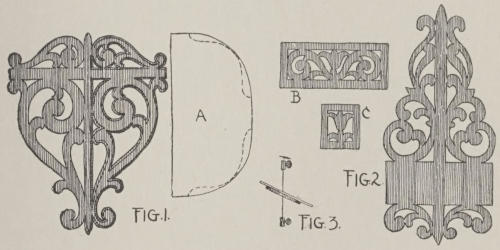
Fig. 1. Fig. 2. Fig. 3.
The design for a match-safe is shown in Fig. 2, the wall-plate measuring two inches and a half in width and seven inches high. One side of the pattern should first be drawn in free-hand, then traced and transferred to the thin wood and the lines gone over with a sharp-pointed, hard pencil, so that it will be an easy matter to see them when sawing.
The front plate of the match-safe is shown at B and one end at C. The front is two and a half inches long and one inch wide, and the ends are made in proportion, or about seven-eighths of an inch wide. These parts are put together with slim steel nails and glue, having first drilled the holes where the nails are to be driven to prevent them from splitting the wood.
Most of the modern scroll-sawing machines have movable beds, so that bevel cuts can be made. This is done by tilting the bed or table slightly, as shown in Fig. 3. As a result the work will have a narrower face than the back, as shown at the right side of the bracket in Fig. 1. However, in making the front, or bracket part, there should not be any bevel-cutting, since it would look one-sided. Keep the bed flat in that case, and make the regular cuts for straight work.
The simple bracket shown in Fig. 1 is an easy one to draw, and it may be cut from holly, birch, oak, or any good wood about one-eighth of an inch in thickness. The bracket or front-piece is half the back-plate, omitting the top ornament. The shelf (A) may be rounded, scalloped, or cut serpentine, as indicated by the dotted lines, and the three parts are put together with fine nails, or screws, and glue.
For a glove or necktie box an attractive design is shown in Fig. 4, A being the top and B the front or back. The ends should be made a proportionate size, and a part of the traced ornament can be transferred to them, so as to match the other parts.
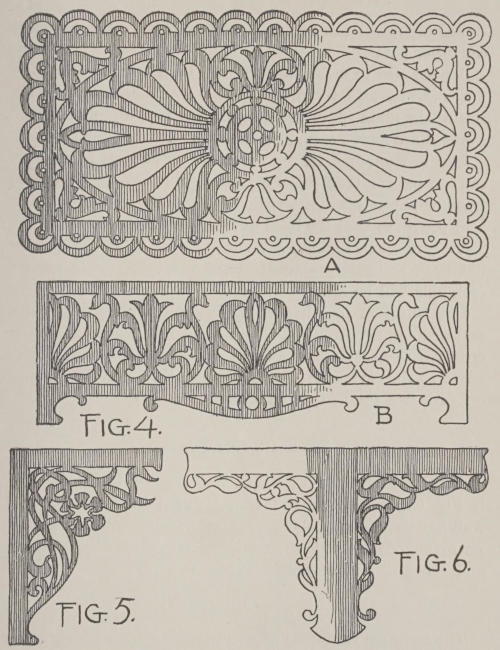
A GLOVE-BOX AND A T BRACKET
Fig. 4. Fig. 5. Fig. 6.
A good size to make this box will be ten inches long, five inches wide, and three inches deep. This should be the size of the main rib or rectangle in the top, and out from it the scallops project three-quarters of an inch all around.
Lay out one-quarter of the cover design on a piece of smooth paper; then make a tracing of it. With a piece of transfer-paper this quarter should be gone over with a blunt lead-pencil, so that the lines will be transferred to the wood. Take care when making a transfer to see that the quarter has been accurately placed on the wood so that a perfect rectangle will be had.
Put this box together with glue and small, slim nails, and arrange a bottom of thin wood to fit where the lower cross-rib of the sides is shown. If the saw leaves ragged edges at the reverse side of the wood, they may be cleaned off with fine sand-paper or a small file.
Another design for a bracket is illustrated in Fig. 5; and in Fig. 6 a T is shown that may be used for a bracket or a wall-hanger, along the top edge of which small hooks may be arranged to hold a shoe-horn, button-hooks, scissors, and other small bedroom accessories.
The common examples of wood-turning with which a boy is most familiar are tops, balls, bats, dumb-bells, Indian[67] clubs, broom-handles, and spools. All of these objects are made in a lathe, and this is the self-same machine that has been in use for centuries, with but few modifications. Like the potter’s wheel, it is simplicity itself and needs no improvement.
The object of a lathe is to cause a piece of wood or other material to revolve from end to end, so that when a chisel or other sharp-edged tool is held against the moving surface it will cut away that part of the material at which the tool is directed.
The boy who lives near a wood-working establishment, or mill, can gain more knowledge in watching a wood-turner at work for half an hour than he can learn from reading a book on the subject for many days. It is a simple craft, but a firm hand and a true cut are the important factors in making a boy a master of the lathe.
Once the knowledge is gained, however, it is an easy matter to turn all sorts of objects.
A simple lathe may be made from a small table, a grindstone, a trunk-strap, and several small parts that are easily gotten together. Read how in his boyhood days the author constructed a small lathe.
Between the legs of a table two bars were nailed across for supports to the shaft, which was made of oak and measured three feet long and one inch square. This just fitted the hole in a grindstone that was used for the balance-wheel. Six inches from the ends of the shaft the corners were cut away to form bearings on the cross-bars, which were hollowed out to receive it. A leather strap was nailed over to keep it in position. The grindstone was next placed[68] on the shaft, near one end, between the bearings, and wedged. Over it two brackets, four inches high, were screwed in position on the table top, six inches apart, forming a support for a shaft of a small wheel or pulley made of wood. In the end of an ash shaft, one inch square and eight inches long, were three sharp points made by driving in nails without heads, the projecting ends being filed to points; these, forced against the block, held one end firmly enough to turn. The places where the bearings came were cut in the form of a cylinder three-quarters of an inch in diameter, and corresponding places were hollowed in the supports (as shown at Fig. 8) to receive it, a small piece of wood being screwed on over each, after the shaft and wheel were put in position.
A belt was made of an old trunk-strap, passed round the grindstone and through two holes in the table over the little wheel, causing the latter to revolve very rapidly when the former was turned. This was done by a treadle put in the following manner: Two cranks were made (A in Fig. 7) by a blacksmith and attached to the ends of the long shaft. They were three inches long and had a knob on the end of the handle to prevent the connecting-rods from slipping off. The latter were of hard-wood, with a half-inch hole bored through near one end. They were then split six inches, allowing them to be placed on the handles. A screw was then put in to secure them, the lower ends being connected with a treadle made as in Fig. 7.
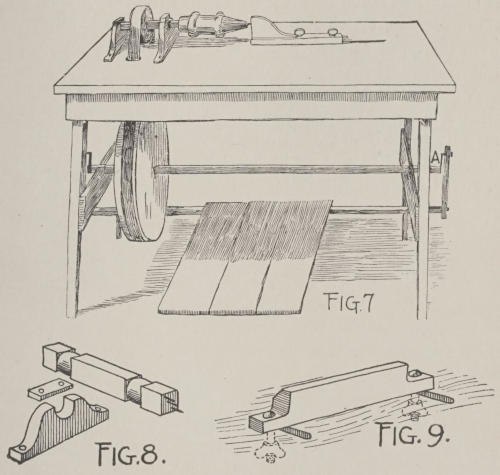
Fig. 7. Fig. 8. Fig. 9.
The second spindle at first was made immovable by inserting a piece of quarter-inch wire in a wooden bracket, which was screwed to the table; but finding it not always[69] convenient to use blocks of the same length, one was arranged to slide; it could be secured in any position with thumb-screws. A long cut a quarter of an inch wide was first sawed in the table in the line of the short shaft; then a bracket three inches high was screwed to a short strip two inches wide, one inch thick, and a foot long. A similar strip was placed beneath, through which two thumb-screws passed. A piece of wire, filed to a point and driven in[70] the bracket, served for a centre. A movable block of wood three and a half inches high was used for a tool rest, which by means of two small bolts and thumb-screws was held fast to the table top. Slots cut in the table top made it possible to move this rest forward or backward, and the thumb-screws, or winged-nuts, as they are properly called, were tightened at the under side of the table, as shown at Fig. 9.
A great deal of pleasure may be had at little or no cost with a lathe of this description. All sorts of small things may be turned, and when a boy has mastered the craft it would be well to add an iron lathe to his stock of tools, if the cost is at all within his means.
The modern idea in framing pictures is to have the frame harmonize with the subject, rather than to employ a stock moulding with set pattern made by the mile, and cut up into frames of all sizes and for all sorts of pictures. All the frames shown in the illustrations accompanying this chapter were made at home, and from such simple materials as thin boards, burlap, tea-chest matting, denim, wire, sheet-lead, harness-rings, and brass-headed upholsterers’ tacks.
For the study of a Dutch head a unique frame, or mounting, is shown in Fig. 1. This is a board of thin wood of a size in proportion to the photograph, the latter being nailed to the board with large, oval-headed tacks painted black.
The board is covered with green denim, the edges of which are drawn over the back of the board and glued, or fastened with small tacks. The photograph, a platinum print, is trimmed to an oval, and then mounted on a white card. When the paste is dry the mount is also cut ovalwise, following[72] the line of the photograph, and leaving a white margin half an inch in width. The picture is placed on the board so that the side and top margins will be equal; it is then fastened in place with upholsterers’ tacks driven three-quarters of an inch apart.
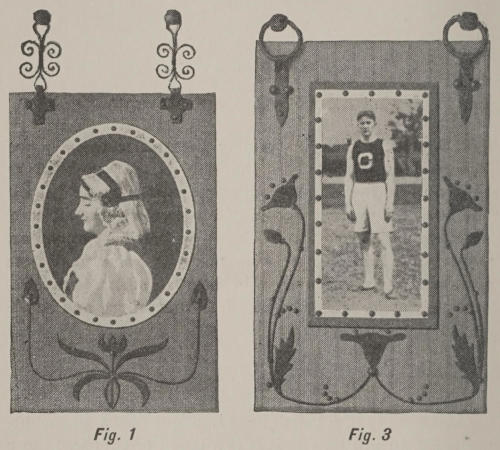
Fig. 1. Fig. 3.
These nails, as well as the other metal-work, are to be coated with a mixture of dry lamp-black and shellac before they are driven on the board. The nails should be painted some time before they are to be used, so that the black coating will be thoroughly dry. After the nails are driven[73] in place it may be necessary to go over them with a small brush and some of the black paint, to touch up places where the coating has chipped off.
The ornament below the picture and the hanger-straps are cut from sheet-lead about one-sixteenth of an inch in thickness. The stems are of ordinary iron wire, such as may be purchased at a hardware store for a few cents. Each piece of the design is separate, and may be easily cut from soft lead with an old pair of shears, and afterwards trimmed with a pocket-knife or a small file.
Drawings of the metal parts to this frame are shown in Fig. 2. A is the strap at the top, where the hanger is attached; B, the scrolls forming the hanger; C, one of the buds at the top of the stem of wire; D, the flower at the middle of the frame under the picture; E, one of the long leaves; and F, a shorter curved one. These are all painted black before they are applied to the board; then they are caught with large and small nails, the large ones for effect, the small and invisible ones to securely attach the metal ornaments to the wood.
Small staples made from pins with the heads cut off are used to hold the wire stems in place, but at the outer ends the wire is caught under the buds or flowers, where it is held in place with an upholsterer’s tack.
The ornamental hangers are made from thin strips of stove-pipe iron one-quarter of an inch wide, and may be shaped with a small pair of pliers or bent with the fingers. (See Chapter V., Venetian and Florentine Metal-work.) The long upper part of the strap-pieces are bent over and caught at the back of the frame, and form a staple,[74] into which the lower loop of each hanger is made fast.
If the large, oval-headed nails which hold the picture to the board cannot be had at your hardware store, imitation heads may be cut from lead, blackened, and fastened on with two or three fine steel-nails.
The mounting shown in Fig. 3 is constructed along the same lines as that of Fig. 1, but the hangers are different, and the picture, having a white edge, is mounted on a dark card. The nails are then driven on the white band, in order to make them more conspicuous than they would be if fastened on the outer margin.
A line may be drawn on a piece of smooth brown paper indicating the size of the frame, and another one to denote the location of the picture. The design should then be drawn on the paper with lead-pencil, and the little flowers, buds, and leaves fitted to this plan. The wire may also be bent to conform to the lines of the drawing, so that it will be an easy matter to apply the accurately fitted parts to the frame, where they are fastened with small, oval-headed tacks.
A strip of sheet-lead five inches long and one-half an inch wide is cut V-shaped at the bottom, and the top is bent over a two-inch harness-ring, then drawn down and fastened with a nail, to prevent it from releasing the ring. These hangers are fixed at the top, midway between the picture and the outer edge of the frame. Large-headed[75] wrought-iron bellows-nails are used on which to hang the picture; they are driven into the wall, and, when necessary, the picture may be removed from them by simply lifting the rings over the nail-heads.
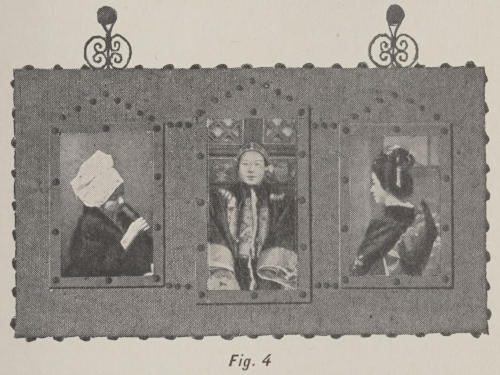
Fig. 4.
The long panel effect shown in Fig. 4 is a simple and pleasing mounting for small photographs, or colored prints. A board is covered with ordinary burlap, which is drawn over the surface and tacked at the back; apparently it is held in place by the large, oval-headed tacks driven all around the outer edge. A card-mount the size of the[76] photograph is cut away at the middle, leaving the outer edge about half or five-eighths of an inch in width. This is laid over the photograph, and through it the nails are driven which hold the photograph and the frame to the board. The scroll-hangers at the top and the nail-head decorations add to the artistic appearance of this frame.
For etchings, water-colors, or colored photographs and aquarelles, where a wide mat is desirable, plain narrow frames should be used. These may be made from moulding with the rabbet cut in by machine, but the boy craftsman may use flat rails and make his own rabbet.
First cut the joints with a mitre-box and saw; then with glue and slim nails a good union is made, as shown at Fig. 5, the dotted lines representing the long, slim nails. If a lap-point is preferred to a mitre, both ends of the flat rails should be cut away, as shown at Fig. 6, the union being made with glue and short screws driven in from the back of the frame, taking care, however, not to puncture or deface the face of the frame. Where a rabbet is to be made at the back of a frame, the front inner edge should be bevelled, as shown at A in Fig. 7, so that there will not be too great a thickness of wood close to the glass. A quarter of an inch out from the inner edge of the frame fasten four square sticks with glue and small nails. These sticks should be three-eighths of an inch square, and mitred at the corners, as shown at B in Fig. 7. The glass can then lie on the back of the frame within the space described by[77] the small sticks, and over it the picture and back-board are placed, the nails being driven in to hold them in place.

Fig. 2. Fig. 5. Fig. 6. Fig. 7. Fig. 8. Fig. 9.
For a picture in which horses are prominent, such as a race, a group of horses’ heads, or a driving scene, an appropriate frame is suggested in Fig. 8.
The frame proper is made from narrow strips of wood, the face of which is studded with oval-headed nails. This frame is then arranged on a large board, and at the corners blocks, or separators, are fastened, which will cause the frame to stand away from the large board for half an inch or so, in order that the stirrup-strap and the whip-handle may pass under it, as shown at A in Fig. 8.
The frame is hung by means of large harness-rings caught at the top of the frame with leather straps. These are carried about the back-board and buckled at the front. The stirrup is suspended from the lower middle part of the frame on a strap, which is caught about the back-board and runs under the small front frame.
Dark Flemish oak for the back-board, russet straps, and brass buckles will make a pleasing combination; and if the picture is a colored one, it will add greatly to the effect of the complete mounting.
For one large head-picture and a number of small ones a novel scheme for mounting is shown at Fig. 9.
This is a one-piece barrel-head covered with burlap or denim. The photographs are cut circular and mounted on heavy white or cream-colored card-mounts, then trimmed so that a margin half an inch wide will be left all around. These are to be applied to the barrel-head with oval-headed upholsterers’ nails, as suggested for Fig. 1. The hangers are made from thin strips of iron, and should be as long as half the diameter of the board.
In Italy, many years ago, there originated the pretty household art of making small objects from metal strips bent into graceful curves and scrolls, and then banded together. During the past few years American and English boys have taken up this Venetian and Florentine metal-work, and to-day the materials may be purchased at hardware stores in all the large cities.
The tools required are a pair of flat and a pair of round-nosed pliers, or pincers, a pair of heavy shears, and a pair of wire-cutters; a small bench-vise will also be useful.
The materials include a few sheets of thin stove-pipe iron of good quality (it may be purchased from a tinsmith), several yards of fine, soft iron wire, and some heavier wire for framework.
From the sheets of iron narrow strips are to be cut with the shears, and for ordinary work they should be not more than three-sixteenths of an inch in width; for heavier or lighter work the width may be varied. If it is possible to obtain the prepared strips at a hardware store, it will be better than making them at home, since it is a tiresome task to cut many of the strips from sheet-iron. Soft, thin iron[82] that will bend easily is the only kind that is of use, as the hard or brittle iron breaks off and it is impossible to bend it into uniform or even scrolls.
A little patience and perseverance will be necessary at first until the knack of forming scrolls has been mastered, but once learned it will then be an easy matter to make many pretty and useful objects.
An attractive design for a lamp-screen is shown in Fig. 1 A. When completed and backed with some pretty material it will be found a useful little affair to hang against the shade of a lamp to shield one’s eyes from the direct rays of a bright light.
To begin with, form a square of six inches, and at the top where the ends meet make a lap-joint by allowing one end to project over the other; then bind them together with some very fine wire—about the size that florists use. Inside of this square make a circle six inches in diameter, and wire it fast to the square where the sides, bottom, and top touch it.
Bend four small circles, and fasten one in each of the four angular corners between the circle and square; then form the centre scrolls and the hoop in the middle of the screen.
To form a scroll like that shown in Fig. 1 bend a strip of metal in the form of a U, as shown in Fig. 2, and with the round-nosed pair of pliers begin to curl one end in, as shown in Fig. 3. When it has been rolled far enough in to form one side of the scroll, it will appear as shown in[83] Fig. 4. By treating the other end in a similar manner the finished result will be a perfect scroll like Fig. 1. Four of these scrolls are to be made and banded to the circle and to each other, and in the centre the hoop must be made fast with little metal bands.
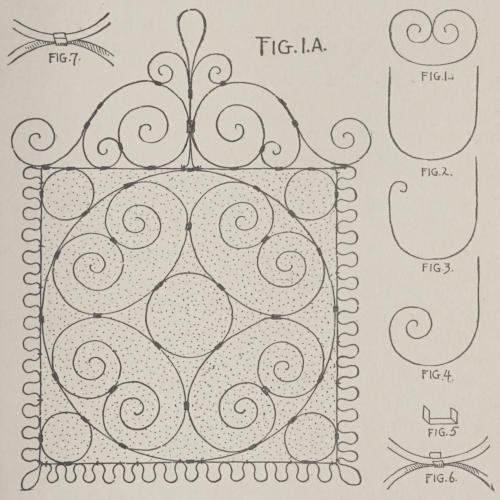
Fig. 1. Fig. 1 A. Fig. 2. Fig. 3. Fig. 4. Fig. 5. Fig. 6. Fig. 7.
When uniting or binding two strips of metal together they may be fastened with wire or bands, as a matter of[84] choice. If the latter mode is employed, short pieces of the metal strips are to be cut and partially bent in the form of a clamp, as shown in Fig. 5. Bring the two sides together and bend one ear of the clamp over them (Fig. 6), and if the other ear is the proper length, bend that down in place, and squeeze all together with the flat-nosed pair of pincers. The perfect joint will then appear as shown in Fig. 7. When using metal clamps the ears should be of such a length that, when pressed down over the united strips of metal, the ends will just come together and not overlap.
Having made the body part of the screen, form the scrolls of the top, and bind them in place with wire or the little metal clamps. This top should measure some three inches high from the top rib of the screen, and the end scrolls should project about three-quarters of an inch beyond the body of the screen at either side.
For the sides and bottom form a frill of metal and fasten it to the screen with wire; it should not be more than three-eighths or half an inch in width, and can be bent with the round-nosed pincers and the fingers. Better wear gloves for this part of the work.
When the metal-work is finished it will be necessary to coat it with black paint to improve its appearance and prevent its rusting. There are several good paints that may be used for this purpose, but if they are not easy to obtain an excellent coating may be made by dissolving a little shellac in alcohol and adding dry lamp-black so it will be about the consistency of cream. It should be applied to the metal with a soft brush, and if it should become too thick it may be thinned by adding alcohol.
Two thin coats will be all that are required for ordinary purposes, but if the metal-work is exposed to the weather, or any dampness that might cause it to rust, a coat of red lead should be applied next the iron. Red lead can be mixed with boiled linseed-oil to make a good metal paint.
A backing of some pretty, light-colored silk is required to complete the screen, using one, two, or three thicknesses to properly shield the light. The backing should be attached to the grille, or framework, with black silk, and it may be cut to fit either the round or square portion of the framework. The stitches should be close together, to prevent the goods drawing away from the metal ribs.
When constructing any piece of grille-work it is always best to have a full-sized drawing to work over. For example, it is a simple matter to lay out the plan for Fig. 1 A, and you may proceed as follows: Pin to a lap-board a smooth piece of heavy brown paper, and with a soft pencil draw a six-inch square. Inside this describe, with a compass, a six-inch circle; then draw the four corner circles, and divide the larger Circle into quarters. In each of these quarters draw, in free-hand, the scroll shown in Fig. 1 A. The top is to be drawn in free-hand, but if it is difficult to get both sides alike you may first draw one side; then double the paper, and transfer the design by rubbing the back of the paper. It will then be found an easy matter to bend and fit the scrolls, since each member may be accurately[86] shaped to conform to the lines, and afterwards banded together.
For a standard screen in the shape of a banner the design shown in Fig. 1 A may be used, leaving off the top ornament, and suspending it from the upper end of a supported stick with cord or wires, as shown in Fig. 8.
The stick should be about eighteen inches high, and the scroll feet should stand seven inches and a half up from the bottom. At the widest part they should measure six inches across, and there should be four of these feet to constitute a stable base. At the top of the stick (which should be about one-quarter of an inch square) a scroll and a hook will serve to support the screen. In a library or sitting-room, where one large lamp is used to read by, one or two banner-screens will keep the strong light from the eyes and the heat from the head without cutting off the needed illumination from the book or work in hand.
The illustration shown in Fig. 9 gives a pleasing pattern for a small-based candlestick.
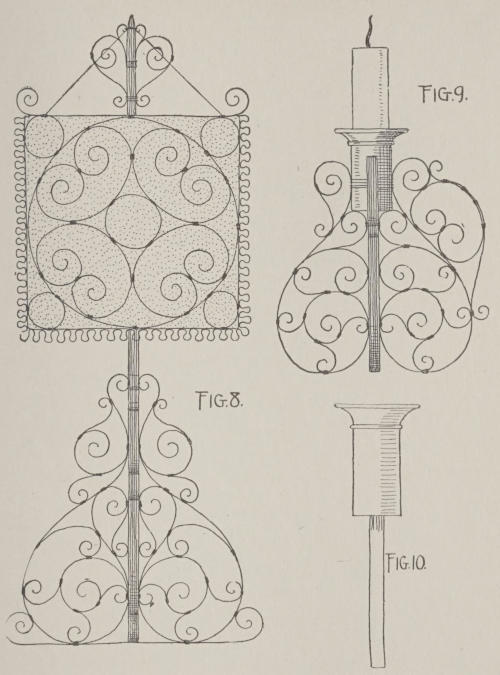
A STANDARD SCREEN AND A CANDLESTICK
Fig. 8. Fig. 9. Fig. 10.
To begin with, secure an old tin or brass candlestick and rip off the bottom, leaving only the sheath and collar at the top. Have a tinsmith cut the lower end away, leaving about two inches of the top, and solder a bottom in it. Cut a pine stick about four inches long and not more than three-sixteenths of an inch square, or the same thickness as the width of the metal strips from which the scrolls are to be formed. Punch a small hole in the bottom of the socket, and drive a slim steel-wire nail down through it and into the middle of one end of the stick, so that the attached pieces will appear as shown in Fig. 10. The socket will hold a candle, and the stick will act as a centre staff against which the four scroll sides are to be fastened.
A paper pattern should be used over which to bend the scrolls, and across the bottom they should measure four and a half inches, and five or six inches high. To the upper part of one side-scroll a handle should be shaped and fastened, as shown in Fig. 9.
The design for a four-armed candelabra to hold five candles is shown in Fig. 11.
Cut two sticks a quarter of an inch square and ten inches long, another one thirteen inches long, and a short piece two inches long. At the middle of the ten-inch lengths cut laps, as shown in Fig. 12, and bore a hole through the centre and into an end of the long stick. Drive a slim nail down into the hole at the end of the stick, as shown in Fig. 13, and over it place the cross-arms, as shown in Fig. 14. In one end of the short stick bore a hole, snug it over the top of the nail, and drive it down so that it will fit securely on top of the cross-sticks. The completed union will have the appearance of Fig. 15, and to this wood frame the scroll and ornamental work is to be attached.
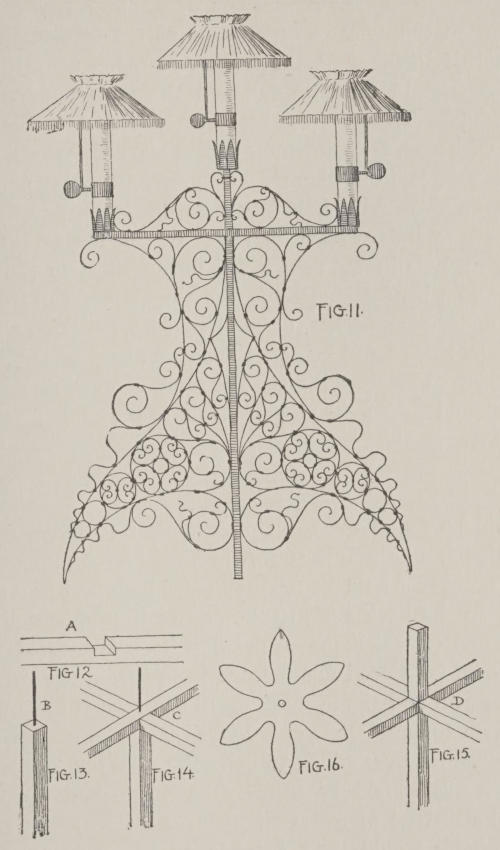
A CANDELABRA
Fig. 11. Fig. 12. Fig. 13. Fig. 14. Fig. 15. Fig. 16.
Lay out the plan of one side on paper, making the distance from the stick to outer edge of the foot about four and a half inches. At the narrowest place, near the top, the side should measure one and three-quarter inches in width. The scrolls should be securely bound to the wood frame with wire, and for candle sockets five six-pointed stars should be cut from the pattern given in Fig. 16. They should be two and a half inches in diameter, and bent to receive a standard-sized candle. A small screw passed through a hole in the centre will fasten them to the wood arms, and when placing them the wood should extend entirely under each socket, as may be seen in Fig. 11.
Canopy shades and holders should be made or purchased, and when complete with candles and shades this candelabra should present a very pleasing appearance.
It will be found quite a simple matter to make a fairy lamp similar to the one shown in Fig. 17.
The bracket should be twelve inches high and five inches wide from the back stick to the end of the projecting arm, on the end of which the suspending hook is located. The arm should be placed about three inches from the top, and both the arm and the upright are to be of wood one-quarter of an inch square. It would be well to make a pattern of the scroll-work over which to bend the metal in true shape.
The scrolls should be securely bound to the wood ribs with wire instead of metal clamps, since the weight of the candle-sconce would have a tendency to open the clamps and weaken the support.
For the lamp part, it will be necessary to have the socket of a candlestick arranged as described for the candlestick in Fig. 9. The stick at the bottom should be one and a half inches in length. Against this the scroll-work is attached. Each side should measure two and a half inches long and three inches high from the place where the suspension-wire is attached to the bottom, where the pendants are fastened. The four scrolls must be securely bound to the socket and stick with wire, and from a screw-eye driven in the lower end of the centre stick three drops, or pendants, may be hung. These pendants are in the shape of bell-flowers, and may be of any size, cut from the diagram shown in Fig. 18. They should be strung on a wire having a knot made in it wherever it is desired to place a flower.
From the scroll ends of each side-grille a wire is fastened and carried up to a ring that hangs on the arm-hook. These wires form a light and graceful mode of suspension, and near the upper end a canopy shade can be made fast. Pink red, orange, light-green, or electric-blue candles and shades always look well with the black iron-work of the bracket and sconce.
Fig. 19 gives a design for a small receptacle to be used for burned matches or other small waste scraps.
Notice that the drawing shows but one side of a three or four sided affair. The outside frame should measure about three inches across at the top, two inches at the bottom, and two and a half inches high.
Small hooks should be fastened to each upper corner.[92] From them small chains extend up to a single ring that may be of wire; or a small iron harness-ring may be employed for the purpose.
The three or four sides forming the receptacle are to be securely bound together with wire, and for a bottom a thin piece of wood or a sheet of light metal can be sewed in with wire. Whether the bottom is of metal or wood, it will be necessary to make small holes around the edge through which the fine wire can be passed. The wire should be caught around the bottom ribs of the sides, and manipulated in much the same manner that cloth is attached with needle and thread.
Each side should be backed with silk or other pretty material, and to prevent burning or blackening from match ends the entire receptacle may be relined with card-board, tin-foil, or asbestos paper.
The links forming the chain are made of very narrow strips of the metal. Fig. 19 A shows the construction of the centre, and B that of one side. Two of the latter are to be made for each link and banded to the centre, so that a finished link will appear like C in Fig. 19. The links should be connected with little wire rings, or small brass rings may be purchased at a hardware store. The latter, when painted black, will appear as if made of iron.
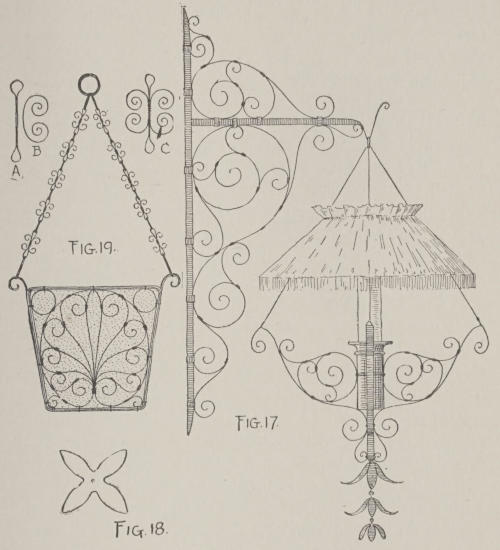
Fig. 17. Fig. 18. Fig. 19.
This same design can be carried out on a larger scale, and adapted as a hanging jardinière in which a potted vine may be placed. If employed for that purpose, an outlet for the water must be provided in the bottom. Instead of using a clay flower-pot, it would be well to have a tinsmith make a zinc inner box, with a small pipe through[93] the bottom to convey the waste water into a small cup that may be suspended underneath. As the proportions of the box are enlarged, the links of the chain must be made larger and stronger, so that the chain will be heavy enough to support the weight; and instead of using wire or brass[94] rings, it would be advisable to employ small iron harness-rings.
Among the many pretty little objects that can be made from thin metal strips, frames for small pictures are always serviceable and attractive (Fig. 20). Black is not always a desirable color for a frame, and there are several good enamel paints on sale. They may be procured in almost any light shade, such as pink, blue, green, brown, and the pale yellows or cream colors. Several successive thin coats of these enamel paints will give the iron scrolls a pretty finish.
It is hardly necessary to lay down a size for this frame, as it can readily be adapted to any photograph or small picture. The proportions, however, should be followed as closely as possible, so that the design will work out about as shown in the drawing.
This frame may be hung against the wall, or arranged as an easel for a table, mantel-shelf, or wall-bracket. If the latter scheme is preferred, a support may be made from narrow metal strips and attached to the back of the frame with wire. This support should be of the design shown in Fig. 20 A; it is attached by the top cross-bar to the back of the frame. This cross-bar is of round iron, and the projecting ends are to be caught with wire loops, which will allow the back leg to act as if arranged on a hinge. To prevent it from going too far back, a wire or string at the bottom will hold it the proper distance from the frame.
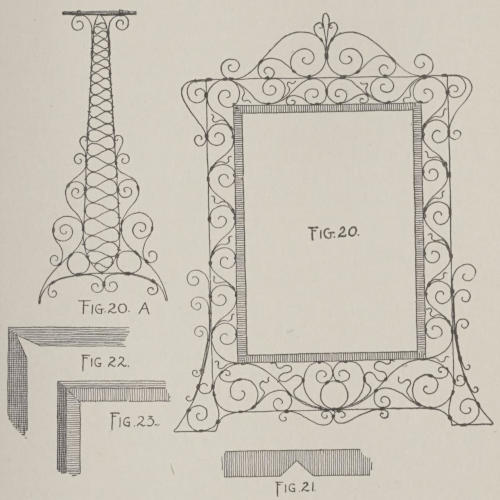
Fig. 20. Fig. 20 A. Fig. 21. Fig. 22. Fig. 23.
The frame proper is made from a strip of metal half an inch wide, and bent in angular form, showing less than quarter of an inch on each side of an L. In the strip cut angle-notches with a pair of shears, as shown in Fig. 21, thus forming the corners. The notches should be made half-way across the width of the metal, so that the point of each angle will just reach the middle of a strip. With a[96] flat-nosed pair of pliers bend the strip in the form of the oblong, so that each corner will appear like Fig. 22. Join the frame at the bottom, allowing the metal to lap over an inch at the ends, and make the union by punching little holes and passing through small copper tacks that can be clinched or riveted.
With a small bench-vise and a hammer, or with two pairs of pliers, grasp the strip forming the frame and bend it in the shape of an L all around, as shown in Fig. 23, taking care to match the edges of each notch so that they will form a mitre, as shown also in Fig. 23. Where the scrolls are attached to the side of this frame, they may be held in place by small copper tacks passed through holes made in both scrolls and frame and riveted.
One of the most interesting branches of the light strap metal-work is in making boxes of all shapes and sizes. The variety of designs that can be employed is practically inexhaustible, but certain general principles should be observed. For instance, a box to hold matches should be of small and neat design, while in a larger box the ornament may be more open and bolder, and the strips from which it is made should be heavier and stronger.
A handkerchief-box fashioned after the design shown in Fig. 24 is a pretty as well as a useful article for a bureau or dressing-table. A is the pattern for the top, and B represents one of the sides.
It should measure eight or ten inches square and three[97] inches deep, or larger if desired, and the frame should be of wire or wood. If wood is employed, sticks three-sixteenths of an inch square must be lap-jointed at the angles, as shown in Fig. 25, and the union made with glue and screws or fine steel-wire nails.

Fig. 24 A. Fig. 24 B. Fig. 25. Fig. 26. Fig. 27.
If the box should be made of brass scrolls, it would be well to obtain some brass rods about one-eighth or three-sixteenths of an inch square, and bend them to form the framework. Where the ends meet, lap-joints should be cut and wired.
If the brass should be too hard to bend in a vise without breaking, the part it is desired to work should be heated over a spirit-lamp or in a gas flame for a moment or two;[98] when cool, it will be soft and pliable. If brass should be employed for the frame, the joints must be soldered instead of wired. To solder them it will be necessary to have some soldering solution, a spirit-lamp, and some wire solder.
To unite the metal ends apply some of the soldering solution to the parts with a piece of wood or an old camel’s-hair brush, and then hold them over, or in the lamp flame, until they are quite hot. When sufficiently heated touch them with the end of a piece of solder, and the heat of the metal will instantly melt the solder, so that it will adhere to the brass. To hold the parts together while they are being soldered, give them a turn or two of fine iron wire. After they have been united and the brass is cold, the wire may be removed and the rough parts of the solder filed away.
Small brass hinges may be screwed fast to the wood ribs to attach the lid to the box, and if brass is employed for the frame and grille work the hinges must be soldered to the frame.
For a sign-board an idea is suggested in Fig. 26. At one’s place of business, in front of a cottage, or on a mile-post, it may be displayed to good advantage.
It is only a board on which sheet-iron or lead letters have been fastened, and the edges bound with metal and large-headed nails. A rod set at right angles to a post supports the sign-board, and to ornament it some scroll-work is attached at the top. Scroll ornaments decorate the sides and bottom of the board. These are fastened on with steel-wire nails driven through holes made in the metal and into[99] the edges of the board. The ornamental scroll-work should be made of somewhat thicker and wider iron strips than the more delicate articles for indoor use, and all the iron should be given one or two coats of red-lead paint before the black finish is applied. To prevent rust-marks from running down on the wood board, it is necessary to coat the back part of the letters and all iron straps which may lie against the wood. It is much better to use sheet-lead for the letters, since it cuts easier, and will not stain the wood with rust or corrosion marks.
For a double doorway a pretty effect is shown in Fig. 27, where a long grille is arranged at the top of a doorway, and under it the curtain-pole is attached.
The outer frame for a grille of this size should be made by a blacksmith from an iron rod about three-eighths of an inch square. The inner frame may be made of strip-iron three-eighths of an inch wide, and three inches smaller all around than the larger one. The metal strips employed to form the grille design should be three-eighths of an inch wide, and cut from box strap-iron.
The full-size drawing should be laid out on paper, over which it will be an easy matter to shape the scrolls. If the grille should be too open when the pattern is completed, some more scrolls may be added to fill the spaces, taking care not to injure the general design of the pattern.
The grille may be anchored to the wood-work of the casing[100] with steel-wire nails or staples, and several coats of black should be given the iron to finish it nicely.
Having gained by experience the knowledge and art of working in strip-metal, and after successfully making a number of the smaller objects already described, it is perhaps time to undertake the construction of something larger and more elaborate.
As an example of such work, a very beautiful design for a Moorish lantern is shown in Fig. 28. It is not a difficult piece of work, nor is it beyond the ability of any smart boy, but it must not be attempted before a thorough knowledge of forming frames and scrolls and of pattern drawing has been gained through experience in making more simple objects.
In size this lantern is not limited, and it may be made from twelve to thirty-six inches high, not including the suspension chain and rings and the drop of flower-pendants at the bottom.
For a lamp twenty inches high having six sides, each panel should be made on a wire frame. The middle panels measure six inches high, four inches wide at the top, and three inches at the bottom. The top panels are five inches across at the widest place, and the lower ones four and a half inches. One of the middle panels can be arranged to swing on hinges, in order to place a lamp within the lantern, and also to make it possible to line the inside of the lantern body with some plain silk or other material.
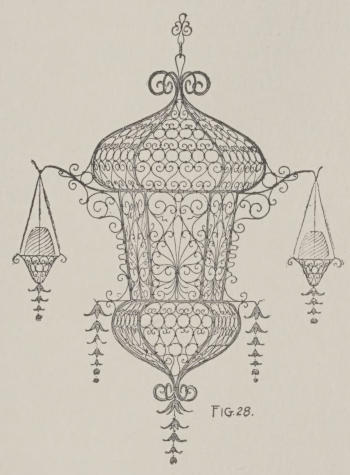
Fig. 28.
At the top and bottom scrolls are to be formed of the stout wire employed for the ribs or framework. Under the crown top, at the six corners, brackets may extend out for a distance of five inches, from which sconces for tapers or small candles may be hung. Or these brackets may be omitted, and in place of the hooks a small scroll may be formed at the extending ends. Each little sconce is two inches deep and two and a half inches in diameter, and in them candle-holders may be placed, over which colored glass globes will appear to good advantage. From the top[102] of the lower lobe six arms support flower-drops four or five inches long, and from the extreme bottom a pendant of flowers finishes off the whole. No matter what size this lantern is made, the proportions should be carefully preserved, or the effect will be spoiled.
A long chain made up of links and rings may be used to suspend the lantern. Should a more secure anchorage be desired, four chains may be attached at four places on the ceiling of a room, from which anchorage they all meet at the top of the lantern.
The illustration shows the lantern in perspective, but it must be borne in mind that it has six sides, and the patterns of the six sides, of the top, middle section, and bottom are like those in the three front sections that face the reader as he looks at the drawing.
Thin sheets of various metals may be used to great advantage in the decoration of household furniture, either serving as artistic edgings, or representing strengthening straps, hinges, etc. When finished off with heavy wrought-iron or bellows nails, the effect is both striking and pleasing. The art is not a difficult one to acquire, and the hints and suggestions that follow should enable any smart boy to pick it up in a comparatively short time.
As a receptacle for photographs, picture-cards, and the other small trifles that accumulate in a library or living-room, a box such as shown in Fig. 1 will be found most useful.
Obtain some smooth pieces of wood, not more than three-eighths or half an inch thick, and construct a box eighteen inches long, ten wide, and eight inches deep, including top, bottom, and sides. These parts are to be glued and nailed together so as to form an enclosed box. Use a good liquid glue and slim steel-wire nails to make the joints. When[104] the glue is dry, cut the box through all around the sides, one and a half inches down from the top. The lid, or cover, is thereby cut loose, and it will match the body of the box much more accurately than if made separately and fitted.
Plane and sand-paper the rough edges left by the saw, and attach the lid to the back edge of the box with hinges. The outside of the box may be stained or painted any desirable color, and when dry it will be ready to receive the metal decorations.
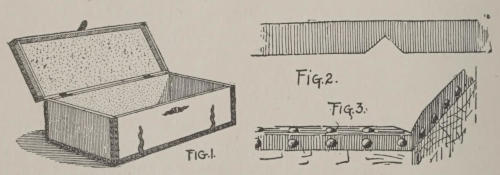
Fig. 1. Fig. 2. Fig. 3.
From a tinsmith obtain a few sheets of thin stove-pipe iron of good quality, or a strip of thin sheet-lead; then, with a stout pair of shears, cut some strips about one and a quarter inches wide to bind the edges of the box. A strip is bent over so as to lap on both sides of a corner. A metal band five-eighths of an inch wide will show on each side and also on top. The metal is to be fastened on with brass oval-headed upholsterers’ tacks, and the heads may be from a quarter to half an inch in diameter.
It will not be possible, perhaps, to drive these tacks through the metal strips unless a hole is first punched. These small holes may be made with a sharp-pointed awl at regular distances apart. This should be done before the[105] strip is laid on the wood, so as not to subject the box joints to any more strain than necessary.
To bind an edge, tack a strip of the metal along one side, bend it around the first corner, and so on along each side until the two sides are brought together, where a nail-head will almost hide the joint. At each corner cut a V out of the strip, as shown in Fig. 2. The metal, when fastened to one edge, will appear as shown at the right side of Fig. 3.
When the nails have been securely fastened in, bend down the standing edge of metal so that it will lie flat on the other side of the corner. This may be done by beating it down with a light wooden mallet. Drive nails along the strip corresponding in position to those first fixed, and the edge will appear as shown at the left side of Fig. 3.
Where the angle, or V, was cut out of the strip at the corners, the metal will come together and form a good mitre. In the middle of this joint drive a nail, the head of which will partially hide the line of juncture.
From the sheet iron or lead cut a few irregular strips of suitable length, and fasten them to the box to represent hinge or binding straps. The hasp and eye-plate may be made in the same manner.
The box should be lined with Canton flannel, velour, leather, or any good lining material. A band of webbing, or a chain, arranged on the inside will prevent the cover from falling back too far.
In a room where space cannot be spared for a large wood-box, a wood-holder similar to the one shown in Fig. 4 is a useful piece of furniture.
This holder is twelve to fifteen inches square, fifteen inches high at the front, and twenty inches high at the back, with the sides cut down, as shown in the drawing.
The wood is three-quarters or seven-eighths of an inch thick, and planed on both sides and edges. Any of the hard woods may be employed to good advantage in making the box part, but if it is to be painted rather than left in the natural finish, the wood-work may be of pine or white-wood to save expense.
The metal binding is done in a similar fashion to that of the box in Fig. 1, and if iron is used for the straps they should be coated with black paint. The strips should be two inches in width, and when bent around the edges and corners one inch of metal must show on each side.
For large, growing plants, palms, and imitation trees, an attractive plant-box is shown in Fig. 5.
It can be made almost any size to meet the requirements of the plant that is to live in it; but for general use it should measure twelve inches square at the bottom, eighteen at the top, and from twelve to fourteen inches high.
The metal binding should be three-quarters or an inch wide on each side; it need not be carried over the top edge unless desired.
On two sides of the box ring-handles are to be fastened. These will be made by a blacksmith at a small cost, and should be from two and a half inches to four inches in diameter, according to the size of the box.
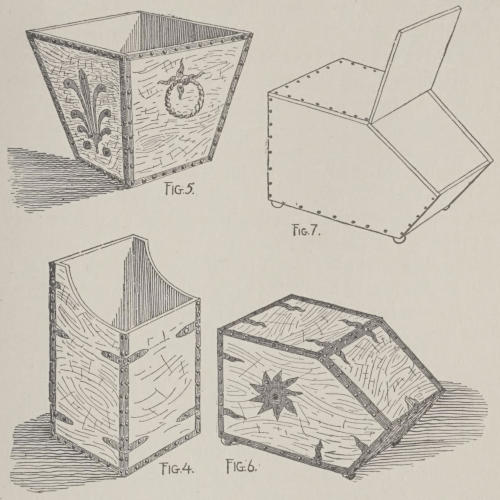
Fig. 4. Fig. 5. Fig. 6. Fig. 7.
On the other sides a conventional design may be worked out with strips of metal cut according to the required pattern.
This box should be treated to several good coats of paint inside, and finished as desired on the outside. Quartered oak with black metal trimmings make a good combination; also mahogany, cherry, or redwood with brass bindings.
A zinc lining should be fitted to the box, with a vent-hole[108] at the bottom to drain off surplus moisture. No other metal than zinc should be employed for the lining, since iron or tin will corrode or rust. Copper tacks must be used to attach it to the wood.
Fig. 6 gives the design for an old English coal-box.
It is a very simple affair to construct, since it can be made from an ordinary box cut down at one end so as to form a projection or nose.
The structural plan of the box is clearly shown in Fig. 7, and in size it may be made to meet any requirement. For regular use, however, it is fifteen inches wide, twenty inches long from back to end of the nose, and about twelve inches high, not counting the ball feet, which will raise it up two inches more.
The box should be securely screwed together at the joints, and the lid, or cover, must be fastened on with sheet-brass hinges. Paint or varnish will give the wood-work a good finish, and the lining should be made with several successive coats of asphaltum varnish or paint of a dark color.
Brass, lead, or black iron binding will look well on this box, and with large-headed nails the effect will be bold and pleasing.
Four balls about two inches in diameter are to be turned and screwed fast under the corners to serve as feet. To give a good purchase on the bottom of the box, it would be well to flatten part of the surface on each ball. One[109] long screw will be sufficient to anchor each foot firmly if driven through from the inside of the box into the ball. A little glue between the joint will add greatly in making the union strong.
The design for a table-lamp is shown in Fig. 8.
Any boy who is handy with tools can put this lamp together from wood, burlap, sheet-lead, wire, some oval-headed upholsterers’ tacks, four claw-feet, and a lamp-fount.

Fig. 8.
From boards about half an inch in thickness make a box seven inches square at the top, ten at the bottom, and[110] twelve inches high. In the top of the box a round hole is cut to receive the lamp-fount. Five inches in diameter will be about right for the hole, since that is the measurement of the standard oil-pot. A flange, or rim, all around the upper edge of the fount will prevent it from falling through the hole. If the burner has a central draught it will be necessary to bore some large holes through the bottom of the box to admit air for the under draught.
With burlap, bagging, or canvas cover the entire outside of the box, the material being fastened to the wood with glue and small, flat-headed tacks at the edges. The glue must be spread evenly over the wood by means of a rag pad, or, still better, a small photographic squeegee roller may be employed. The covering material can be painted any good shade, and when the paint is dry the box will be ready for the decorations and trimmings.
From sheet-lead, or iron, cut some strips one inch and a quarter wide, and bind the corners and edges of the box, allowing about five-eighths of an inch to show on each side. Fasten these strips on the edges of the box with large, oval-headed upholsterers’ tacks, driven along each side at even distances apart, as shown in the illustration.
On a piece of smooth brown paper draw the outline of one side of the box, and then sketch in the design for the metal torch and wreath. Over this pattern it will be a comparatively easy matter to cut and fit each of the separate parts of the design. These parts are to be of thin iron or lead, but for the stems to the laurel wreath use pieces of iron wire, and fasten them on with small staples. The staples may be made from pins with the heads cut off.
The pieces of metal forming these side designs are to be fastened to the wood with oval-headed carpet tacks, and enough of them must be driven in each piece to hold it firmly in place. When all the metal-work has been applied, purchase at a hardware store four claw-feet, and screw one fast under each corner of the box. They will be of brass, but when painted black they will appear as if made of iron.
All the metal parts of the lamp must be blacked to present a good appearance. To make a good black finishing paint obtain at a paint store a can of ivory black ground in oil. Thin it to the consistency of rich milk with Japan dryer and spirits of turpentine mixed together, one part of the former to two parts of the latter. Place them together in a bottle and thoroughly mix them by shaking the bottle vigorously. A small quantity only should be thinned at a time and as required, since it works better when freshly mixed, and does not have the gummy appearance that an old mixture presents. Two or three successive coats laid on with a soft camel’s-hair brush will be sufficient to cover the iron well and give it a good surface. When using the black take care not to smear it on the box, as it would produce an untidy and messy appearance.
With the addition of a pretty canopy shade, that can be arranged on a wire frame, the effect will be most decorative and pleasing.
For the dining-room or library, a hanging-lamp, such as shown in Fig. 9, is both ornamental and useful.
The box that holds the lamp is eight inches square at the top, five and a half inches at the bottom, and five inches deep. It is covered with burlap or other suitable material, or may be left plain or painted.
A hole is cut in the top of the box to receive the fount, and if it is a central-draught burner a large opening must be made in the bottom of the box, with a perforated metal cap arranged to fit over it.
From the top of the four corners, iron scrolls, that a blacksmith can make, project four inches beyond the wood, and to these the suspension-chains are fastened. The chains are made of one-inch iron harness-rings and links three inches long, formed of narrow strips of stove-pipe or box strap-iron less than a quarter of an inch in width, and shaped as shown in Fig. 10.
From the under side, and fastened at each corner of the box, hang four small chains. They are united at the centre a few inches below the under side of the box, and are finished off with a drop formed of metal lilies. In order to form these flowers, cut from sheet-iron the petals, as patterned in Fig. 11. Three different sizes should be drawn on a sheet of iron with a piece of chalk or white crayon, after which they may be cut out with a pair of shears and bent into form with the fingers. They are to be hung together one below the other by means of small wires, fastened to the centre of each flower through holes punched with a sharp-pointed awl.
A large paper or silk shade may be arranged on a wire frame to slip over the chains, and to hold it in place it should be fastened to some of the links with wire.

Fig. 9. Fig. 10. Fig. 11. Fig. 12.
For vines, small plants, or pretty blade grasses a design for a hanging-plant box is shown in Fig. 12.
This is not a very large affair, and it is made of thin wood not more than three-eighths or half an inch in thickness.[114] The box part measures eight inches square at the top, six at the bottom, and ten inches high.
The inside of the box is to be treated to several coats of paint or asphaltum varnish to protect the wood, and the outside may be given two coats of paint. The corners are then to be bound with metal strips, and the design on each of the four sides worked out with hobnails painted black.
It is difficult to carry out such a design on four sides of a box unless a pattern is used. To obtain the most accurate results it would be best to draw the design with pencil on a smooth piece of paper, then make four tracings of it on tissue-paper. The tracing should then be fastened to the wood with pins and the tacks driven in, following the lines of the design.
When the tacks have been driven in part way, tear off the paper, and with a flat-iron held against the inside of the box to drive against, hammer the nails in so that the heads will lie snugly against the surface of the wood.
Each side is to be treated in the same manner, so that the four sides will be alike. If the hobnails cannot be had at a hardware store, or from a shoemaker, oval-headed upholsterers’ tacks may be used. Paint them black before they are driven into the wood.
At the top of the box, in the four corners, eyes are to be made fast, into which the ends of the suspending chains can be caught. Four chains, made from thin strips of metal and small harness-rings, are to be fastened in place, as shown in the drawing.
Properly to complete even the simplest of cabinets or chests some hardware will be needed, whether it be only a pair of strap-hinges and a padlock or the most elaborate kind of ornamental fittings. Plain hinges and a lock will answer every ordinary purpose, but a nice chest or case should be finished off with ornamental hinge-straps, escutcheons, lock-plates, or handles.
These fixtures may be purchased at a hardware store and in some large cities a very beautiful assortment of fancy hardware is displayed. But it will be both cheaper and more satisfactory for the young craftsman to make these fittings for himself, and the art is not a difficult one to acquire. Some of the accompanying designs may appear at first sight rather beyond the ability of the average boy, and so they would be if they were cast in brass or bronze or cut from thick sheet-metal. But all of them can be shaped from ordinary sheet-lead with a pair of old shears, a few small chisels, and a light mallet.
Scraps of sheet-lead, varying in thickness from one to three-sixteenths of an inch, may be purchased from a plumber for five or six cents a pound. For the ordinary[116] fixtures of medium size the metal should be a trifle less than one-eighth of an inch in thickness. For the heavier hardware an old piece of lead pipe may be used by splitting or sawing it open, and beating it out flat, on the surface of an old flat-iron, with a hard wooden mallet. If sheet brass, copper, or zinc are employed, they should be of the soft kind, so as to cut easily. If too hard, the pieces may be softened or annealed by putting them in a fire until they are cherry-red. They should then be drawn out and allowed to cool, when they will be found quite soft and easy to work.
The boy who owns a scroll-saw will find it an easy matter to jig out these designs, whether the material be lead or one of the harder metals. Special fret-saws may be purchased for this purpose, having finer teeth and being more highly tempered than those used for wood-working. In sawing metal you must be careful not to force the saw, and after cutting an inch or two allow the blade to cool, otherwise it will break.
If a hand jig-saw is the only tool available the metal should be held in a vise. With very thin lead the dressing is best done by laying the metal on a hard-wood block and cutting out with small chisels and a light mallet.
Three or four small wood-carving chisels, straight-edges, and gouges will be found admirable tools for this work, and, as the lead does not dull them, they will keep an edge for a long time. A wood-carving chisel is ground on both sides, which makes it better for this work than a carpenter’s chisel, which is ground only on one side. A light mallet, a[117] hard-wood block, a coarse file or two, and a knife with a small, sharp blade will be the only other tools required.
The term escutcheon, as applied to hardware, means the ornamental metal plate that is placed over a key-hole, and through which the key has to pass in order to reach the lock. The name is applied also to the plate behind a knocker, or that to which a ring or handle is attached.
In Fig. 1 a few designs for small escutcheons are shown. Their actual size should be in proportion to that of the drawer or door to which they are to be attached.
The design should be drawn to the proper size on a piece of brown paper, then cut out with scissors and laid on a piece of metal, the outline being scratched with a pin or drawn on with pen and ink.
If the metal is sawed the edges will be rough, but they may be dressed down with the files. If the lead is cut out the edges can be finished with a knife-blade, as lead cuts easily and is pleasant to work in. It sometimes happens that in cutting out the more delicate parts of the design that the chisels will distort the metal or force it out of shape. In this case the trueness may be restored by tapping the edges with a small hammer.
A small hand-drill will be found useful for boring holes in the metal, through which screws or nails pass to secure the escutcheons to the wood. If a drill cannot be had, a small awl will answer very well.
Be careful that you do not make the key-hole too large.
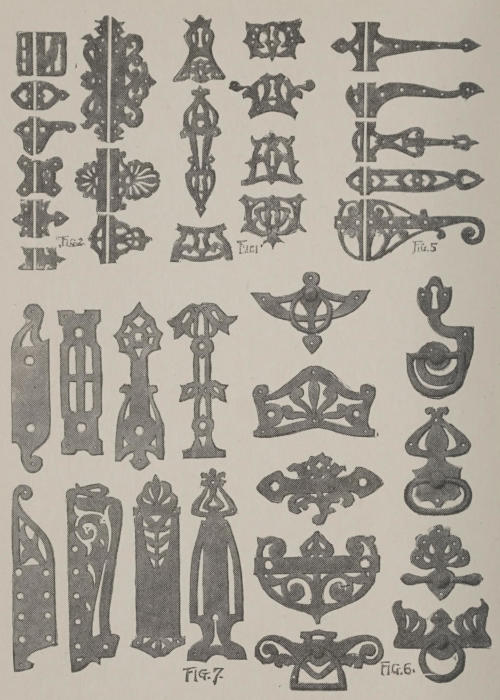
ESCUTCHEONS AND HINGE-STRAPS
Fig. 1. Fig. 2. Fig. 5. Fig. 6. Fig. 7.
[119] It should be only a trifle larger than the key, in order to lead the latter easily.
A single hinge is always made like a book, with two leaves and a back, through which a pin is run to hold the leaves together. In door-hinges the leaves are usually arranged so that when the door is closed the leaves are out of sight. These hinges are called butts, while those applied to the outside surface are called T or strap-hinges, and sometimes plate-hinges.
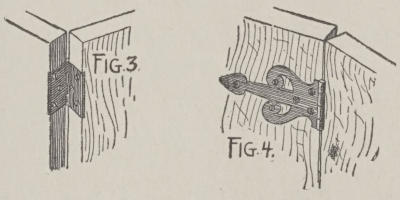
Fig. 3. Fig. 4.
The short hinge-straps shown in Fig. 2 are not intended as a part of the hinge, but only as sham straps. Where a butt is mounted in the wood these straps are arranged on either side of the back. Fig. 3 shows the manner in which a butt is mounted in a door and jamb, and Fig. 4 shows the reverse side with the back protruding, at one side of which the lead strap is mounted. The inside, or parallel, lines of the straps are the edges that butt against the hinge-back, and they are to be cut to fit the width of the hinge.[120] The size should also correspond generally to that of the shape and dimensions of the door or box lid. For artistic effect large sham nail-heads may be fastened over the nail or screw heads that really secure the hinge to the wood.
In some of the plain straps a very good imitation of hand-wrought iron straps may be made by beating the surface of the lead with a hammer having the face slightly crowned or rounded. The hammer-marks will show up distinctly, and when the straps are painted black no one will know but what they are really iron straps beaten out by hand.
Another good effect may be secured by beating the edges down slightly with a small hammer instead of dressing them with a file; this rounds or flattens them, and eliminates the angular edge that is common in all cheap hardware.
For cabinet and chest doors, and doors that open into rooms, some long hinge-straps are shown in Fig. 5, the proportions being correctly indicated.
If the jamb is sufficiently wide, straps may be placed on both sides of the hinge-back. Usually, however, the jamb is too narrow.
These straps, if made of lead, should be thicker than the short straps, otherwise they will look weak. For a strap twelve to fifteen inches long the metal should not be less than one-eighth of an inch thick, and for some designs it would look better if quarter-inch material is used.
It is quite as easy to saw out thick metal as thin, only it[121] takes a little longer time. The saw must be held straight and not allowed to bind. Never force a saw through lead, as it will bind and check, and also will pick up a thin lead coating, materially adding to the friction. If the saw does not run easily, lubricate it with a little soapy water, and afterwards wipe it off to prevent rust. When working with a scroll-saw on which there is a table, or bed, the soapy water should be drawn along the lines on the metal with a soft hair-brush. As the saw cuts it will take up the water.
Small drawer-pulls and handles may be purchased at any hardware store for a few cents each, but they are usually very plain and unattractive. Rings in heads and handles on plain plates are the best to purchase, as then the heads may be mounted on fancy escutcheons, and the handles and keepers removed from the plain plates and reset in lead mountings of artistic design, wrought or sawed from lead or other ductile material.
Drawer-pulls are generally arranged with a shank at the back of the ring-head which passes into the wood, and into which a screw is driven from the inside of the drawer.
Handle-keepers are made in the same way. In designing fancy escutcheons and plates, care must be taken to arrange the holes the proper distance apart to receive the keeper-ends.
On swing and sliding doors—and sometimes on plain doors—plates are mounted above the lock on both sides.[122] Their use is to protect the painted or polished wood-work from finger-marks and similar defacements. Quite elaborate plates are used on some doors, while others are mounted with very plain ones. In Fig. 7 a variety of designs are shown.
The average plate varies in length from six to twelve inches. In width they measure from two and a half inches to three inches, and the metal should be about one-eighth of an inch in thickness.
Door-pull plates are made to receive the ends of a handle. The latter is bolted to the reverse side of the door with countersunk nuts or flush screws. The upper line of drawings in Fig. 7 are designed for this purpose, and the two holes are spaced to line with the ends of the handle that is to be inserted. In addition to the anchorage these plates will get by being held to the wood under the handles, it would be well to make a few holes at the edges, through which small nails may be driven.
In Fig. 8 several designs for large lock-plates are shown. In this instance the knob and key-hole are placed in the same plate. This variety of door hardware offers a broad field for the young designer. But be sure and space the two holes so that the knob and key are in the right place.
In the extreme right-hand plate (Fig. 8) an effect of continued scroll is secured around the key-hole by cutting the ornament out of the body of the plate. This is just the reverse of the scrolls forming the right side of the plate, the ornament in this latter case being of the solid metal.[123] More “feeling” may be given to the solid scroll if an effect of relief is worked out with some blunt tool and the mallet. This may be done with an ordinary nail-punch or a blunt awl. For the veining use an awl or a dull chisel, lightly tapping the tool with a wooden mallet.
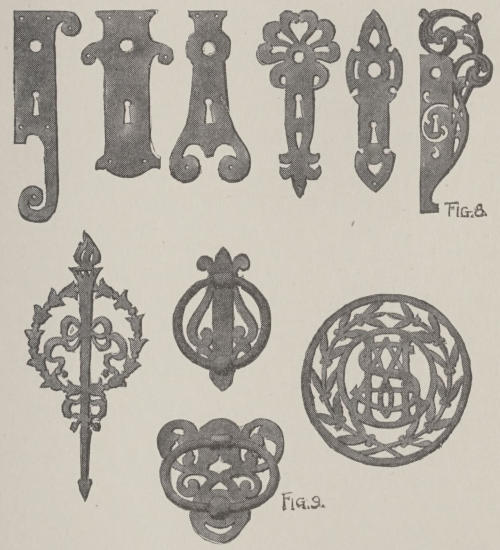
Fig. 8. Fig. 9.
Door-knockers and plates are made in a great variety of designs. The most elaborate and richly ornamented knockers are cast in bronze and chased by hand, but this work is not possible for the boy craftsman to accomplish with his small outfit and limited knowledge of the higher grade of art metal-work.
The knocker-plates shown in Fig. 9 are cut from sheet-lead, but the rings in the keepers (with the knob of metal at the lower side) must be made from iron or other hard metal. A blacksmith will make these rings and set them in a head, or keeper, which in turn is bolted to the inside of a door. Where the knob of metal strikes the plate an iron nail with a large head must be driven through the escutcheon and into the door, so that the knob will strike upon it. Lead will not do for the ring or knob, nor as a striking-plate, since it is too soft to sound sharply and distinctly.
Sheet-lead ornaments in a great variety of designs may be made for panels, the sides of cases, or for the decoration and embellishment of wood-work in general. Wall-paper, carpet, upholstery, and other figured fabrics will offer ideas from which to copy; but after a little practise the young craftsman should originate his own designs, and not depend on other people’s brains to furnish him with working patterns.
There are many pretty and useful articles that can be made for the home, using simple tools and inexpensive materials. Who would imagine, for instance, that such attractive objects as the ones shown in these illustrations could be made from a few pieces of wire of different sizes? Yet, with a little care and perseverance, you may quickly become an expert in wire-working.
To begin with, it is necessary to obtain several yards of soft iron wire varying in sizes from No. 12 to No. 18, also a small roll of soft wire about the size that florists employ to attach flowers to short sticks when making up bouquets.
The tools needed will be a flat and a round nosed pair of pincers, or pliers (see Figs. 1 and 2), a wire-cutter, and a tack-hammer. You will also need a sheet of smooth brown paper, and a soft lead-pencil with which to draw the patterns.
Begin by making simple things; then as you succeed in producing good work you will be able to take up the more difficult patterns. A bird-cage bracket is an easy object to[126] start with. Enlarge the design shown in Fig. 3 so that it will be sixteen inches high, with the hook-arm projecting seven inches from the main upright rod.
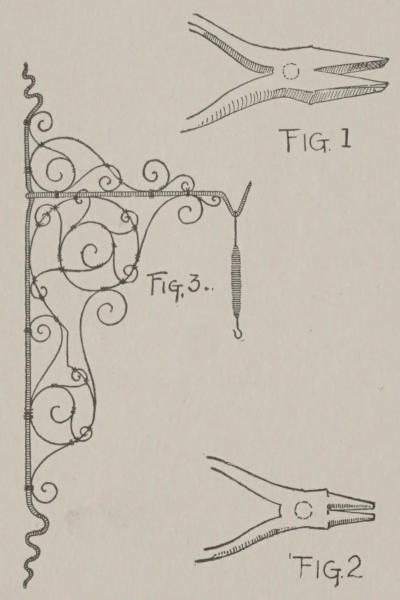
Fig. 1. Fig. 2. Fig. 3.
The pattern is to be drawn out the full size on smooth brown paper; then the wire should be bent and shaped over the lines to conform to the design. Use very heavy wire for the upright and projecting arm, and a smaller size for all the scroll-work. The finest copper wire should be used to bind the scrolls together, and so make tight unions where two edges of wire come together and where the wires cross.
This bracket should be firmly secured to the window-casing with two staples. The staples should not be driven quite home, thus allowing the bracket to be swung from one side to the other of the casing, as though on hinges. This is especially desirable if the bracket is to be used for a hanging-basket or pot of flowers, as it can then be moved against the window or turned back to the wall, to permit of the window being opened or cleaned.
The iron wire should be given two coats of good black paint, or, if desired, it may be gilded or silvered. An excellent black preparation for iron may be made by thinning ivory-black ground in oil with equal parts of Japan dryer and turpentine. Or you may try adding a little lamp-black to brass lacquer or shellac.
The paint should be applied to the iron with a soft hair brush, and the first coat must be good and dry before the second one is applied.
If brass wire is used instead of iron the joints should be soldered, to lend additional strength. The soldering is an easy process and requires only a little care. To do it nicely, obtain from a plumber a little soldering solution in a bottle, and, with a piece of stick, place a drop of solution on each union that has been bound with the fine brass wire. Hold the union over a spirit-lamp flame, and when the wire has become thoroughly heated touch the joint with a piece of wire solder; the latter will instantly melt and adhere to the joint. If soldering solution is not used the joint cannot be soldered, and if the wire is not hot enough the solder will not melt. If the wire should be too hot the solder will melt and fall off from the joint like a drop of[128] water. A little experience will soon enable one to become an expert solderer, and the process should be employed wherever possible, as it strengthens the joints and unions, and holds them rigidly in place. Galvanized or tinned iron wire can be soldered in the same manner.
The brass wire should be painted black the same as iron, but before any paint is applied the superfluous solution should be washed off with water, as paint will not hold if applied over the soldering solution.
Fig. 4 shows a design for a photograph easel that will make an attractive table or mantel ornament if neatly constructed from wire of medium size. It should not measure more than nine inches in height, and where the lattice-work joins the lower cross-bar two hooks should be arranged on which the photograph can rest.
A back support, or prop, to the easel may be made of wire, and soldered to the bar at the upper edge of the lattice-work. The lattice need not be made of as heavy wire as the scroll-work, and where the strands cross each other the junctions are to be securely bound with fine wire.
Larger easels may be made for small-framed etchings, for panel photographs, or for other purposes, but as the size of the easel is enlarged the thickness of the wire should be increased to give additional strength.
By reducing the size of the lower scrolls this design would be quite appropriate for a lamp-shade, and instead of the[129] lattice-work a piece of prettily colored silk or other translucent material may be inserted to serve as the backing.
An attractive design for a match-box is shown in Fig. 5. The total height of the back piece should be nine inches, and the width three inches. The match-receptacle should be an inch deep and project one and a half inches from the wall.
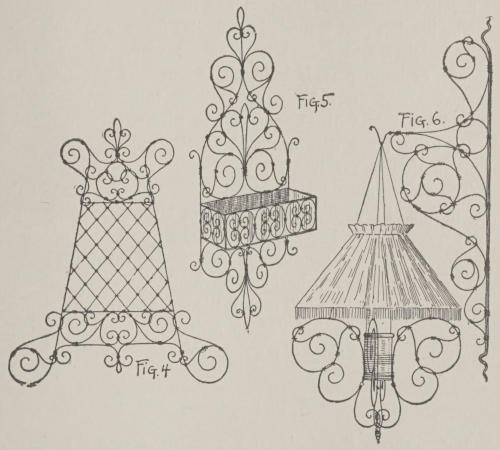
Fig. 4. Fig. 5. Fig. 6.
It should be lined with silk or other goods, to prevent the[130] matches falling through the open-work of the grille. Finished in black, with a red or orange colored silk lining, this match-receptacle will be found both useful and ornamental.
A hanging fairy lamp, like the one shown in Fig. 6, makes a pretty ornament for the parlor or living-room.
The bracket part is made in a similar manner to the bird-cage bracket, and should be of stout wire. The candle-sconce, or lamp part, is built up of four sets of scrolls arranged about an old tin candlestick top, and securely bound together with strands of fine wire closely wrapped.
By using brass wire soldered at the unions a stronger construction is possible.
The sconce should be suspended from the bracket-hook by means of four light wires. These latter may also support a canopy shade made over a light framework of wire.
Ordinary colored candles will look well in this fairy lamp. To keep the colors in harmony it would be well to obtain candles of a tint that will match the color of the silk shade. The lamp may be fastened to a door or window casing, or perhaps to the sides of a mantel-piece.
Fig. 7 shows the design for a picture-frame that is intended to hang against the wall. The frame proper may be made of very narrow picture-frame moulding around which the grille-work is arranged. Where the latter touches[131] the wood-work it is to be made fast with small staples driven in the outer edge, and the ends clinched at the inside, or rabbet, of the frame. Or fine wire may be used in place of the staples.
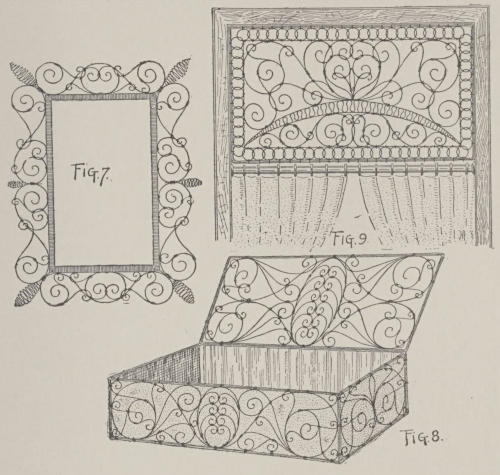
Fig. 7. Fig. 8. Fig. 9.
If an all-iron effect is desired, the rabbet should be made of thin stove-pipe iron or sheet-brass, bent into angular form and finally shaped to the required size. Around it the grille-work is to be made and bound, in about the same proportion as shown in the drawing.
A design for a glove-box is shown in Fig. 8. It should be ten inches long, five wide, and three inches high.
The bottom should be made of a thin piece of wood, and the entire inside, including the top, should be lined with some handsome and substantial material in bright colors.
The four sides and the top should be made in separate pieces, and afterwards bound securely together with fine wire.
Fig. 9 is a grille for the upper part of a window. It will be very effective if constructed of heavy wire, the design being neatly carried out. Variations of this grille may be made for doorways, transoms, and skylights, and with the hints and drawings already given a bright boy will soon be able to invent and work out his own designs. There are dozens of other objects that may be made in iron-work, and these will soon suggest themselves to the young craftsman.
Shades for gas and electric fixtures are a necessity in almost every house, and by the exercise of a little inventiveness they may be a part of its ornament as well. In the suggestions and hints that follow the aim has been to create from inexpensive material really artistic results. It all depends upon the care and ability with which the young craftsman goes to work.
Fig. 1 is a simple shade intended for a bracket gas-burner; in shape and size it fits the rim that holds the ordinary glass globe.
From covered hat-wire four or five forms are constructed like the pattern, Fig. 1 A. They should be of such width at the bottom that when attached together and bent in a circle they will fit in the rim that is on the fixture. Each form is then covered with China silk of some light, pretty shade, and bent over, as shown in the drawing. Some spangles are sewed to the outer surface to form the design, or pattern, and the fine lines are worked out with silk or[134] laid on with gold thread. Between each section some glass beads are strung, and the other details may be gathered from the drawing.
In Fig. 2 another idea is shown for a gas-shade. Six frames of wire are made, as shown at Fig. 2 A, and the ornament is formed of wire, and held in place by means of very fine wire wound round the unions. When the six sides have been made they are bound together so as to form a hexagon (Fig. 2 B), and with stout wires this frame is made fast to a rim, inside of which a glass shade may rest, if desired.
The inside of this frame is lined with light silk, and to the lower edge a glass-bead fringe three or four inches long is made fast, as shown in the drawing.
In Fig. 3 an odd shade is shown. It is cut from thin sheet-lead with a small chisel and penknife blade, the metal being laid flat, as shown at A, and the design being first drawn out with pen and ink. The ends of the strip of lead are caught together with small copper tacks, which should be driven down at the ends the same as rivets.
In order to obtain the flare at the top, the lead should be beaten out with a light tack-hammer or a round piece of hard-wood, until the proper shape has been obtained.
The metal-work should be painted black, and to lend a[135] better finish the filigree shade may be lined with pink or orange-colored China silk.
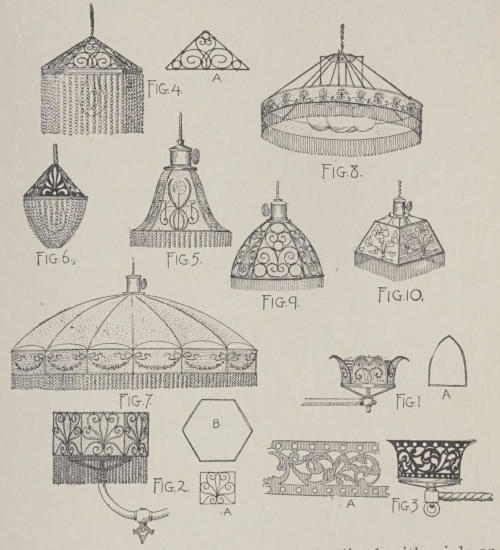
Fig. 1. Fig. 2. Fig. 3. Fig. 4. Fig. 5. Fig. 6. Fig. 7. Fig. 8. Fig. 9. Fig. 10.
In homes where electric lights are used it is often desirable to partly hide or subdue the harsh light from the[136] bright filament within the bulb. A ground-glass bulb answers the purely utilitarian purpose, but there is no reason why the screen should not be decorative also.
In Fig. 4 an attractive design is shown. Four or five triangular wire frames are made and filled with wire ornaments, as shown at Fig. 4 A, and they are caught together at the sides so that they will form a cap, or hood, over the bulb. A band of thin sheet-lead is run around the edge, and to it the glass-bead fringe is sewed fast through small holes that may be punched in the metal with a fine awl.
The cap is lined with silk, and the beads should correspond with it in color.
In Fig. 5 a bell-shaped shade is illustrated. It is made up of five sections, as described for the gas-shade in Fig. 1.
The ornament may be embroidered or painted with water-colors, or the sides may be left plain. A line of short glass-bead fringe around the bottom will add to the appearance of the shade.
In Fig. 6 the cap is cut from thin sheet-lead. The four or five separate parts are caught together at the edges with fine wire drawn through small holes, and all the metal-work is painted black.
Long glass-bead fringe is attached to the lower edge of the cap, and the ends are caught together at the bottom.
For a dining-room, where a cluster of lights is used, a good idea for a dome-shaped shade is shown in Fig. 7.
This is made from a silk parasol lined with white. In order that the ribs may hold it in shape, saw off the stick just below the catch and pass the electric-light wire through the silk at the middle of the top.
A number of panels are made of the same width as the distance between the ribs; they are caught to each other and to the end of each steel rib with fine wire. The panels are made of wire and covered with thin China silk, which is ornamented with garlands and ribbons, either embroidered or painted on, as shown in the drawing. Glass-bead fringe should depend from the lower edge of these panels, and it should match in color the silk of the parasol and the panels.
Another idea for a dining-room fixture is shown in Fig. 8.
It consists of two wire hoops held about six inches apart, the edge of a band of embroidered silk being caught over each hoop. These hoops are suspended from a circular disk of wood, which in turn is supported by means of the flexible wire that conducts current for the light. The bulbs are enclosed in frosted glass globes, three or four of which are suspended in a cluster at the centre of the hoop. A long silk or a glass-bead fringe ornaments the lower edge of the band.
Another way of arranging this fixture is to carry the globes to the inside of the band. From four to seven of them may[138] hang just inside the band, which, in that case, may be made seven or eight inches wide instead of six inches.
The globes should be of a size to accommodate eight-candle-power lights.
In making any of these shades it would be well to cut the forms from card-board, and paste them together to form a pattern from which to shape the metal parts.
In Fig. 9 a canopy of thin metal strips and silk is shown.
The strips are cut from thin stove-pipe iron, brass, or copper. The soft metal is preferable to the hard, or spring, brass, as it can be more easily bent and it will keep the shape better. A paper plan may be drawn of one section, and the small scrolls fitted over it, then banded together with fine wire. The bottom of this canopy is round, but the six sides are slightly flattened at the middle, half-way between the top and bottom.
The inside of the canopy is lined with light silk, and silk or glass-bead fringe is attached to the lower edge.
Fig. 10 shows a simple shade made of four panels composed of covered wire and thin silk. The ornamental design may be embroidered, or painted or cut from colored silk and sewed on.
This shade may be suspended from the socket by means of silk cords or wires, and the open spaces at the top will permit some light to glow above the shade.
In this era of practical craftsmanship there is a field for any unique art that savors of originality and which will help to beautify the home and its furnishings.
Relief etching is one of these arts, and is a very old one, having been employed by the workers on King Solomon’s temple, and perhaps in earlier historical buildings. That was before the time of chemical treatment, however, and when the beautiful effects were obtained by laborious hand-work, a modification of which is handed down in the Turkish, Russian, and Oriental hand-etched brasses and silver goods.
Modern science and chemistry have superseded the old method, and many beautiful pieces of relief etching are produced by the acid process, which is much more beautiful in some respects than the tool-work. The process is very simple, and any boy can become master of the art in a short time and at a very moderate cost.
The equipment necessary to the work will be a tray for the acid bath, a small can of asphaltum varnish, three or four camel’s-hair brushes of assorted sizes, a bottle of nitric acid, and some pieces of sheet brass or copper less than one-eighth of an inch in thickness.
For the acid bath a photographer’s porcelain or hard-rubber developing-tray will be just the thing, but if not available a good pine or white-wood tray can be made with sides two inches high.
To protect the wood from the action of the acid, the tray should be treated to several successive coats of asphaltum varnish—one each day until the wood is thoroughly coated and the joints well filled. The wood should be half or three-quarters of an inch thick, and screws should be used at the joints and laps. A tray of this description can be made at home, and when finished it should appear as shown in Fig. 1. If the varnish is too thick when applying it, a little turpentine will thin it properly.
Small, flat subjects are best to begin with, such as hinge-plates, panels, escutcheons, or tablets. For a drawer panel, Fig. 2 shows an attractive and simple design that may be drawn on the metal with pen and ink. If the ink creeps, the surface of the metal may be roughened slightly with fine emery cloth.
With the asphaltum varnish the design is then filled in so it will appear as shown in Fig. 3 and allowed to dry, when, as a precautionary measure, another coat should be given over the blackened surface, to avoid the possibility of the acid biting through the thin places, or where the varnish has missed the metal. The back and edge of the metal is coated also, to prevent the acid from eating into it.
All the surfaces of the metal not covered with the varnish will be eaten or etched away and left with a granular surface resembling fine sand-paper, while the painted or protected parts will be left intact and with a smooth[141] surface like the original face of the plate, as shown in Fig. 4.
With an old woollen cloth dipped in turpentine, the surface of the plate may be rubbed, after first washing off the acid. The black removed from the ornament will tint the granulated surface of the background and lend relief to the bright surface of the ornament.
Almost any objects in metal, such as door-hinges, knobs, fireplace hoods, name-plates, vases, candlesticks, panels, and tablets, can be decorated by this process, and if artistically done the results will be very effective.
Sheet brass and copper may be purchased at large hardware stores or supply houses for thirty cents a pound, and the sheets or panels can be cut there with the shears to the exact size required. For the average work, metal not more than one-sixteenth of an inch thick will be found easy to handle; but for large panels or name-plate, pieces about one-eighth of an inch thick are preferable.
If the design shown in Figs. 2, 3, and 4 is too elaborate for the beginners, some simple outline may be drawn, perhaps a flower design, copied from some piece of embroidery work, or a figure design from a wall-paper, carpet, or dress-goods pattern. The metal should be left to dry for at least an hour after being painted with the varnish before it is placed in the acid bath.
The etching is done by placing the plate, face up, on the bottom of the tray and covering it with acid. The ground-work or unpainted portions of the metal may be bitten to[142] any depth, but it is not desirable to cut away too much, as it weakens the plate and cuts under the ornament, unless it is carefully stopped out all around the edges of the design; and that is too much of an undertaking for the young craftsman, since it requires a great deal of time and careful work.
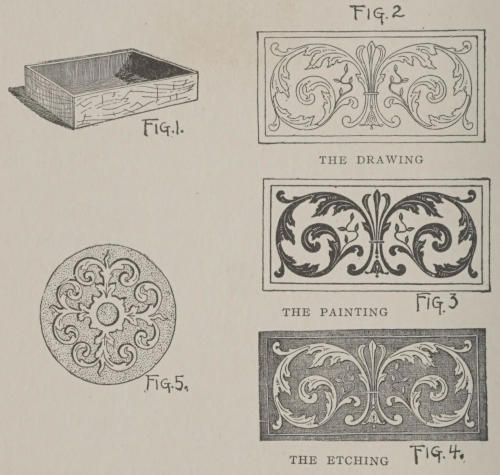
Fig. 1.
Fig. 2. THE DRAWING
Fig. 3. THE PAINTING
Fig. 4. THE ETCHING
Fig. 5.
A little practice will determine just when the plate should be removed from the solution, either for examination or final cleaning. Soft brass or copper corrodes much faster than hard metal, which takes about three times longer, and[143] the process of corrosion will require from twenty minutes to an hour, according to the temper of the metal and the strength of the acid solution.
To prepare the acid solution obtain a large, clear glass bottle and fill it quarter full of pure water; into this slowly pour an equal quantity of nitric acid, taking great care not to spill any of the acid, as it acts instantly and will eat a hole in any cloth it falls upon or spatters over. Wear old clothes and a canvas apron when mixing or handling the acid, and never be in a hurry to get results quickly by the reckless use of the biting fluid. If perchance the acid should touch the clothing, apply a few drops of ammonia to the spot immediately, to neutralize the acid and stop its action. The spot should then be sponged with clear water and no stain will be perceptible.
As the acid is added to the water (never add the water to the acid), shake it occasionally to thoroughly mix it, and let the mixture stand for a while to cool; then place a rubber cork in the bottle, label it Nitric Acid Solution—POISON, and place it beyond the reach of small children.
A solution that has been used should be poured from the tray into another bottle, to be used again by adding a small quantity of fresh solution. An old solution does not act as quickly as a new one, but for soft metal plates it is preferable, as it does not require such careful watching. The fumes of the acid, when at work, are disagreeable, so if possible it is well to carry out this part of the process in the[144] open air. After the plate is immersed in the acid, do not handle it with the unprotected fingers.
Rubber gloves may be used for this purpose, but if a pair cannot be had the plate may be raised from the tray bottom by means of a small, sharp-pointed stick, and it should then be grasped with a pair of pliers and immersed in water to stop the action of the acid. A plate may be repeatedly removed from the bath to watch the progress of the etching, but in doing so it must be handled with care, in the manner just described.
When the ground is etched deep enough, remove the plate from the acid and give it a thorough washing in clean water; then with a soft cloth dipped in turpentine rub off the entire surface of the plate. The turpentine will dissolve the varnish and leave a film of it on the granular surface of the metal eaten by the acid. As a result, the ground will be darkened or oxidized, while the parts originally protected by the varnish will be bright and smooth. The high parts can be brightened still more with metal polish, or they may be buffed and lacquered by a metal finisher.
In Fig. 5 the face of a door-knob is shown in its etched state, the pattern being drawn in varnish, as described.
In Fig. 6 the side of the knob in Fig. 5 is shown; that is, if it should have such a flat band all around. Plain brass knobs may be purchased at a hardware store, and if they are lacquered the coating should be removed with alcohol[145] before the etching is done, as otherwise the acid would not eat through the lacquer for some time.
For an acid bath in which an object this shape is to be etched, a yellow earthenware bowl may be used, or a low jar with a wide neck will answer very well. The knob should be suspended in the acid by means of a piece of waxed string tied about the shank.
Hinges on cabinet doors may be greatly improved by making brass straps for them, which should be applied to the wood so that they fit closely against the sides of the hinges.
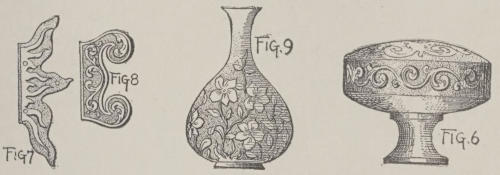
Fig. 6. Fig. 7. Fig. 8. Fig. 9.
Designs for hinge-straps are shown in Figs. 7 and 8, and Fig. 9 is a brass vase on the outside of which a floral design has been etched.
Another design for the face of an oval brass door-knob is shown in Fig. 10. This is a simple pattern to draw on a knob with asphaltum varnish, and its plain but bold ornament is quite as pleasing to the eye as a more intricate pattern would be.
A design for a short, high hinge-plate is shown at Fig. 11, and at Fig. 12 a long, narrow hinge-plate or hasp-strap is depicted. Many other shapes of hasps and the patterns[146] to ornament them may be designed by the boy with some artistic ability, and he may be able to improve upon these suggestions.
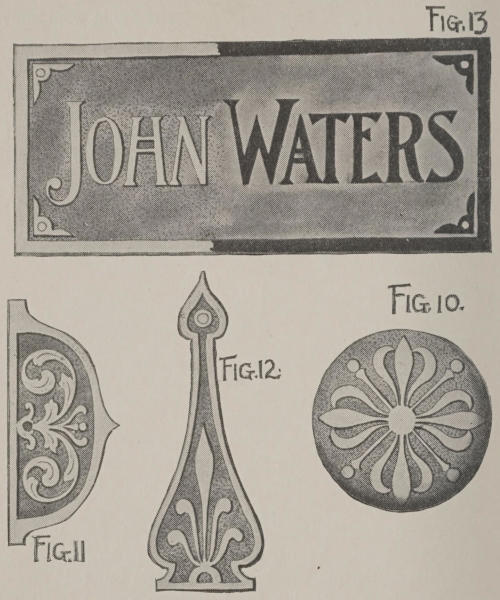
Fig. 10. Fig. 11. Fig. 12. Fig. 13.
When making hinge-straps, escutcheons, or any articles[147] from brass plates or flat brass and copper, the edges should be shaped with a cold-chisel and mallet on the upturned face of an old flat-iron. The uneven or ragged edges may be trimmed off with a file and finished with emery cloth.
An idea for a name-plate is shown in Fig. 13. This is seven inches long and three inches wide. It is appropriate for a front door or the door of a boy’s room, changing the name, of course, to that of the proper person.
At the left of the drawing the finished plate is shown, while at the other side the blackened letters and marginal line is depicted, illustrating how the plate will look before it is etched. Or this last may be the appearance of the plate after it is etched and before the varnish has been removed with turpentine and a cloth.
The boy on whom nature has bestowed the natural talent and liking for art-work will find clay-modelling a fascinating and pleasing branch to follow.
To become a perfect modeller, and finally a sculptor, requires years of patience and perseverance, but to copy simple objects in clay is not a difficult matter, and with some clay, a few tools, and the skeletons, or supports, the amateur should not meet with any great obstacle if the following descriptions and instructions are accepted and practised.
Very few tools are necessary at the beginning, and Nos. 1, 2, 3, 4, 5, 6, 7, 8, 9, 10, and 11, shown in Fig. 5, are a full complement for any beginner. The first four are wire tools, made of spring-steel or brass wire, about which fine wire is wrapped. The ends of the wires are securely bound to the end of a round wooden handle, and sometimes, for convenience, two ends are made fast to a single handle. These tools are called “double-enders,” and are used in roughing out the clay in the first stages of the work. No. 5 is a boxwood tool with one serrated edge, and is used for finishing. The tools shown in Nos. 6 and 7 are of steel, and are of use on plaster, where others would not be sufficiently durable. Nos. 8, 9, 10, and 11 are boxwood tools, a wire loop being fastened in the end of No. 9. Any of these tools can be purchased at an art-material store for a few cents each, except the steel tools, which are more expensive.
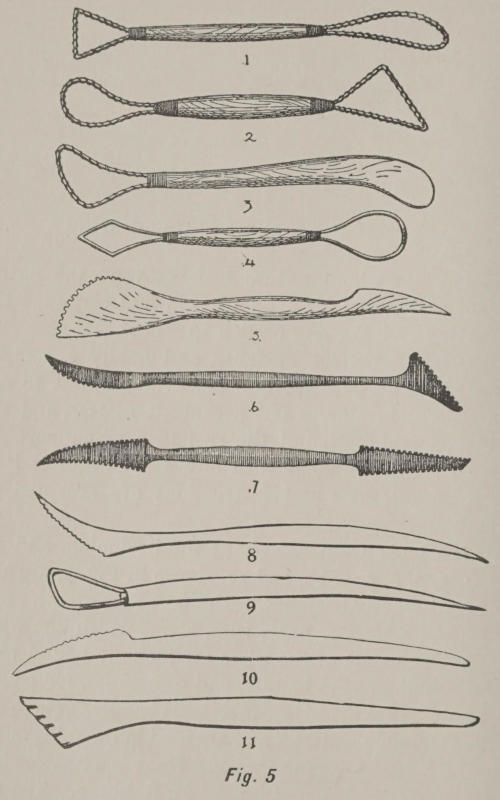
THE TOOLS
Fig. 5.
A stand, or pedestal, will be necessary on which to place the clay model, unless perhaps it should be a medallion, which may be worked over on a table.
Fig. 6 is a stand that can be made by any boy from a few pieces of pine two inches square and a top board one and a half inches in thickness. It is arranged with a central shaft that may be raised or lowered, and to the top of which a platform is securely attached.
The movable shaft should have some holes bored through it from side to side, through which a small iron pin may be adjusted to hold the platform at a desired height. Clay can be purchased at the art stores by the pound, or in the country a very good quality of light, slate-colored clay may sometimes be found along the edges of brooks or in swampy places where running water has washed away the dirt and gravel, leaving a clear deposit of clay of the consistency of putty.
Supports which the clay models are built upon can be made of wood and wire, as the requirements necessitate. That for the head is shown in Fig. 1. Nearly every clay model of any size will need some support, as clay is heavy and settles, and if not properly supported will soon become distorted and the composition spoiled. You will also need some old soft cloths that can be applied wet to the clay, a pair of calipers, and a small trowel or spatula.

Fig. 1. Fig. 6.
To model well the art of drawing is indispensable. The art of wood-carving is also a valuable one to the clay-modeller, but care must be taken when making any casts of wood-carving to use glue moulds; otherwise the carving would become firmly embedded in a plaster mould, due to the undercut in the carved ornament. To begin with, choose some simple object to copy, such as a vase or some small ornament; then, when a satisfactory result has been obtained,[155] select something a trifle more difficult, such as a hand or foot.
When copying a head, obtain a bust support on which to work the clay. A very simple and strong one can be made from a piece of board, two sticks, and a short piece of pipe wired to the top end of the upright stick (Fig. 1).
To carry out the proportions of a bust similar to Fig. 4, the clay should be packed about the support much after the manner shown in Fig. 2. This will support the clay.
With a lump of clay and the fingers form the general outline, as shown in Fig. 2, for the head; then, with the wire tools, begin to work away the clay in places, so as to follow the lines of the model. With the calipers measurements may be taken from the plaster head and used advantageously in the building up of the clay model. Turn the plaster model and clay copy occasionally, so that all sides may be presented and closely followed in line and detail. Fig. 3 shows the next stage, and Fig. 4 the completed head.
Modelling differs from drawing and painting in that every side of the model is visible, while only the face of the painting is presented to the eye, the impression of form and outline being worked out on a flat surface.
Having successfully mastered the head, next attempt a foot from a plaster cast. Afterwards a more elaborate subject, such as a whole figure, can be tried.
With the wire modelling-tools and the fingers begin to work away the clay to obtain the general outline and form; continue this in a rough manner, until a perfect composition is obtained that compares favorably with the original model;[156] the finishing-touches may then be applied, and the detail worked up more carefully.
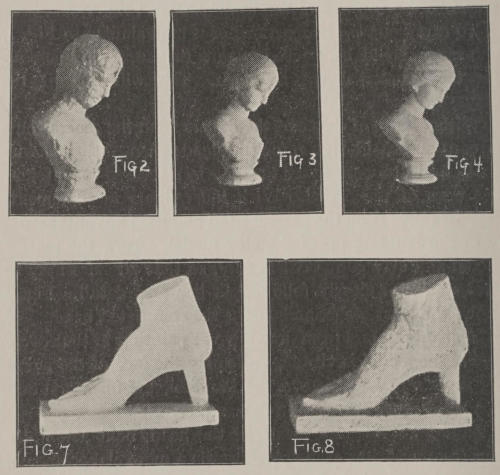
Fig. 2. Fig. 3. Fig. 4. Fig. 7. Fig. 8.
Never complete one part and leave the remaining ones until later; always work up the model uniformly, adding a little here and there, or taking away, as may be necessary, and so developing the whole composition gradually.
Moisten the clay occasionally with water sprayed on with a small watering-pot or a greenhouse sprinkler, to[157] keep it soft and ductile. When not being worked upon it should be covered with wet cloths, to keep it moist.
As the work progresses the clay may be allowed to harden and consolidate, but not to dry; if allowed to dry entirely the model may be considered ruined, as the shrinkage of the clay around the support results in fissures and fractures that cannot be repaired.
By the time the amateur has acquired the knowledge to attempt a full-size figure he will be able to invent the devices to support it.
The support, or skeleton, must of course be adapted to line with the pose of the figure, and should be of pipe and heavy wire or rods securely anchored to the base-plate.
The composition of flowers, fruit, foliage, animal life, and landscape is an inexhaustible one, and some beautiful effects can be had in flat-work. Good examples of this character of work may be found on all sides, and to the genius the field of modelling is a broad one—without limit.
When casting from hands, feet, or ornaments where undercut predominates, the most successful mode is in the use of gelatine or glue.
To cast a head similar to the one shown in Fig. 4 it will be necessary to make a box frame large enough to hold the head.
The cast is to be well oiled, and down the front and back, running around under and back over the base block, strong linen threads are to be stuck on with oil. Warm glue or[158] gelatine is then poured in the box and left to chill and solidify.
When sufficiently cold the frame may be removed, leaving the solid block of glue like hard jelly; then the ends of the threads are to be grasped and torn through the gelatine, thus separating it in two or three parts. The plaster head may then be removed, and the mould put together again and surrounded by the frame to hold it in place.
To make a plaster head this plaster of Paris may be poured into the mould and left for a while, when, on removing the frame and taking the glue mould away, a perfect reproduction of the original head will be found.
When very large objects that would require a great deal of plaster are cast, they are generally made hollow in the following manner:
Obtain the glue mould by the process described, and into it pour a quantity of thin plaster, having first oiled the surfaces that come in contact with it. Turn the mould about and upside down, so that the plaster will enter every part and adhere to the glue form. Allow it to “set,” and again pour some plaster into the mould. This will adhere to the first coating, and after it has set repeat the operation several times, until a deposit, or coating, an inch or more in thickness has been made.
The glue mould on being removed will reveal a perfect plaster-casting that, instead of being solid, is hollow, and in consequence is much lighter.
To model a foot from a plaster cast, as shown at Fig. 7, it will be necessary to lay or putty up the form in the rough, as suggested for the bust in Fig. 2. Now rough out the form with the modelling-tools, so that it will appear as shown in Fig. 8. A frame, or support, should be made from a block and a stout piece of wire, as shown at Fig. 9, so that the mass of clay, particularly that at the back of the foot, will not settle.
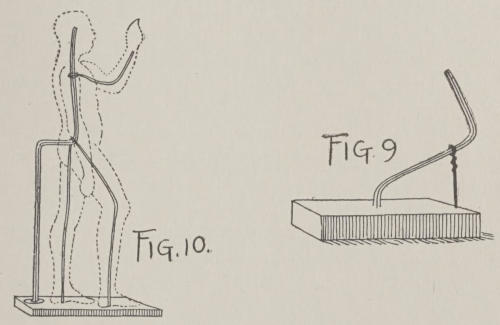
Fig. 9. Fig. 10.
For full-length figures it is always necessary to construct a frame after a rough front and profile drawing has been made. With this drawing in sight, it will then be a comparatively simple matter to construct a wire or iron pipe frame such as that pictured in Fig. 10.
Bas-relief work is another interesting department of clay-modelling. This is one-sided in its effect, and the full, rounded appearance of the statue or bust is reduced to a more flattened form with lower relief. A familiar example of bas-relief is the head on a silver dollar, or the raised ornament on silverware and pottery. Let us now begin with the group of pears and leaves illustrated in Fig. 11.
A small block or piece of wood is treated to a coat of shellac or paint; then the clay is puttied on to roughly form the parts in the group. With the modelling-tools the outline and form is gradually worked out; then the surfaces are smoothed down, and the few little artistic touches given here and there to lend life and character.
Bas-reliefs can, of course, be cast any size, and from the original plaster mould many duplicates in composition or papier-maché may be made.
Garlands, festoons, sunbursts, panel ornaments, and cartouches can be modelled in clay, and afterwards cast for architectural features in interior decoration. A good example of the garland is shown in Fig. 12. This is made up of flowers and ribbons, and with careful and patient work the boy sculptor should be able to obtain results quite as pleasing in detail as that illustrated.

Fig. 11. Fig. 12.
After some experience in casting ornaments in bas-relief has been obtained, it would be well to try a head or bust.
A simple method of doing this is to take an ordinary school slate and make the outline of a head on it. Within this outline you build up roughly with your finger and thumb a cake of clay about half an inch in thickness; then with[162] your modelling instruments work it up as accurately as your artistic skill will permit (see Fig. 13).
When in the progress of your work you find it necessary to leave it for a short time, be careful to cover it over with a wet cloth, and if for a long time, put two wet cloths over it, and cover them in turn with a sheet of newspaper. This is necessary to keep the clay from getting hard and unfit for working. If at any time you find the clay getting too stiff, sprinkle it with water shaken from a whisk-broom. To make the moulds of your clay model you will require a little plaster of Paris, some lard oil, and some soap, and then your outfit is complete.
When your clay medallion is finished, build a wall of clay around it of about an inch and a quarter in height, as shown in Fig. 13; then get a teacupful of lard or olive oil, and add to it a good teaspoonful of any kind of soap scraped fine. Put this on the stove and stir until it is thoroughly mixed; then with a soft camel’s-hair brush lay a slight coat over your entire work.
You must now mix your plaster. If the surface of your medallion is, say, one foot by six inches, you will require about two pounds of plaster to about a quart of water. Sprinkle the plaster into the water, and then watch it until bubbles have ceased to come to the surface. When no more bubbles appear, stir it up well with a stick. The mixture should be about the consistency of thick cream. The exact proportions you must find out by experiment. This plaster cream you pour quickly over your medallion, blowing gently with your mouth on the fluid as it spreads itself over the face of your work; this is to prevent the formation[163] of bubbles. In a short time the plaster will become hard; you then remove your clay wall, and lift the plaster mould, or matrix, from the clay. This you do by passing a penknife all round between the plaster and the slate, after which it lifts easily. You have now a perfect plaster mould. If you find any small particles of clay adhering to it, wash them off with a soft camel’s-hair brush and water.
You now want to get a plaster cast from your matrix. To do this you lay a coat of the soap and oil mixture with a camel’s-hair brush all over the face of the mould, and then pour in the plaster just as you did before, taking the same precautions to blow upon the plaster and to build a wall of clay around the mould.
You let this stand for half an hour until it is perfectly set, when you can remove your casting by passing a thin-bladed knife all round between the matrix and the casting. If it does not then lift easily, plunge the whole thing in water for an instant, after which you will have no difficulty in separating the two parts.
You now have a plaster cast of your original work, which you can touch up and finish off with sand-paper, or with the blade of a penknife if necessary.
You can, of course, make as many casts as you please from your mould, and thus have very pretty little souvenirs to present to your friends.
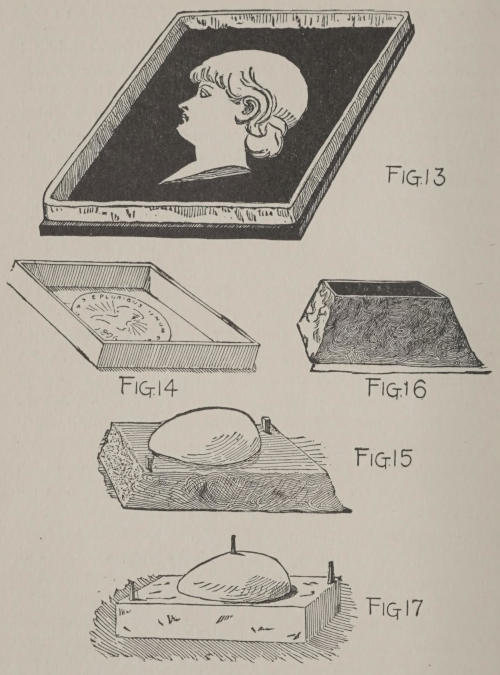
MEDALLION AND PLAIN CASTING
Fig. 13. Fig. 14. Fig. 15. Fig. 16. Fig. 17.
This same procedure may be employed when making moulds and casts from coins, medals, and medallions. A narrow frame is made of wood, and at the middle of this a medal is placed on the flat oiled surface of a board, a slate, or a piece of marble, as shown at Fig. 14. The face of the object is now prepared with the oil, and the plaster is poured as previously described. If any number of reproductions are to be cast from the mould, it would be well to give it one or two coats of thin shellac; then oil it before each impression is made.
It is not a difficult matter to reproduce in plaster almost any object that has no undercut or parts that will not easily detach from a mould. When making them, the first thing to do is to get a piece of board about a foot square; that is to work on, so as not to soil the table. Then you want a lump of clay about as big as a football, five or six pounds of plaster of Paris—it only costs three cents a pound—and a half-dozen wooden pegs. You also want a cup of warm melted lard, or Castile soap dissolved in hot water, to rub over what you are going to copy, so as to prevent the plaster sticking to it.
Now, suppose it is an egg you want to copy. You rub it all over with your melted lard, and lay it down on the piece of board. Pack clay around it as high up as the middle of the egg, and as far out as half an inch from the widest part. You must be particular about not putting clay higher than the middle, because, if you get the clay too high, you can’t get the egg out without breaking the mould.
When you have the clay around the lower half of the[166] model, smooth and level it, and push two pegs in opposite corners, as shown in Fig. 15. Now around the whole thing make a box or case of clay, with sides rising half an inch higher than the model (Fig. 16). Mix plaster of Paris and water together till you have it like molasses on a warm day; pour that into the clay box, so that the model is covered, and the mixture even with the top of the box.
The plaster will set, or become hard, in a little while, and you then tear the box away, and take out the model and plaster together, leaving the first clay mould. Next put the plaster mould and model in a clay box just as you did before, and pour plaster over it, first greasing the model and upper surface of the mould. Before pouring on the plaster, roll a small piece of clay in your fingers, and put it on the model (Fig. 17), so that when you pour plaster over it, a hole will be left in it through which you may pour plaster for the final cast.
For the second time tear away the clay box, and gently separate the two parts of plaster of Paris; take the model out, and you will have two blocks of plaster, which, when brought together, will contain an exact mould of the model (Fig. 18), and one block will have an opening in it through which you can pour plaster. Before pouring in the plaster, however, be sure to grease the insides of the mould. Then put the parts together, using the pegs and holes as guides to a proper fitting, and tie firmly with a piece of twine. Now pour the plaster in, and then shake the mould gently in order to make the mixture settle in all the smaller crevices.
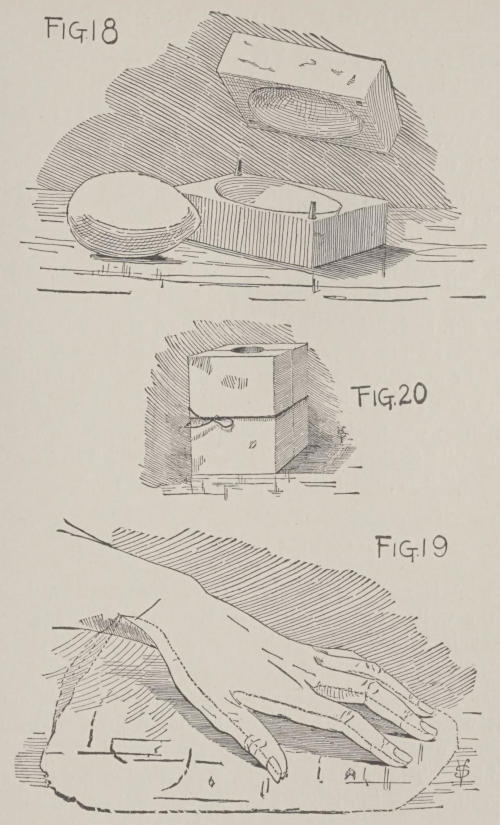
PLASTER-CASTING IN GENERAL
Fig. 18. Fig. 19. Fig. 20.
Of course when you separate the parts of the mould now you will have a perfect cast of your model. It will have a thin ridge running around it where the mould was joined, but that is easily rubbed off with sand-paper.
In a mould made from a hand you proceed in about the same way. The great thing is to find the dividing line in the model; that is, the place where the parts of the mould ought to join. In the egg it is easy enough, for you can divide it into two equal parts; but you take a hand, and you have to make the line around each finger just where it is broadest (Fig. 19), and build the clay up to that line. The wrist-hole in a hand-mould makes a good hole to pour the plaster in (Fig. 20), and, after all, a hand is easy to make.
These simple directions should make it easy for the amateur modeller to acquire the first principles of the art. There are several good compositions in which the young craftsman can work besides plaster of Paris, such as “Kiln Cement,” “Carton-pierre,” “Papier-maché,” “Plaster Compounds,” “Artificial Marble,” and “Concrete.”
There is nothing prettier or more attractive, hanging on the walls of one’s parlor or chamber, than a group of signet impressions in sealing-wax of various colors, artistically arranged and handsomely mounted; while the pleasure to be derived in seeking them is quite as keen as that which the coin or stamp hunter enjoys, without the expense attached to them, for our seals cost comparatively nothing. The outfit is simple, consisting of a dozen sticks of sealing-wax in different colors—black, brown, red, gold, white, and green, making a charming combination with any[169] other shades that take the fancy of the collector. A light wooden or strong pasteboard box to carry the articles, a box of matches, a white taper (cut in half for convenience’ sake), and, later on, a piece of stiff white card-board (16 × 22, 22 × 28 being good sizes) to mount them on.
Keep in the bottom of the box containing the wax a dozen or more pieces of thick, white, unruled writing-paper cut into ovals, circular, oblong, and square shapes, varying in size from one-half inch in width to two inches in length. This is all that is required. Now for our hunt. As you meet friends and acquaintances, notice their rings and watch-charms. When any are discovered with a figure, crest, handsome monogram, or initial on it, borrow it, and make your impression. This is accomplished by laying a piece of your writing-paper, at least half an inch larger than the seal to be used, on some smooth surface like a table. Then take a stick of wax between the thumb and forefinger of the right hand; with the left hand a match or taper, and bring them together just on the paper where the wax melts sufficiently to drop freely. Rub the end of the sealing-wax quickly over the middle of the paper. Then moistening the seal with the tongue to prevent the stone adhering to the burning wax, press it firmly into the hot bed prepared for it, a second or so, being careful to lift it straight up when taken off, thus securing a clean edge. If this is properly done a fine impression of your subject is secured. Repeat this operation several times, taking different-colored wax for duplicates, which will enable you to make exchange with other collectors, who are unable to get these same figures, but have others not in your collection.
Pyrography, or fire-etching, is by no means a modern art, but one that was practised many centuries ago both in civilized and barbarous countries. In Europe, during the early ages, this work was executed with a poker inserted in the fire and heated red hot; but as the iron must have cooled quickly, the task of embellishing a panel was a tedious and laborious one.
A knowledge of drawing will be very helpful to the young pyrographer, as the object can be sketched in lead-pencil and followed with the heated iron or platinum-point.
Of the various materials that may be used on which to etch the ornament, wood and leather have been found the most satisfactory, since they retain the deep, rich brown-and-black tones given by the heated iron, and yield more readily under the tool than other materials.
If wood is employed, such as oak, birch, maple, holly, and cherry, it should be selected with a pretty grain and as free from knots as possible; but if leather is used, a good quality of oak-tanned sole-leather will give the best results; although for light work a pleasing effect can be had by employing a stout Suède and etching on the rough side.
The etching-tools are few and simple, and are shown in the illustrations.
Fig. 1 depicts a set of irons that can be made by a boy from pieces of round iron a quarter of an inch in diameter and having the points fashioned with a file. The ends of the irons can be inserted in file-handles that may be purchased at a hardware store for a few cents each.
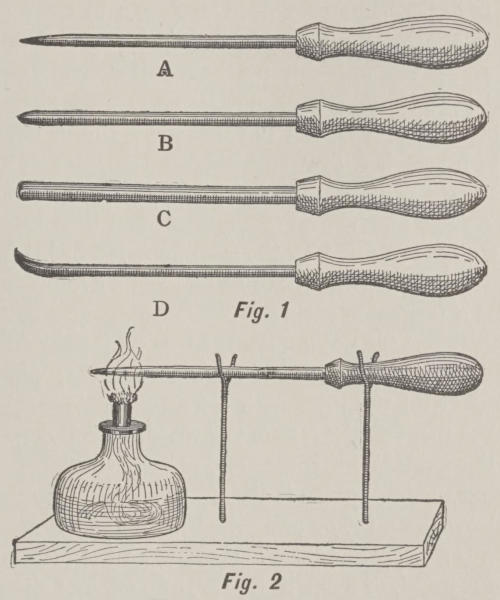
Fig. 1. Fig. 2.
A is a sharp-pointed iron for outlining; B is a round-pointed one for broader work; C is a stub for bold work, and measures three-eighths of an inch in diameter; D is a[172] curved background tool, and is used for burning in the grounds, or shading, in order to make the design stand out boldly.
With these tools and a spirit-lamp and rest, such as is shown in Fig. 2, some very good work can be done; and to complete the set a sharp-edged eraser may be added to scrape away the wood, if perchance it should have been touched by mistake with a hot iron.
To begin with, it is best to carry out a simple design—to decorate a panel, a drawer front, or the sides to a small wooden box. The pattern must first be drawn out in full size on a piece of smooth brown paper, and then transferred to the face of the wood by the use of colored or black transfer-paper, sheets of which can be had at an art or stationery store for a few cents each.
To reproduce the design, lay the transfer-paper face down on the wood, and over it the drawing face up; pin it fast, and go over all the lines with a lead-pencil, bearing down to impress them on the face of the wood. Having gone over all the lines, unpin one corner and raise both sheets of paper to see that the impression is good. If not, replace the paper and redraw the faint or unmarked lines.
Fig. 3 is a simple and attractive design for the embellishment of a panel, of a small drawer, or as one of the sides to a box.
If the tools shown in Fig. 1 are used, fill the spirit-lamp half full of alcohol and light it, then place the pointed iron A on the rest in such a position that the point will be enveloped by the blue flame, where, after remaining a minute, it will become red hot. Remove it and trace the lines in the[173] wood with the hot point until all of them have been gone over, and as a result the wood will have the appearance of Fig. 4. The iron will necessarily require reheating continually, and to save time it would be well to have two or three irons of each shape, as they cost but a few cents, and are easy to make.
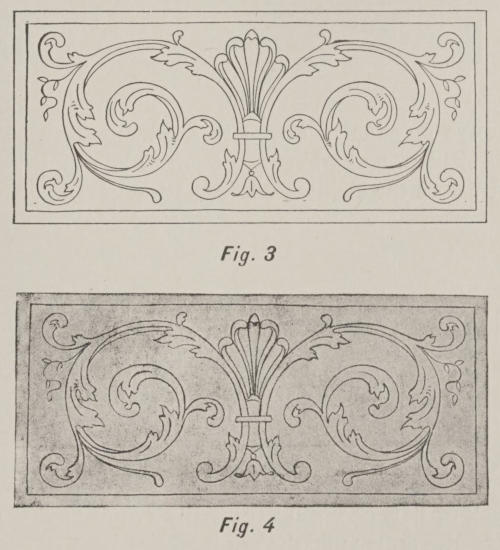
Fig. 3. Fig. 4.
After the outlining has been done, the background should be burned in with the curved iron D. Fig. 5 illustrates the manner in which this may be accomplished; the left side is partly finished, and shows the simple and effective mode[174] of lining or “dragging” the ground. The right side is a finished ground, where the cross-strokes may be seen with an occasional oblique stroke to lend added density. It is not always possible to complete a ground until the ornament is shaded, and what may seem to be a finished background before the shading will sometimes afterwards prove too weak or flat, and will necessarily require going over in places to strengthen and darken it.
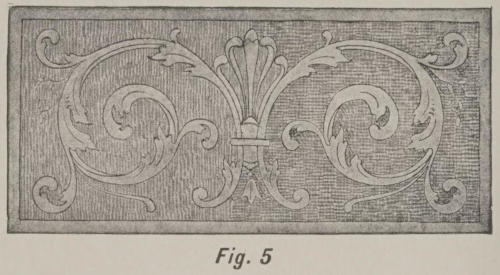
Fig. 5.
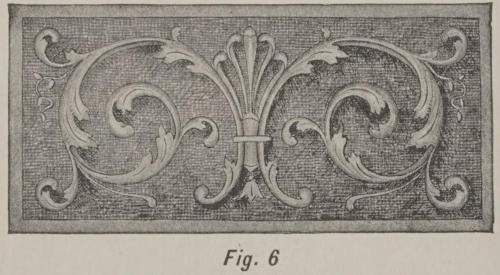
Fig. 6.
Fig. 6 is a piece of finished work where the ornament is shaded to give it character, and where also the background[175] has been retouched in some places to give it a stronger feeling. This illustration is a good example of pyrography, and gives the relative tones of high light and shadow.
Before beginning on an ornamental piece of work, it would be well to practise on clear pine or white-wood, and to become dexterous in the use and manipulation of the tools, and to find the ones best adapted to certain kinds of work. The round-pointed tools B and C, shown in Fig. 1, are good grounders, and where large work and bold patterns are carried out they will be found of use.
As some very fine work is possible in fire-etching, the art can be applied in many ways to decorate pieces of useful and ornamental furniture about the house.
Charming pictures can be produced on holly and white mahogany; designs of fruit and flowers and conventional patterns may be applied to panels, tables, screens, frames, glove and handkerchief boxes; and on maple bedroom furniture designs in pyrography lend a pleasing and artistic appearance.
When working on leather do not cut out the form until after the work is finished, but pin the material flat on a board to hold it firmly while operating with the hot irons.
The entire design should be drawn on the face of the leather with a soft lead-pencil, and afterwards gone over with the burning-points. When the work is completed the piece of leather should be removed from the board, and the outline cut with a sharp penknife or a pair of scissors.
It may be desirable to varnish and polish some specimens, and it is possible to do so by coating the surface with a thin spirit varnish or thin furniture polish. This will bring out[176] the density of the burned lines, and enrich a design that on certain woods might seem flat. Too much varnish must be avoided, and only a very thin coat will be necessary to obtain the desired result.
In preference to the hand-made irons, which must be heated each time before using, the modern devotees of the fire-etching art use the gasolene lamp and platinum-point apparatus. These outfits may be purchased at the art shops for a comparatively small sum, but the young craftsman may want to make his own apparatus. With the exception of the platinum-point and its metal holder, this is quite possible.
The parts of a gasolene outfit are the bulb, rubber tubing, platinum-point and handle, reservoir-bottle, metal union-cork, and a spirit-lamp. The latter may be purchased at a drug or hardware store for a few cents; but a good-working one can be made from a square or round bottle, a cork with a hole through it to receive a piece of brass tubing, and a piece of round lamp-wicking. (See Fig. 7).
Heat a piece of wire red hot, and burn a hole through the cork large enough to slip in a piece of brass tubing a quarter of an inch in diameter. Pass the lamp-wick through the tubing, and allow an inch or two of wicking to rest at the bottom of the bottle. This lamp should be filled half full of alcohol, and it is used to heat the platinum-point at first; after that the rush of gasolene vapor will keep the tool red hot. The gasolene reservoir is a square bottle with a fairly large neck into which is fitted the metal union-cork. If it[177] is not possible to purchase this cork, then one can be made as shown at B in Fig. 8.
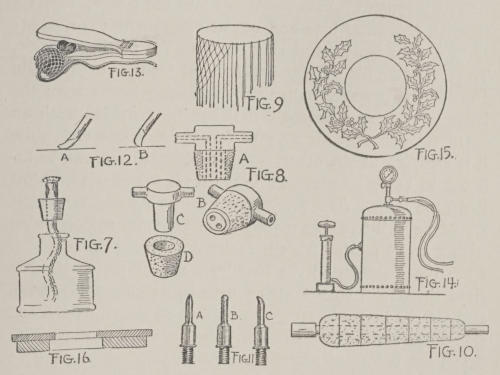
Fig. 7. Fig. 8. Fig. 9. Fig. 10. Fig. 11. Fig. 12. Fig. 13. Fig. 14. Fig. 15. Fig. 16.
From a solid piece of lead one and a half inches long, three-quarters of an inch wide, and one and a quarter inches deep, cut a lug, with a knife and file, having two projecting ears as shown at C in Fig. 8. The lower part is half an inch in diameter and three-quarters of an inch long. With a hot iron burn a hole in a cork so that the lower end of the lug will fit within it, as shown at D in Fig. 8. With a small drill bore a hole in the end of each ear. These holes should run through towards the middle of the lug, taking care, however, not to bore too far, since the holes must not meet.[178] Bore two holes up through the lower part of the lug so that each will meet one of the holes bored through the ears, as shown by the dotted lines at A in Fig. 8. By this construction the air forced through a tube connected with one ear travels through that ear and down into the bottle; then up through the other hole and out at the opposite ear, where another tube is attached that leads to the platinum-point. The end of an old syringe can be used for the supply bulb, and for the pressure bulb there is nothing better than the inner bladder of a football, if it can be provided with an extra tube so that air may be forced in at one end while it is escaping at the other. This rubber balloon can be inflated to twice its normal size if care is taken not to blow it up too large. As a precaution against its destruction, it would be well to make a protective net from cotton string with a small mesh. This is easily done by making a wire hoop the diameter of the bladder when blown to its safe size; then loop cotton string over it, as shown in Fig. 9, and tie the knots forming the meshes as shown at the left side of the same drawing. Continue the work until a cylindrical net is formed about three or four inches longer than the size of the inflated bladder. With a draw-string the open ends of the net can be drawn together after the bladder is placed within it. The outlet of the bladder is connected by a rubber tube to one ear of the cork, and another tube leads from the opposite ear to the platinum-point and holder.
The holder is simply a piece of brass tubing at one end of which a coupling is made fast. This tube is pushed through a cork handle, or the covering can be made by burning[179] holes through corks and slipping them over the tube, at the same time using thick shellac to act as a glue and hold the corks to each other and to the brass tube. The cork covering should be heavier near the point end, because the tube becomes hot from the superheated platinum-point. This handle should be three-quarters of an inch in diameter, and gradually tapered to half an inch at the back, as shown at Fig. 10. The brass tube should be five inches long and the cork handle about four inches in length. Half an inch of the tube projects beyond the back, or top, of the handle, and over this end a piece of rubber tubing is slipped. A complete outfit should contain three points—one sharp, one round, and one curved. These can be purchased at almost any art store, and should appear as shown in Fig. 11, A being the sharp point, B the round one, or grounder, and C the curved, sharp-ended point that is used for fine work and light lines in shading or background.
A good platinum-point can be bought for one dollar and a half; but better ones will cost all the way from two dollars to five. If a boy has points B and C in his outfit, he can do some very good work; but should it be possible to have one only, then the curved point C should be the choice, since with that tool almost everything can be done.
The principle of the gasolene pyrographic outfit is very simple. The reservoir-bottle is filled half full of gasolene, or benzine (62°), which can be had at a paint store for twenty-five cents a gallon. The union-cork stopper is then pushed down, and the platinum-point screwed in place at the end of the handle. Light the spirit-lamp and hold the platinum-point in the flame until it is cherry-red; then[180] squeeze on the supply-bulb and fill the pressure-bag. The air forced through the first section of rubber tubing goes down through one hole in the cork, picks up some gasolene vapor from the reservoir-bottle, and passes along the second section of tubing to the point, where it escapes through a very small hole at the side. Directly the vapor reaches the flame it ignites, and the hot point is kept in its heated state so long as the pressure of the bulb forces the gasolene vapor out through the hole.
Do not bear hard on the wood when working. The heated metal will char the wood easily if gentle pressure and several strokes are used. Points A and B (Fig. 11) can be used on all sides and on end, but point C should be used only on its curved edge, as shown at A in Fig. 12; never as shown at B.
When both hands are needed for the work of holding the material and tool, a convenient foot device can be made, as shown in Fig. 13. This is a pressure-jack made from two boards, the upper one being cut and hinged, as shown in the drawing. The boards are twelve inches long and three inches wide, the short end of the top one being attached to the bottom plate with glue and screws. The wood should be three-quarters or seven-eighths of an inch thick, and it may be given a coat of shellac or varnish to improve its appearance.
If a constant supply of air-pressure can be had without the bothersome hand or foot bulbs, it makes it so much easier to master the art of pyrography.
Any ingenious boy who has a foot pump, such as are used for bicycle or automobile tires, can get an old boiler from a[181] plumber and rig up a pressure-tank such as is shown at Fig. 14. A small pressure-gauge should be screwed fast on top of the boiler, and two outlets with brass cocks should be constructed out of one-eighth-inch gas-pipe, the fittings being purchased at a gas-fitter’s or a supply house. By means of the pump compressed air can be stored in the tank, and the pressure will be registered on the gauge. Twenty to twenty-five pounds will be quite enough pressure for an old boiler, although sixty pounds is the standard to which most of them are tested when new. The advantage of the two outlet-pipes will be appreciated when working, because each can lead to a different sort of point, and this will save the time and bother of changing points frequently for different parts of the work.
Basswood, deal, and white-wood are the material most commonly employed for this work, since the grain is close and the color even. Almost any soft wood, however, can be used, and the boy who has mastered the craft of carpentry can make his own boxes, frames, stools, chairs, and miscellaneous wooden objects, and then embellish them with designs drawn in lead-pencil, the lines of which it will be an easy task to follow with the hot platinum-point.
Small picture-frames can be made from one piece of wood, but they are better, and will last longer, if made from two pieces. For a small round frame a pretty pattern is shown in Fig. 15. This can be made from six to twelve inches in diameter, and the frame proper should be from two to four[182] inches wide, having an opening for the picture from two to four inches in diameter. The easiest way to make a frame is in two pieces, as shown in Fig. 16, the left side representing a narrow frame and the right a wider one.
From holly or basswood one-eighth or one-quarter of an inch thick cut a disk six inches in diameter, and at the middle cut an opening three inches in diameter. Strike the circle with a compass; then use a fret-saw to do the cutting. From pine or white-wood half an inch in thickness cut a disk five and a half inches in diameter and at the middle a hole four inches in diameter. Lay the thin disk down on a table, and after applying glue to one surface of the smaller but thicker disk place it, glue-side down, on the larger disk, taking care to have the grain of the two pieces run in opposite directions. See that the disks are adjusted so that one is centred directly over the other; then impose a piece of board on top of the frame, and put fifteen or twenty pounds of flat-irons or other heavy weights on the board to press the two wood pieces together. Leave them for several hours; then remove the weights and clean off the hard glue that may have oozed out from between the disks. Give the back of the frame two coats of shellac to prevent the wood from absorbing moisture, and it will then be ready for the design and the pyrographic ornamentation. By using the two pieces of wood, a rabbet is thereby formed for the glass and picture. If the frame had been made from one piece it would have necessitated the cutting of a rabbet. The design of holly leaves and berries is a pretty one, and quite simple to draw and burn.
A long picture-frame with three oval openings is shown in Fig. 17. This is made from two pieces of wood, as described for Fig. 15, and then embellished with the design and pyrographically treated.
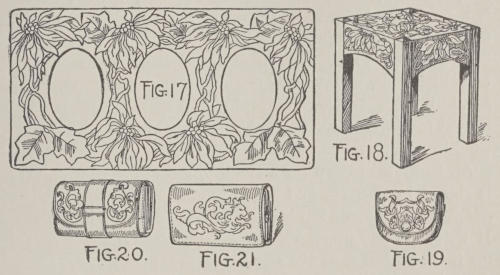
Fig. 17. Fig. 18. Fig. 19. Fig. 20. Fig. 21.
In Fig. 18 an idea for a stool is shown. This little piece of furniture can be made of white-wood by the boy who has learned to handle tools. The legs are two inches square and fifteen inches high. The side-boards are each twelve inches long, four inches wide at the ends, and three inches at the middle; they are arched or crowned, as shown in the drawing. Blocks of wood are glued and screwed to the inner edge of each end, and these in turn are made fast to the upper parts of the legs. The top is sixteen inches square, with the corners cut out, so that it will fit down on the top[184] of the side-rails and between the tops of the legs. Strips of wood three-quarters of an inch square should be glued and screwed to the under side of the seat at the four sides, and these in turn must be made fast to the top inner edges of the side-rails.
When embellishing leather, select the quality that is best adapted to pyrography. It must not be too thin, as the hot point would quickly perforate and cut it. Cowhide, Suède, calf, sheepskin, heavy kids, and binding leathers are best adapted to this work. Purses, bags, mats, boxes, travelling-rolls, and valises are made in leathers that are admirably adapted to pyrography, and these should be purchased rather than made, for leather-working is a craft that would not interest the average boy.
An heraldic pattern for a small pigskin or cowhide purse is shown in Fig. 19, and Figs. 19, 20, and 21 are designs adapted to different kinds of purses, wallets, and bill-books. It is, of course, impossible to lay down any specific sizes for these patterns, as the sizes of leather goods vary.
To improve the appearance of floral patterns, it is desirable to tint or stain flowers, leaves, berries, and stems in their natural colors. This can be done on the unfinished wood, either before or after the outlines and background are burned. Oil or aniline stains may be used for this purpose. If a dead finish is desired, the wood can be left without further treatment, except for a thin coat of beeswax and turpentine. If a glossy finish is preferred, the wood must be treated to several thin coats of white[185] shellac; then a finishing coat of white dammar-varnish is applied and left to dry for several days. The inside of boxes should be “grounded” and shellacked, and at the top and bottom pads made of card-board, cotton-filling, and silk should be glued fast.
There must be many boys who would like to know the simple methods of binding books, so that they can do it without the aid of machinery or costly tools. They are probably aware that when the material of a book comes from the hand of the printer, it consists of a number of large sheets that are commonly twenty inches long and fifteen broad. Eight pages of the book are printed on each side of a sheet in such a peculiar order that when the sheet is properly folded the pages will be correctly arranged by the numbering. To see how this is, take a sheet of paper that measures fifteen inches by twenty. With a ruler and pencil draw lines across the sheet so as to divide it into eight equal parts. Each of these parts is a page. Number them as shown in Fig. 1. Turn them over and number the pages on the other side as shown in Fig. 2. Now to fold the sheet, lay it on the table with the side up that has on it 2, 15, etc.; bring page 3 over upon page 2, creasing the sheet in the middle. Then the four pages lying upward will be numbered 4, 13, 12, 5. Bring page 5 over on page 4, and crease in the middle again. Pages 8 and 9 will now lie upward. Fold 9 over on 8, and the sheet will be folded as it should be,[187] and is now called a signature. In a book there may be twenty or thirty, or more such signatures, which are numbered so that the binder will know in what order to place them. These numbers are placed at the bottom of the first page in each signature.
Before beginning the work of binding, a few preparations must be made, and first of all a press is indispensable. This is very easily made. Take two pieces of board, of some close-grained hard-wood, about one and a quarter inches thick and a little larger than any book you are likely to undertake to bind. Eighteen by twenty inches will be found the most useful size. Lay your boards together, and with an inch auger bore through both three holes at each end of the boards about an inch back from the edge. Now make six pegs of hard-wood—white oak is excellent—about six inches long, and fit them tightly into one of your two boards, on one side of it; that is, the pegs should all stand out at one side. (Fig. 4.) When this is done, carefully work down the size of the pegs until they will pass freely through the holes in the other board, so that the two boards may be separated or brought close together as required. The loose or movable board (Fig. 5) should be fitted with a backstay or two, so that it will stand edgewise on a table, and the two boards together will thus form a sort of upright press or vise.
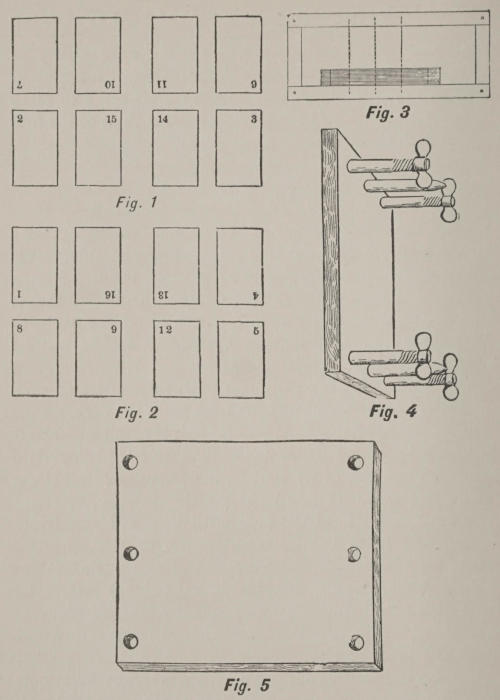
THE PRACTICE OF BOOKBINDING
Fig. 1. Fig. 2. Fig. 3. Fig. 4. Fig. 5.
In order to furnish your press with power, you must now pass four large iron “wood-screws” loosely through the blank outer edge of the movable board into holes in the corresponding edge of the other board, where they should “bite.” When a book is put into the press it is a very easy matter to tighten the screws so as to hold it firmly. This simple, inexpensive, and easily made press may be improved in various ways; screws with winged nuts may be used, etc., but in its simplest form it will be found sufficient for all the demands the amateur binder is likely to make on it.
Next in importance to the press is the hammer, and this is the only tool you will be likely to have to buy. It should be heavy, weighing at least twelve or fourteen pounds, and should be rounded at the ends. This is used for beating and compressing the books, shaping their backs, etc. If you live near a foundry it is quite easy to make a model of wood or clay and have a hammer cast. In any case, it is not an expensive tool—any blacksmith can hammer one out in a short time.
The glue-pot may be almost any little crockery dish, but it should never be put on the stove. If you have no regular glue-pot, you can melt your glue in an old cup placed in a saucepan of boiling water.
Besides the press, hammer, and glue-pot, you must have a pair of scissors and a few simple but sharp-cutting tools. When these things are all prepared you are ready to bind your book.
After removing everything that is not to be included in your volume, place the “signatures” or parts together in regular order, striking the backs gently on the table or bench[190] to get them even. Then place them on a block and beat with the hammer so as to flatten and compress them as much as possible. Then they should be put very carefully into the press and the screws tightened firmly, so as to hold the volume steady. The back should project about one inch above the edge of the press. Now, with a common hand-saw, cut four slits across the back at regular intervals, not deeper than the teeth of the saw. Take the book from the press, and into each of these slits or nicks lay a piece of stout cord or twine (not too thick), and to these cords all the signatures forming the book must be fastened with pack-thread. A necessary aid to this sewing process is a small square frame of light wood. The cords must be tied to this below and above, as shown at Fig. 3, and the lower part of the frame must be sufficiently broad and flat for the book to lie upon it. After the cords are laid into or passed through their respective nicks, you must open the leaves regularly and find the middle of each signature, and then pass, with a needle, the pack-thread along the inside, but twisting it around each cord in succession as you go along, making it fast at the end with a hitch or knot. This is much easier than it sounds, and with a little practice may be done very quickly. When you have finished the sewing cut away the cords, leaving an inch and a half or so on each side, which is left to make the attachment to the cover. This completes the first stage of the binding.
The book must now be replaced in the press, and its back covered with a good coat of glue melted in the manner already described. Leave it in the press until the glue is thoroughly dry. In the mean time measure the breadth of[191] the back and go ahead with the preparation of your cover, which may be made as follows:
Cut two pieces of thin pasteboard a little larger than your book. Also cut a piece of cloth—calico, linen, or muslin—so much larger than both pieces of pasteboard either way as to allow for the back and the turning in. Down the middle of this paste three or four strips of the same goods to strengthen the back. Carefully measure the length and breadth of the back, and lay your pasteboard covers on the table, leaving the space of the back between them. Now put on your cloth, turning it around the edges of the covers, carefully avoiding creasing or wrinkling, and lightly glue it fast as shown at Fig. 10. Your cover is now made and must be allowed to dry. Next take your book from the press, unravel and soften the projecting ends of the cord, and wet them with strong glue. Lay the book down carefully on its back into the cover and glue down the cords to the sides. The book should be supported in this position, which can be done in any number of ways, and a slip of cloth glued down over the cords to hold them steady. Then paste over all this a sheet of white or fancy paper to line each cover, and when the job is dry your work is done.
Nothing has been said about cutting the edges of the book, as that is usually done on a machine; but if you are able to trim them clean with a sharp knife, so much the better. To do this, place the book into the press before putting on the cover, bringing up each edge of the three exposed ones successively, and while held there firmly, cut them carefully with a sharp knife or shoemaker’s cutting-tool. Any little inequalities may afterwards be taken down with sand-paper.[192] The edges when cut may be spattered with any color desired by using a common tooth-brush and water-colors.
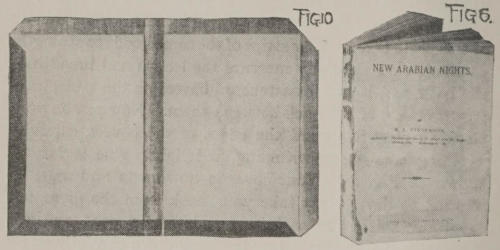
Fig. 6. Fig. 10.
To put on the title in gilt letters, the binder applies a little of the white of an egg over the space where the letters are to be. When this is dry, rub the leather with a rag slightly greased, and then lay on the gold-leaf. Next take common type used by printers, heat them a little, and stamp on the letters. The heat makes the gold-leaf stick where it is wanted, and the rest is rubbed off with a rag. All the gilt ornamentation on book covers may be put on in a similar manner.
To get a clear understanding of these directions the boy craftsman should examine different kinds of books very closely; and if he has an old and valueless one he can take it to pieces and put it together again. Perhaps he can improve its condition. At least he will learn some of the minor details. He must remember that in bookbinding, as in all other arts, patience and repeated trials are requisite[193] for acquiring the skill that produces neat and handsome work.
It is not always possible for a boy to purchase cloth-bound volumes of his favorite authors, as they cost quite a little money. But he may often procure them in paper covers, and if he is careful to select stitched books, rather than those simply caught together with wire or “wire sewed,” as they are termed, it will be possible for him to rebind them in cloth at a slight expense.
To begin with, strip off the paper cover, taking care not to tear the printed title on the cover, nor that at the back of the book, if it is possible to save it. Both of these will be useful in the rebound volume. With a penknife and sand-paper remove as much as possible of the paper cover that has been glued to the back of the book, taking care not to cut away any of the stitching; otherwise the book would fall apart. The book in this condition, ready for its “case” or cover, is shown in Fig. 6. If the signatures have been caught together with wire, remove the latter with a pair of pliers; then sew the pages as already described. Get two pieces of white paper the same thickness and quality of which the book is made, and fold them over once, as shown in Fig. 7. With paste or liquid glue attach one at each side of the book by running the paste along one side of the folded edge of paper for a quarter of an inch, as shown by the shaded line in Fig. 7. This is called “tipping,” and where a page or two have become detached or not properly bound in, this method is employed to reset it.
When these pages are in place, trim them so as to correspond to the size of the book; then glue the back of the book well and attach a piece of crash to the back as shown in Fig. 8. The crash should be a trifle shorter than the height of the book, or about half an inch at each end, and there should be at least an inch of the material on either side of the book, as shown in the illustration. This material is known as “crash” in the bookbinding trade, but it is nothing more than a coarse-thread cloth with open mesh, and it is sold in dry-goods stores under the name of crinoline.
From clay-board or stiff card-board, binders’ board, or strawboard, cut two pieces an eighth of an inch wider and a quarter of an inch longer than the actual size of the book. These are for the front and back corners. Lay the binding material—buckram, cloth, or leather—on a table or smooth board face down. Now, with a lead-pencil, mark two parallel lines through the middle, as far apart as the thickness of the book plus the thickness of the covers, as shown at A A in Fig. 9. Then mark a line across one end at right angles to these, as shown at B. Apply glue to the covering material and place the card-boards on the spaces C C, so that the inner edge and top of each board will line with the pencil-marks A and B. Press the boards down with the fingers; then turn the cloth and boards over and press with a dry cloth, rubbing over the surface to drive down the cloth in any place where it does not seem to have adhered. With scissors or a knife cut off the corners as shown at D, taking care not to approach too close to the corner of the boards. Leave about one-eighth of an inch of cloth beyond the corners, so that it will cover them when the edges of the cloth are turned over. These edges should be about half an inch in width. After applying glue to them, lap them over on the card-boards, as shown at Fig. 10, and rub them with the soft cloth to drive out all air from between these edges and the boards.

REBINDING AN OLD BOOK
Fig. 7. Fig. 8. Fig. 9.Fig. 11.
When the four sides are finished, the cover or case is ready to receive the book. Lay the case open on a table, just as you see it in Fig. 10, and apply glue to the space between the card-boards, and also on the card-boards for an inch or so from the inner edges. Now take the book in hand, and place it so that the back will rest on the space of cloth between the boards, leaving an equal projection of the cover above and below the board, or about one-eighth of an inch. With the fingers press the projecting flaps of crash down on the glued surface of the cards at either side of the book; then lift both covers up to the sides of the book (still allowing it to rest on its back), and with both hands press the covers together as hard as you can. Hold it in this position for a few seconds; then carefully lay the book on its side and place a flat-iron upon it for five minutes.
At the end of this time carefully lift one cover and apply glue or paste to the first fly-leaf (that is one of the pages you tipped in), and press it against the inside of the cover, taking care, however, not to allow the paper to wrinkle. Turn the book over and repeat this on the other side; then replace the flat-iron and leave the book under pressure for a day or two; or, better yet, arrange it in between the pressure-boards described for Figs. 4 and 5, and leave it there overnight.
If the first page has adhered to the glue about the edges of the crash, it will be necessary to carefully pull it away, taking care not to tear this first page or lining sheet, nor to disturb the crash. If liquid glue is used, it will not set hard enough in the five minutes to render it impossible to remove the paper. If hot glue is employed, it will not be necessary to close the book and press it, for the glue will set very quickly, and the first and last pages may be pasted and laid over the inside of the covers at once, so that when placed under pressure and left there the crash, glue, and paste can set and dry at the same time.
The object of pasting the blank pages to the inside of the covers is to make a good finish to the binding, and also to lend additional strength to the attachment of book and case. Fancy end-papers and richly tinted or colored ones are often used as linings, as you can see in many books. These are always tipped in as described, so that they will be the first and last pages in the book.
From the paper cover (which you removed from the book before binding it) cut the title, and, with glue, apply it to the front cover near the top, as shown in the illustration of the finished book (Fig. 11). If the back title has been preserved that can be pasted along the back.
Every one knows how much more interesting is an illustrated book than one without pictures. What a satisfaction it would be to us if we could illustrate our favorite books ourselves! What pleasure we would take in it! This[198] is entirely possible. It is a comparatively easy matter to illustrate a book, or, in the case of a book that already contains pictures, to extend and increase the illustration by means of old prints, engravings, and pictures gathered from various sources, and bound in with the leaves of the book. This is called “extra-illustrating,” and has long been a favorite amusement of collectors.
A book that is carefully and judiciously extra-illustrated is not only much more attractive in appearance, but its value is greatly increased, and the amount of pleasure and instruction to be gained by the extra-illustration of one book is a rich reward for the trouble and time it costs.
The first thing to be done in the extra-illustration of a book which has been selected for the purpose is the collection of the pictures. This will often take some time, and should never be done in a hurry. Old magazines and illustrated papers will supply many of the necessary pictures, while old books and the shops devoted to the sale of old prints and engravings will furnish others.
Suppose The Three Musketeers to be the book chosen. A portrait of the author should be selected for a frontispiece. Other portraits, representing the author at different ages, may be used in the book; but that which serves as the frontispiece should be one made about the time he wrote the book.
The other illustrations should consist of pictures referring as nearly as possible to the scenes and incidents described in the story. Pictures of an author’s home or portraits of members of his family are always useful; but no picture, however interesting in itself, should be included if[199] it does not bear directly upon the scenes in the book, or is not in some way connected with the author.
When a sufficient number of illustrations have been selected, they should be mounted ready for binding. This is the difficult part, and must be done with great care.
Take a sheet of strong paper, as nearly as possible the same color and weight as the paper upon which the book is printed, and cut it the exact size of the page of the book. Then trim your print close to the work, being careful to see that the edges are perfectly straight. Cut out from your sheet of paper a hole exactly the shape of the print, but an eighth of an inch smaller on all sides. This opening should not be exactly in the middle of the page, but a little above the middle and a little to the left, so as to give wider margins at the bottom and on the right. Now gum or paste the edges of the print on the under side with great care, and place it over the opening so that it is even on all sides. As there is a difference of only a sixteenth of an inch on the four sides, it is a delicate matter to place the print on the mount accurately, but after a little practice it can be done quite easily and quickly.
After the prints are mounted, they should be pressed until dry. Then the cover of the book should be carefully removed with the aid of a sharp knife. Never mind about ruining the blank pages or fly-leaves, for they will be replaced by the binder when he puts the cover on again; but care should be taken to avoid cutting or tearing any of the printed pages. When the cover is removed, it will be found that the book is put together in sections laid one on top of another. These sections consist of sixteen or some other[200] number of pages each, and a section is known in a printing-office as a “signature.” The threads that sew the book should be cut, and the signatures should be carefully separated from each other.
Then the mounted prints should be laid in as nearly as possible opposite the incidents they illustrate. The prints should always be inserted face up, and the sidewise full pages with the bottom of the picture towards either the outside or inside margin of the book. Now your book is ready for the binder. Perhaps your extra-illustration has been so extensive as to increase the bulk of the book so much that the original cover will not go on again, and perhaps enough has been added to make the one volume into two, in which case your binder can supply you with simple covers at a very slight expense.
Books of travel, or stories of hunting, fishing, etc., may be beautifully illustrated by photographs. Unmounted prints are to be desired, although it is possible to take prints off mounts by a liberal soaking in warm water. The soft-finished photographs, such as bromide and platinum prints, are vastly better than the shiny albumen prints.
Photographs should be mounted in the same way as other prints, except that no openings are to be made in the mounts. The prints should be pasted on flat and pressed until dry. Albumen prints have a tendency to curl up, and it will require a pretty stiff paper to keep them flat. This is one of the reasons why platinum or bromide prints are so much better. When albumen prints are used they must be mounted wet, and should afterwards be burnished, which can be done by any professional photographer. An[201] amateur photographer can have the fun in many cases of making the pictures himself for the book he wants to extra-illustrate, and the finished work will have an added interest and value to him.
The use of photographs, especially if many are included, will greatly increase the thickness of a book, and it will generally be found advisable to have the binder make it into two volumes of equal size.
In a small town, or in a residential section of a city where most of the young people are acquainted with one another, a circulating library may be formed at a nominal cost. This can be done in two ways: the first plan is for the members to contribute the books—from one to ten volumes—as may be agreed upon. Many people hesitate to lend books, because they “fly off and never come home to roost,” but by the circulating-library system law and order can be maintained. One of the most successful libraries of this kind was carried on for a number of years in a New York town. The young people, in due time, became married men and women, but through the association of the library they continued to hold together like a great big family.
A regular set of by-laws were established and lived up to. Books could be drawn each week, on a day set for this purpose. A librarian was selected, and in his house the bookcase was located. There were three locks on the case. The key of one was held by the librarian, another by the president, and the third by the secretary and treasurer. Regular[202] dues were assessed on each member—twelve cents a year at first; then fifty-two cents, and finally one dollar. Books kept over two weeks were charged for at the rate of one cent a week, doubling each week for four weeks. This fine made it imperative for the subscribers to return books at the end of three weeks or suffer a heavy penalty.
Another popular scheme was carried out by the children in the Glenwood section of Greater New York. They held a fair some years ago, and made quite a little money. They then purchased paper-covered books by good authors and rebound them in cloth. A bookcase was constructed that held over one hundred volumes, and the same co-operative plan was inaugurated that has just been described.
Boys who have cameras, and who have made good collections of views, portraits, and other interesting pictures, may find a great deal of pleasure in entertaining friends with stereopticon exhibitions of their work. The necessary plates and materials may be purchased at any camera or photographic supply store, and with a little patient practice excellent lantern slides may be made. A good magic lantern or stereopticon is a luxury, but for the ambitious boy there is a way to make one at home with but little outlay of money beyond the cost of the lenses and lamp.
A box, some thin boards, an ordinary central-draught or duplex-burner lamp, a reflector, some nails and screws, a pair of condensing-lenses, and a projector are the materials necessary.
Make a box of half-inch wood, twelve inches long, eleven inches high, and seven inches wide, outside measure. Cut a round hole four and three-fourths inches in diameter at the front of the box, the middle of the hole being eight[204] inches above the inside bottom. Make a door at the back of the box, and fasten a reflector just opposite this hole.
Cut a hole in the top of the box for a lamp-chimney to come through. Nail a piece of half-inch wood eight inches long to the front of the box three inches from the bottom (see Fig. 1). We will call this the deck. Fasten a piece of wood fourteen inches long and four inches wide on either side of the box and deck-piece (see Fig. 2). Perforate the bottom of the box with holes half an inch in diameter, to afford the necessary draught to the lamp. Elevate the box on two cross-sticks an inch wide (see Fig. 2 B B).
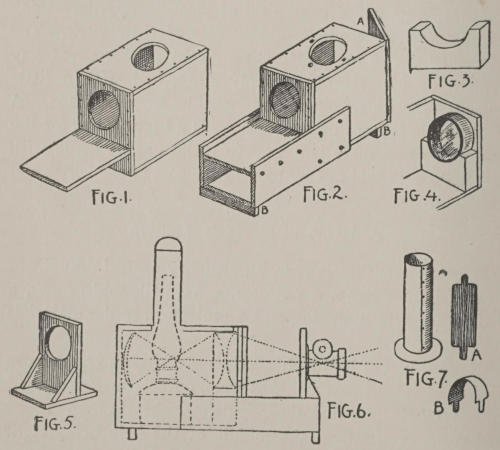
Fig. 1. Fig. 2. Fig. 3. Fig. 4. Fig. 5. Fig. 6. Fig. 7.
From an optician or camera supply house obtain a pair of four-inch condensers mounted in a brass barrel, and a quarter-size projector with a rack and pinion. Mount the condensers in the hole in front of the box, supported by means of a block (Fig. 3), fastened on the inside front of the box (see Fig. 4).
In order to adapt the focus of the lenses according to the distance the lantern is from the screen, a sliding front is necessary (see Fig. 5). Cut a base-block scant seven inches wide and six inches long, fastening to it, three and one-half inches from the front, an upright piece of wood high enough to be even with the top of the lantern-box. When the base is resting on the deck in front of the box two small angle-brackets will steady the upright and make it rigid (see Fig. 5). Cut a hole in this upright board so that the centre of the projector mounted in it lines exactly with the centre of the condensing-lenses. This is an important point; if the lenses are not carefully mounted opposite one another the picture will not be clear. Now fit a piece of wood one-fourth of an inch in front of the main box, fastening it at the top with a strip of tin. There must be a hole three inches square cut in this board, the middle of which must line with the centre of condensing-lens. In the opening between this board and the box slip a thin piece of board for the slides to rest on. Set a double-wick lamp or central-draught burner within the box at the proper height, so that the brightest part of the flame will be in direct line with the centre of the reflector and the condensing-lenses.
The principle of the magic lantern is the reflection of the light through the condensing-lenses, which pick up all the[206] light possible and throw it through the slide, which is located directly in front of it. The light is then taken up by the projector, and the pencils of light are thrown onto the screen, at the same time magnifying the picture. This principle is shown by the dotted lines in Fig. 6, which show also the relative position of the lamp, lenses, and reflector.
To keep in the light that would escape through the top opening in the box, put a piece of common stove-pipe (small) over the lamp-chimney. Cut a cap from a piece of tin (Fig. 7 A), the ears extending down inside the chimney to hold the cap in place, when the cap-piece is bent in a half circle as shown at Fig. 7 B.
To cover the space between the lantern-top and the moving front board a piece of black cloth can be used. Or if you have an old camera-bellows it may be made fast to the back of the projector-lens board and to the front of the slide-board located close to the box. It is not necessary to have an absolutely light-tight bellows; indeed, a very good one can be made from some wire hoops with black cloth sewed to them.
In Fig. 8 the wire hoops are shown, and in Fig. 9 the finished bellows, with the cloth stitched in place, is ready to be attached to the boards with small tacks or staples.
When all the parts are assembled, and the lantern is complete (except the bellows, which has been omitted so that the working parts may be more clearly shown), the lantern will appear as in Fig. 10.
The cost of a good stereopticon will range from twenty-five to seventy-five dollars, and that sum places it beyond[207] reach of the average boy. The following instructions and illustrations will enable any smart boy, who is handy with tools and light materials, to make a high-grade stereopticon with lamp and mechanism that is capable of doing really good work.
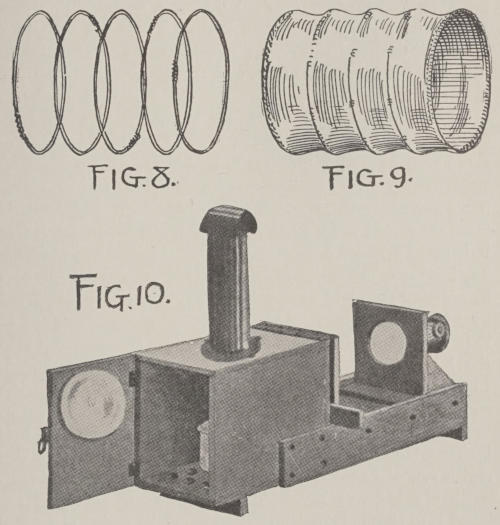
Fig. 8. Fig. 9. Fig. 10.
The materials needed for its construction will be some[208] sheet Russia iron, thin mahogany or cherry boards three-eighths of an inch in thickness and six inches wide, some round-headed brass screws, small hinges, a camera-bellows, and the necessary lenses and lamp. The tools include a light pair of metal shears, a fine-tooth saw and a compass-saw, a small hammer, plane, and screw-driver, and a light cold-chisel.
To begin with, obtain a board twenty inches long, six inches wide, and three-eighths of an inch in thickness to serve as the base-board. Treat this board to several successive thin coats of shellac, and rub down the last coat with fine sand-paper to give it a smooth surface. Cut another piece six inches wide, eight and one-eighth inches long, and in it make a round hole about four and a half inches in diameter, through which the case that contains the condenser-lenses may pass and fit snugly. This board is to be placed nine inches from one end of the base-board, and fastened to it in a standing position with long, slim screws driven into the lower end through the underside of the base-board. Fig. 11 shows the arrangement of these boards, also the runners and sheet-iron hood.
From a sheet of Russia iron cut a piece nine and a half inches wide and twenty-three inches long, and have a tinsmith roll one edge over a piece of wire so as to stiffen it. With a rule and piece of chalk divide and mark off the sheet into three divisions, the end ones measuring eight and a half by nine inches and the middle one six by nine inches.

CONSTRUCTION OF THE STEREOPTICON
Fig. 11. Fig. 12. Fig. 13. Fig. 14 A. Fig. 14 B.
Lay the sheet on a board at the edge of a table so that a chalked line is directly over the sharp edge, and, holding it down firmly with one hand, bend the iron down with the other, forming a right angle. Bend the iron on the remaining line in a similar manner, and the hood is formed.
In the top of this hood, at the middle, mark off an oblong two inches wide and six inches long; then cut out the piece of iron with a cold-chisel and a hammer, laying the sheet-iron on the upturned surface of an old flat-iron. File or emery-paper the edges of the opening to render them smooth, then cut an opening in one side, three and a half inches high by four inches long, for a door.
Through the top hole a lamp-chimney may project that the surplus heat may be carried upward. For the side opening a sheet-iron door should be made and hung in place with small brass hinges, and a brass lever catch to keep it closed.
This catch is a simple little affair, and consists of a thin piece of spring brass, in one end of which a hole has been made, while at the other a little knob handle is riveted. One end is attached to the door, and to the hood beside the door a catch of thin brass is riveted fast, into which the lever catch can drop.
To stiffen the door, the edges should be bound with narrow brass strips, securely fastened with small rivets, or escutcheon pins, that can be adapted as rivets by cutting them to the required length.
Two runners half an inch wide and three-eighths of an inch in thickness are to be screwed fast to the uncovered top of the base-board, four and a half inches apart, as shown in Fig. 11. From sheet-iron cut two strips half an inch in width and ten inches long, and fasten a piece to the top of each runner, using the same screens to hold them in place that secure the runners to the base-board. One-eighth of an[211] inch of each strip will project over the inner edges of the runners, as shown in Fig. 12, and this edge will serve to hold the wooden slide-holder and objective-lens board in the proper position on the base-board.
Make a sheet-iron door six inches wide and seven inches high, with the edges rolled over a wire to stiffen them, and in the bottom of the door, at the centre, cut an opening half an inch wide and two inches high. This will allow the door to be closed over a gas-pipe that may project for a short distance from the rear of the enclosure. Attach this door to the back of the hood with two small hinges riveted at the top, as shown in Fig. 13, and across the under side of the base-board, and two inches from either end, screw battens of wood in which pins have been set. These battens will raise the lantern up from a table or box on which it may rest, and allow a draught to pass up through holes made in the base-board inside the enclosure formed by the iron hood. These draught-holes will be necessary for either oil or gas light, and they can be bored about as shown in Fig. 13.
Two small wooden runners must be fastened to the base inside the enclosure, a distance of four and a half inches apart, and between them a lamp or gas-jet tray will slide.
From the thin mahogany cut three pieces four and a half inches wide and seven inches long. In the middle of these, and four inches from one end, make a centre dot, and with a compass-saw cut a hole in one of them three and a half inches in diameter, and in another cut a hole three and a half inches square.
In the third board make a hole the diameter of the objective lens; then with screws and glue fasten the first[212] two boards together, as shown in Fig. 14 A, so that a space of three-quarters of an inch will remain between them. The height of this opening should be four and a quarter inches, and the holes in the middle of the boards should be centred. These two boards and separation blocks are to be fastened in an upright position to a narrow piece of three-eighth-inch board the same length as the width of the upright boards, as shown in Fig. 14 A; and at the outer edges a saw-cut at the joint will allow this frame to slide back and forth between the runners, so that the iron edge may fit in the saw-cut.
To the inside of the front board two springs should be attached with screws at one end of each; these springs may be shaped from corset steels, and they should be bent in a curved position, as shown at the lower end of the opening in Fig. 14 A. Their use is to hold the slide-carrier back against the rear board and firmly in place. Slide-carriers may be purchased at an optical supply house, and they are made in several shapes; the most convenient ones, however, are the sliding wooden holders that accommodate two slides.
The remaining board is to be mounted on a block and held in place by two angle strips, as shown in Fig. 14 B; and to enable it to slide between the runners it should receive saw-cuts also. Procure a camera-bellows four inches square, or in its absence employ a piece of black silk or gossamer cloth, and attach it to the frames, as shown in Fig. 16, with small curtain tacks and glue. Having mounted these boards on the base-board between the runners, the box is then ready to receive the lenses and lamp.
From a manufacturer of optical goods purchase a pair of four-and-a-half-inch diameter condensing-lenses mounted in a tube, and a quarter-size four-inch back-focus double-objective lens mounted in a tube with rack and pinion adjustment.
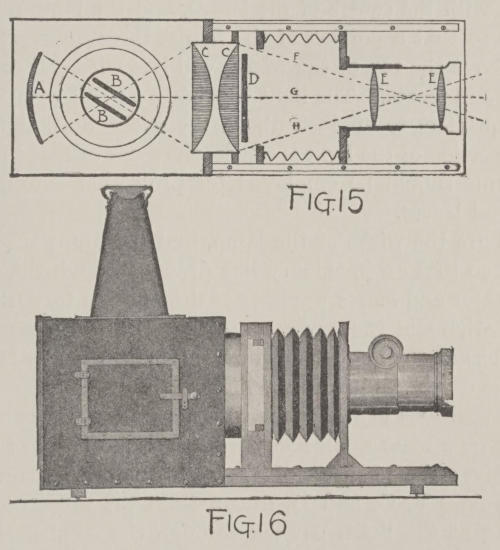
Fig. 15. Fig. 16.
The condenser-lenses should occupy the hole in the front of the box, where the tube can be firmly held in place by the inside edge of the hole. The objective lenses are to be attached to the face of the front board in the position shown in Fig. 16; and by means of the sliding-board and bellows the lenses can be adjusted to meet any short-focus range—that[214] is, a distance of fifteen or twenty feet from the sheet on which the picture is thrown.
For use in small rooms a duplex-burner, or central-draught lamp, can be used, and a plan showing the position of lamp, reflector, and lenses is shown in Fig. 15.
A represents the reflector placed behind a lamp having duplex wicks. The centre of the reflector should be directly in line with the centre of the lenses, and the lamp must be placed so that a portion of the flame, three-quarters of an inch above the top of the wicks, will line with centre of reflector and lenses. The light is brightest in oil-lamps, from three-quarters to an inch above the wicks, and, as only a small portion of the light is of use, the most brilliant part of the flame should be employed for projection through the slide and lenses.
B B are the wicks of the lamp, and the fount should be placed so that an imaginary line drawn through the centre of reflector and lenses would pass through the forward edge of one wick and the rear edge of the other. By arranging the wicks at the angle shown on the plan, the greatest advantage can be had from the light.
The positions of the condensing-lenses are shown at C C, and D represents a slide in position at the front of them. E E gives the position of the objective lenses, and the dotted lines F, G, and H, drawn from the reflector edges crossing at the light, passing through the condensers and slides, and out through the objective lenses, show the manner in which the rays of light are collected and thrown through the transparent picture and lenses, and so on through space, until it rests against the large sheet.
To complete the stereopticon an oval chimney is to be made, and fitted with a flange so that it may be held to the top of the iron hood with four little iron buttons or lap-hooks riveted to the top of the hood. This chimney should be four inches long by two inches wide at the bottom, and one and a half inches square at the top, and eight or ten inches high. At the top arrange a light-cap about as shown in Fig. 16, so that the light from the lamp or gas-jet will not throw rays up against the wall and weaken the picture on the sheet.
Precaution must be taken to stop out all surplus light other than that projected through the lenses, since the useless rays tend to weaken the round disk of light on the screen, and render the picture weak and neutral in tone, instead of sharp and vigorous. The wood-work should be given two or three coats of shellac, and the iron parts should be blackened.
Dissolving views cannot be shown in a single lantern, but if two lanterns are fitted with the same kind of lenses, and placed side by side, so that the disks on the sheet are uniform in diameter, it will then be possible to obtain some very beautiful dissolving effects.
Many amateurs have an idea that it requires a great deal of skill to make lantern slides, but any one who can produce a good negative can soon learn how to make a good lantern slide. The simplest way is by contact-printing.
Select a negative free from spots, scratches, or pinholes.[216] It must have fine detail in the shadows, and no harsh contrasts of light and shade. The regulation size of a lantern slide is 3¼ × 4 inches, so choose a negative which will still make a good picture if all but the portion included in these dimensions is blocked out. Cover the part of the negative which is to be blocked out with black needle-paper, or paint it with non-actinic paint, applying it to the glass side of the negative. The negative is placed in a printing-frame, and then by means of a red light the slide-plate is placed over the part to be printed from, the film side towards the negative.
If one has a lantern, the light of which is suitable for printing slides, cover the negative, open the door of the lantern, and then, holding the printing-frame about fifteen inches from the light, expose from five to twenty seconds, according to the density of the plate. A plate that prints quickly will need but five or eight seconds, but a denser plate will require a much longer exposure, often as long as thirty seconds. Cover the plate as soon as it is printed, close the lantern, remove the slide from the frame, and place it face up in the developing-tray. Turn the developer over it quickly, taking care that the whole surface of the plate is covered immediately. Any developer that makes good negatives will make good lantern slides. A weak developer is to be preferred to one which brings out the image quickly. Develop till the detail is well out; wash and fix same as a negative.
As every imperfection in a plate is magnified many times when thrown upon the screen, great care must be taken in the developing, fixing, washing, and drying. When the[217] slides are washed, take a piece of clean surgeon’s cotton and wipe the film very gently, then place to dry where no dust will settle on the surface.
If there are any spots on the plate after washing and before drying, they may be removed with ferricyanide of potassium in solution. Tie a small piece of surgeon’s cotton to the end of a glass rod, dip it into the solution, and touch the spot very lightly. Rinse the plate at once, and if the spot has not entirely disappeared repeat the operation. The ferricyanide works very quickly, and must be rinsed off as soon as applied.
If your negatives are larger than 3½ × 3½, and it is desired to get the entire picture on the slide, then the reduction process will have to be resorted to. For this work you can use your camera if it has a long bellows, and the work should be done in a room where a window is towards the north.
Obtain a piece of board five feet long and ten or twelve inches wide, and at one end of it erect the negative-board, as shown at Fig. 17. The negative-board or holder should be twelve or fifteen inches square, with an 8 × 10 rabbeted hole at the middle of it, and supported with two brackets, as shown at Fig. 17 B. Kits can be made or purchased to fit in the opening reducing to 6½ × 8½, 5 × 8, 5 × 7, 4¼ × 6½, 4 × 5, and 3¼ × 4¼. With this range of sizes any negative from 3¼ × 4¼ to 8 × 10 can be held in the board. Now arrange two strips of wood at each edge of the long base-board,[218] so that the camera can slide forward and backward on a platform built to support it, as shown at Fig. 17 D.
The camera should be made fast to this moving platform with wood cleats and screws, and it should be mounted high enough so that the centre of the lens will be exactly on a line with the centre of the opening in the upright board, as shown by the dotted line in Fig. 17. At the upper corners of the plate-board arrange slim, steel-wire nails with the heads cut off, and bore holes near the ends of sticks three-quarters of an inch square so that they will fit down over the nails, as shown at Fig. 17 E. The other ends of the sticks should rest on the top of the camera. Over these sticks a dark cloth should be thrown when making photographs of negatives, to keep out light and prevent the high light from the window affecting the action of the lens.
To make a reduction of a large negative, fill the plate-holders with 3¼ × 4 lantern-slide plates, having obtained kits to fit your holders; then clamp a negative upside down on the board, as shown at A. Mark the lantern-slide size with a lead-pencil on the ground glass of your camera, taking care to centre it; then move your camera forward or backward and operate the bellows until the correct size has been obtained. Focus as sharp as you can; then stop down your lens with the smallest diaphragm. Experience will dictate the proper length of time for exposures. No definite rule can be laid down, for the varying conditions of light, rapidity of plate, and state of the weather—all will have to be taken into consideration.
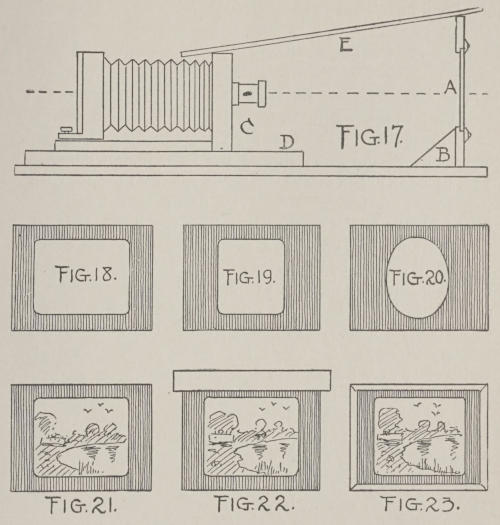
Fig. 17. Fig. 18. Fig. 19. Fig. 20. Fig. 21. Fig. 22. Fig. 23.
Lantern slides made by reduction are always sharper and better than contact slides, and whenever possible they should be made after this fashion, even from films which may be held flat between two plates of clear glass. A piece of white tissue-paper should be pinned against the window towards which the camera points, so that a blank white[220] light will be beyond the negative, thereby avoiding the possibility of picking up any false lights or shadows.
Lantern slides should always be masked, so that the actual sight-opening through which the lantern-light is projected will be two and three-quarters inches wide and two and a half inches high. A mask form can be purchased or made from sheet-brass. The opening and the other dimensions should be of the same size as the lantern-slide plate, or 3¼ × 4 inches. The masks should be cut from black needle-paper with a rotary cutter, having first prepared a number of the blanks of the proper size; then the openings can be cut as shown in Fig. 18. A smaller mask for the central part of slides can be made two inches wide and two and a half inches high, as shown in Fig. 19, and for portraits an oval mask is the best (see Fig. 20). Covering-glasses or crystals are necessary in making slides. Old lantern slides can be cleaned and used for this purpose, or some very thin, white glass may be cut into 3¼ × 4-inch plates.
To mount slides lay a mask against the film-side of the plate, or positive, and over this place a clean, clear covering-glass, as shown at Fig. 21. With binding-tape (which comes in white and black) first bind one edge, as shown at Fig. 22, arranging the paper tape so that an equal margin will be visible on both sides. Bind the opposite edge, and then cut away the projecting ends of the binding. Proceed to close the short ends in a similar manner, and as a result you will have a finished slide, as shown in Fig. 23. Some slide-makers begin at one corner and run a strip of binding all around the edge without cutting it. This is a little difficult to do at first, but if you have a clamp that has a compression-screw[221] and will turn on its axle, it simplifies matters greatly. Some amateurs prefer black binding-tape, others white. The white tape with black masks makes a neat-looking slide, and if the margin is wide enough the title of the picture may be written on it.
Every boy, at one time or another, gets an attack of printers’ fever, and then he will not be satisfied until he makes or purchases a printing-press. There are, of course, many different kinds of printing-presses. One of the simplest forms is shown in the drawing of the flat-bed press (Fig. 1), which is very easy to make and to manipulate. A flat board one and one-half inches thick, twelve inches wide, and eighteen inches long will form a substantial bed on which to fasten the frame and pressure-plate. The frame is made of hard-wood strips seven-eighths of an inch wide and three-fourths of an inch high. These are glued and screwed fast to the bare board, forming an enclosure five and one-half by six and one-half inches, and large enough to accommodate a chase four by five inches. A chase is always measured from the inside. From one-half to five-eighths of an inch all around should be allowed for the thickness of the metal of which the chase is made.
The pressure-plate is cut from wood one and one-fourth inches thick, and the same size as the outside measure of the frame attached to the bed-board. A stout lever fourteen inches long is screwed and glued fast to the top of this[223] board, which is then attached to the rear strip of the frame by means of three stout iron hinges, so that when closed down the pressure-plate will fit closely to the top of the frame.
The type as it is set up in the chase will stand face up in the frame, and the card to be printed is caught with gauge-pins to the inside of the pressure-plate, as shown in the drawing. The type, having been inked with the roller, gives the impression to the card when the pressure-plate is brought down and held against the type by means of the lever.
The gauge-pins that hold the card in place are made of metal or of ordinary pins. Several forms of pins are shown at Fig. 2. A is made from an ordinary pin, while B and C are other forms cut from thin sheet-brass and then bent into shape with small pliers.
Fig. 3 shows a chase five by seven inches, of cast-iron, which can be purchased at a printers’ stock house for a nominal price. When the types are set up they are blocked into position in the chase, and two wedges, made with bevelled edges to bear against each other, are tapped with a light hammer on the thick ends, so as to wedge the type in place. These are called quoins (Fig. 4).
Fig. 5 shows a small proof-roller made of glue and molasses. It may be purchased at a printers’ shop for a few cents.
A piece of glass or marble will answer very well for an ink-plate or slab, and after using them both the slab and roller should be thoroughly cleaned with benzine. The cleaning must be done directly after printing, else the ink dries on the roller and thus spoils it.
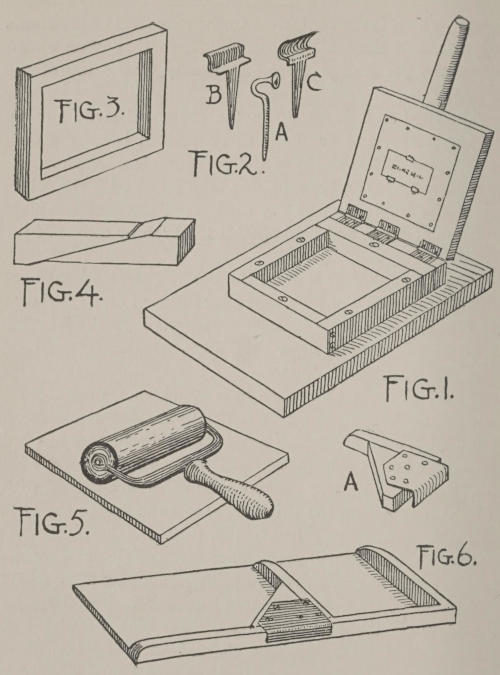
A SIMPLE HAND-PRESS AND ACCESSORIES
Fig. 1. Fig. 2. Fig. 3. Fig. 4. Fig. 5. Fig. 6.
A composing-stick (Fig. 6) may be made from thin wood three inches wide and nine inches long, with a sliding jaw (as shown at A) made of thin wood and caught to the edge with a metal strip loose enough to permit the jaw to be easily moved back and forth.
The types, being first set up in the composing-stick, are then transferred to the chase, and clamped in with blocks of wood and quoins.
The upright press (Fig. 7) is on the same principle as the flat-bed, but the chase is held in a vertical position, and the back against which it rests is braced to the base-board. This press can be made a little larger than the flat-bed, and will accommodate a chase measuring five by seven inches. At the rear of the sides of the base-board angular cuts must be made with a saw, and corresponding cuts should be made near the top of the upright board which supports the chase. With a sharp chisel cut the wood away between these cuts (Fig. 7). Cut the brace-pins also at each end (Fig. 8 A). A lap-joint is the result, and when fastened with glue and screws a firm anchorage and support is obtained for the upright board.
The pressure-plate is of wood one and one-fourth inches thick, and attached to the strip at the bottom of the upright or chase-board by means of stout iron hinges. Care must be taken when placing these hinges to arrange them so accurately that not a fraction of an inch difference is perceptible at either side or at the top or bottom. Otherwise,[226] uneven pressure will give unsatisfactory results. A lever is made and attached to the pressure-plate as described for the flat-bed press, and a block may be fastened to the base-board for the lever to rest on, as shown in the drawing.
A perfect wooden lever-press is shown in the large illustration (Fig. 9), which is drawn so clearly that only the measurements will be required to understand its construction.
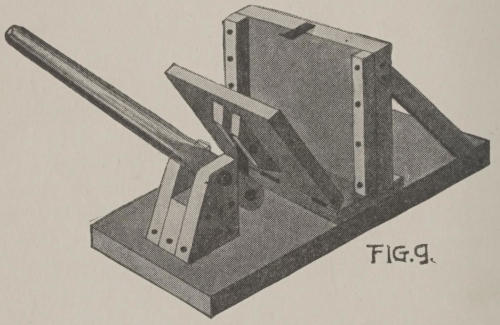
Fig. 9.
The base-board of this press is twenty inches long, ten inches wide, and one and one-fourth inches thick. The upright board against which the chase rests is ten inches wide, eight inches high, and one and one-fourth inches thick. The pressure-plate is the same width and thickness, but is seven inches high, and bevelled at the bottom, as[227] shown in the side elevation (Fig. 12). The upright board is placed six inches from one end of the base-board, and is fastened in place with screws that are driven up from the underside of the base-board, with side-braces let in to the edges of the boards, as shown in Fig. 8.
The pressure-plate is hinged at the bottom to a piece of wood, which acts as a platform for the lower edge of the chase to rest on. It is seven-eighths of an inch thick and two and one-half inches wide. Strips are glued and screwed at either edge of the upright board to hold the sides of the chase, and at the top the chase is held with a brass spring-clip that can be made and screwed to the wood. Four inches from the pressure-plate base three blocks are arranged to support the lever, which is connected to the back of the pressure-plate with a tongue of iron one-fourth of an inch thick, three inches long, and one inch wide (Fig. 10). Quarter-inch holes are bored at each end just two inches apart from centre to centre. Two blocks of wood are screwed to the back of the pressure-plate one fourth of an inch apart, and a quarter-inch hole made in each, to receive a bolt, which also passes through one hole in the iron tongue.
The wooden lever is fourteen inches long, one and one-half inches square at one end, and at the other it is rounded, so as to make it easier on the hands. The square end is rounded off and cut in with a saw, as shown in Fig. 11, and one inch in from the end a quarter-inch hole is made.
The blocks that hold the lever are set one and one-half inches apart, and a bolt passes through the upper end of them and through the lever near the end of the iron tongue. The hole in the lever through which the bolt passes is two[228] inches from the end hole, and when spaced properly the inside of the pressure-plate should be seven-eighths of an inch from the face of the chase-board when the handle and tongue are in a straight line, as shown in the side elevation of the press (Fig. 12).
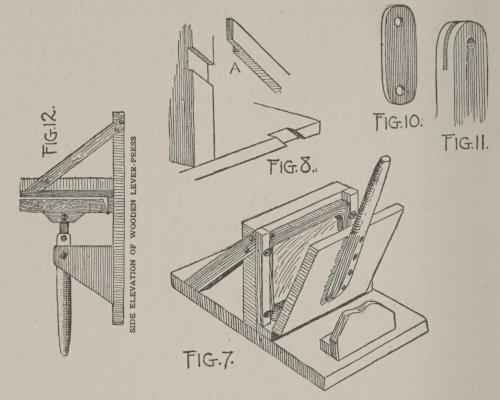
Fig. 7. Fig. 8. Fig. 10. Fig. 11.
Fig. 12. SIDE ELEVATION OF WOODEN LEVER-PRESS
Metal type, electrotypes, engravings, and printers’ plates are always made seven-eighths of an inch high. When making a press always bear this in mind, and if necessary the pressure-plate can always be built up with hard paper to meet the face of the type if sufficient pressure is not had at first.
Type, spaces, quads, rule, blocks, ink, and a small roller can be purchased from any printer if there is not a printers’ stock house in the town where you live. If the printer is accommodating, he will answer all your questions about your printing-press, and help you with any details about which you are uncertain.
Stamping, or the process of imprinting without the aid of a hand or power-press, is as old as the hills. Away back in the early ages the art of stamping was carried on by means of wooden or stone blocks, on the face of which characters, letters, and various other signs were engraved. Patterns or figures in colors were imprinted on fabrics, parchment, and leathers; and in some of the walls of the ruined houses in Pompeii and Herculaneum there are found well-preserved examples of the stamper’s art, where figures of a running pattern are repeated at regular intervals. Both oil and water-color pigments may be used for stamping; but if the imprint is to be made on paper or leather, then printers’ ink, diluted with a small portion of benzine, should be used.
Every boy may have an imprint of his initials cut on wood, and use it in stamping his papers, school-books, and other property. In the Far East every prominent merchant has his private signet, and always, when signing his name to documents, he certifies it with his stamp, which is placed beside or across the name, as shown in Fig. 13.
In China and Japan these stamps are called “chops,” and are used with a red, brown, or blue ink-paste, which dries hard and indelible on paper, leather, or soft wood.
The author’s imprint so interested a wealthy Japanese merchant a few years ago, that when he returned to Yokohama he had a handsome ivory, bone, and silver “chop” cut by a good maker in that city, and sent it over the sea as a souvenir of his visit to this country. Fig. 14 gives the imprint, and Fig. 15 is a drawing showing the shape of the “chop.” The body part is of ivory and the inlay of silver, while the cap, which fits over the engraved die, is of black bone.
Any boy can make a signet of boxwood or maple for stamping paper and wood. For use on leather he can cut his dies in soft copper, which, when heated, will burn the imprint in the leather.
In Fig. 16 four ideas for imprints are shown. In B and C the initials are combined, while A and D are arrangements of scrolls and lines which will be understood as belonging to a certain person, just as trade-marks are the known marks of certain manufacturers.
In order to cut a wood-stamp, it will be necessary to have some fine carving-chisels, a vise, and sand-paper. Maple, boxwood, or other close-grained wood can be used, and it is best to cut the die on the end rather than on the side of the wood. Cut your block the size required; then draw the reverse of the design, as shown at Fig. 15. Cut this as deep as you need it, so that ink or marking-paste will not clog the low parts; then, when the face is properly finished, the die will stamp an impression as shown at Fig. 14. For large dies it will be necessary to use the wood on the side, as otherwise the blocks would be heavy and hard to handle. Souvenir books or engrossed memorials may be embellished[231] with corner ornaments, as well as with capital letters and borders in red, blue, or gold. Any boy who is interested in this branch of craftsmanship can get ideas and designs from gift books, calendars, show-cards, circulars, and the host of illuminated and embellished printed matter that is in circulation. When making these selections, however, avoid the commonplace printing-house patterns, and favor those to be found in the best magazines, art books, and hand-books of ornament such as are shown in Fig. 17, the[232] several parts of which are a miscellaneous lot of ornaments and letters that can be easily copied by the young die-cutter.
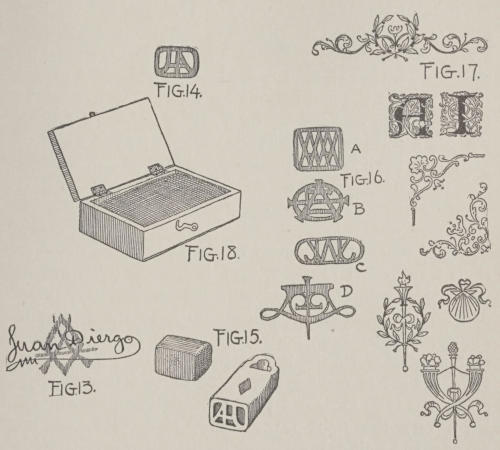
Fig. 13. Fig. 14. Fig. 15. Fig. 16. Fig. 17. Fig. 18.
Diluted printers’ ink is excellent for stamping, and when used it should be spread on a cloth stretched over several thicknesses of flannel and cotton cloth and made in the form of a pad, as shown at Fig. 18. This is a block of wood over which the thicknesses of fabric are laid, the top layer being drawn over the edge and tacked underneath. This block is then placed in a flat box of wood with a hinged cover, so that the pad may be kept enclosed when not in use, and so prevent the ink from drying out. After using the pad a cloth wet with benzine should be laid over the pad; then the lid should be closed and hooked down.
In embossing the ornament is raised in low relief, and so lends a rich effect to paper, card, leather, or other ductile material. Embossing is generally done under heavy pressure, and with moisture or heat to facilitate the work. Papers, thin leathers, and some fabrics can be treated in this manner by the boy craftsman after he has mastered the art of making dies. The mode of making bas-reliefs was fully explained in Chapter XI, and for embossing a very low relief is necessary, since otherwise the paper would split or break away on the raised parts. After a well-modelled ornament is obtained, it will be necessary to make a hard casting from it in plaster, and then a casting from this, so that for the work you will have a sharp,[233] clear bas-relief and an intaglio—one the expressed design and the other impressed. Make these of hard plaster, and give their surfaces a coat or two of shellac.
To press a piece of paper or leather, dampen it on both sides with a sponge or wet cloth, and heat the dies in an oven. Place the paper over the bas-relief, cover with the intaglio, and apply pressure. Or place some weight on top of the dies and leave them there for half an hour. On removing the paper you will find a perfect bas-relief which, when thoroughly dry, will hold its shape. Book, card, and mounted leather-work is treated in a hot press, but only for a second or two—just enough to drive the dies together, heat the material, and cause it to hold its shape.
All healthy-minded boys are interested in physical development; it is the instinct which leads them to climb high trees and scale precipitous cliffs, generally at the expense of some anxiety to the minds of their parents and guardians. But these amusements are more in the nature of “stunts,” pure and simple; the logical and rational field of athletic culture is the gymnasium. In the large cities, and at schools and colleges and Y.M.C.A. societies, there are opportunities in abundance for gymnastic exercises. The purpose of this chapter is to show the boy who has to stay at home, or who lives in a small country village, what can be done in the way of rigging up a barn floor or a spare room like the one shown in Fig. 1. He can also make most of the apparatus; for, with a few exceptions, all the principal pieces are simple in construction and not beyond the ability of the average boy.
For indoor exercise the outfit must necessarily consist of those pieces of the gymnasium equipment that can be used when in a standing or sitting attitude, for the confined space of the average room will not admit of running, jumping, or leaping with the pole or from a spring-board. In preparing a[238] list of the pieces of equipment suitable for a boy’s “gym,” some of the familiar ones have been omitted, as they are either beyond the ability of the average boy to make or they are too cumbersome for the home. The apparatus that is described and illustrated is simple and practicable and can be made at a much lower cost than the prices charged at the shops.
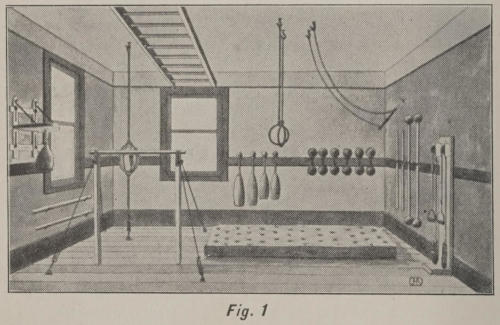
Fig. 1.
Wooden dumb-bells weighing a pound each may be purchased for about fifty cents a pair, but the boy who is interested in making his entire equipment can use croquet-balls with broom-handles, or one-inch curtain-pole sticks, for handles (Fig. 2).
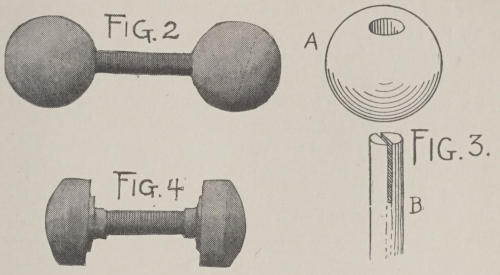
Fig. 2. Fig. 3. Fig. 4.
To make these dumb-bells, obtain some old croquet-balls and clamp them, one by one, in the vise of a carpenter’s bench. Then, with a one-inch bit, bore a hole through each ball, as shown in Fig. 3. Cut a broom-handle or a one-inch curtain-pole in lengths twelve or thirteen inches long, and in the end of each make a saw-cut, as shown in Fig. 3 B. Smear the end of the stick with glue and drive it through the hole in the ball, keying it firmly in place by driving a wedge into the end of the stick, just as hammer-heads are fastened to prevent their coming off. Repeat for the second ball. Some glue should be placed in the saw-cut, so as to hold the wedge when it is driven home. To make the handle easier to grip, it should be bound with linen or cotton fish-line; then the balls may be painted or varnished, and the line given a coat of black varnish, which will set the cord binding and harden it. Several sets of these balls may be made for the “gym” and hung upon the wooden rail that extends around the room.
In the absence of iron bells, a heavy pair of dumb-bells may be made of gas-pipe handles and flanges with screw-holes fastened into wood blocks four inches in diameter (Fig. 4). The gas-pipes, an inch in diameter, may be had at a plumber’s shop or gas-fitters’, and they should be five inches long, threaded at both ends, and screwed into flanges which have been fitted with threads to receive them. These flanges are bored with holes, so that ordinary screws may be passed through them and into the wooden ends. The gas-pipe should be bound with line and painted or varnished, or the entire bell may be painted black to simulate iron.
A good pair of Indian clubs, weighing from two to three pounds each, would cost at the shops about one dollar a pair; but the boy who can handle tools may cut out a very serviceable pair of clubs from wood four inches square or round, with the club, or butt, ends fifteen inches high.
Two pieces of spruce, chestnut, or apple wood are to be cut, as shown in Fig. 5. The upper end should be tapered so that it is one and a half inches in diameter, and leaving the base about two and a half inches in diameter.
The tapering is done by holding the wood in a vise and gradually shaving away the wood with a sharp-bladed draw-knife or spokeshave, turning the wood frequently so as to cut the butt evenly and as true as possible. With a brace-and-bit a one-inch hole is bored in the top of each club three inches deep, and into it a broomstick-handle is driven and held in place with glue and a few steel-wire nails. Wooden[241] balls are bored and glued to the top of the handles, and given an additional purchase with small nails. The handles may be bound with fine line and the exposed wood-work painted any desirable color.
Half a dozen sets of these clubs will add materially to the equipment of the household “gym”; and it would be advisable to make them in several sizes—say from one to three pounds each.
These wands, three to five feet long, may be cut from any hard-wood, or the same lengths of a one-inch curtain-pole will answer quite as well. Plain square sticks may be planed octagonal in shape, or rounded, as a matter of choice (Fig. 6 A).
The ball-bar (Fig. 6 B) may be made as described for the dumb-bells, by boring croquet-balls and attaching them to the ends of a bar with wedges.
In many schools calisthenic exercises with wands, dumb-bells, and ball-bars are regularly taught; and the boy who has provided his own gymnasium with the simple apparatus required will find pleasure in rehearsing the school instructions at his home.
Exercising and swinging rings are usually from six to ten inches in diameter, outside measure, and they may be purchased at the shops for one or two dollars a pair, according to the size and finish.
A blacksmith will make you a pair of rings, eight inches[242] in diameter, out of five-eighth-inch round iron, for about fifty cents; and with a fine file and emery cloth they may be smoothed down so that they will not chafe the hands. Some rings are nickel-plated, but they are used only by professionals in their exhibition work.

Fig. 5.
Fig. 6. WAND A BALL-BAR B
Fig. 7. Fig. 8. Fig. 9.
The rings should give a good grip, and there is nothing better for this than to bind them with tire-tape, or sew leather around them, making the seam at the outside, as shown in Fig. 7. The sewing should be done with doubled and waxed linen thread; if this should prove too difficult, a shoe or harness maker will help you out for a small sum.
In Fig. 8 a triangle is shown having the lower side bound with tape or leather. This triangle is six inches across the bottom, eight inches high, and is made from half-inch round iron. As the lower side is a straight bar, it is somewhat easier to grip than the segment of a circle.
The rings, or triangles, should be suspended by means of ropes, at the lower ends of which straps are provided so that they will hold rings, rods, or trapeze bars. A harness-maker will make these straps for fifteen or twenty cents each, of substantially heavy leather. They should be provided with a stout buckle and a loop under which to slip the strap end, as shown in Fig. 9. The rope ends, through which the straps are caught, may be spliced or formed into a loop-end and bound tightly with twine to make a strong union, as also shown in Fig. 9.
For the house gymnasium a trapeze bar should measure four feet long and one and three-quarter inches in diameter; it should be cut with a path at each end, as shown in Fig. 10, so that the strap may be wrapped around it and drawn tight. The bar should be made of seasoned hickory. The wood may be bought from a wheelwright or wagon-maker, and then dressed down with a plane and spokeshave. The arrangement for the suspension is shown in Fig. 10 B.
The adjustable flying trapeze, as shown in Fig. 11, is made from trunk-straps, provided with two extra loops, and a four-foot bar cut from two-inch hickory and shaped[244] with a spokeshave. At the ends, paths are cut to receive the straps, and, if possible, have the bar turned in a lathe to insure a more accurate job. Small rings at the upper ends of the ropes or straps, and hooks driven securely into the ceiling-beams, will afford the needed suspension.

Fig. 10. Fig. 11. Fig. 12.
The regulation parallel bars are usually supported on iron pipe-standards bolted to a heavy base, and steel heads are provided to grip the bars. But this fitting is beyond the ability of a boy to construct without the aid of a plumber, and the wooden frame base and bars shown in Fig. 12 will answer quite as well.
The bars are of hickory, five and a half feet long and two inches in diameter. The uprights that support them are of oak, ash, or other hard-wood, two and a half inches[245] square and forty-two inches long. The lower ends of the uprights are set into bases of heavy hard-wood two inches thick, ten inches wide, and three and a half feet long. Square holes are cut in the middle of these bases, two feet apart, so that eight inches of wood will extend beyond the holes at each end, and so provide a surface on which to screw the bracket-ends that act as braces to the uprights. The holes should be cut with a brace-and-bit all the way through the bases, and then trimmed with a mortise-chisel and mallet, taking care to make them very accurate, and so prevent any play to the uprights when once set up.
The stepping-plank is also of hard-wood, twelve inches wide, one and a half inches in thickness, and long enough to span the cross-planks. The distance between uprights should be about four feet. The stepping-plank should have a two-inch block under the middle to prevent it from springing; it is to be attached securely to the cross-plates with large, flat screws driven into holes that have first been bored out with a bit. Hollows are cut out in the top of each upright with a compass-saw, and the sides slightly tapered to the edges of the U cuts, so as not to interfere with the hands when using the bars. Fasten the bars to the uprights with two slim screws at each side, driven through the uprights and into the under sides of the bars. Do not put a screw or nail down through the bars and into the top of the uprights, for this will weaken the bars, and if the weight is suddenly transferred to the extreme ends they might snap off.
At a hardware store purchase four iron brackets with eight-inch tops and ten or twelve inch sides. Invert them[246] and screw the tops to the base-boards and the sides to the outer edges of the uprights, to insure added rigidity.
A coat or two of paint will improve the appearance of the uprights and base; but do not coat the bars with anything. They should be polished with an oiled rag until smooth enough for use.
The complete apparatus is shown in Fig. 13. The hickory bar, one and three-quarter inches in diameter and four feet long, is supported on hard-wood uprights two inches thick, three inches wide, and as high as the bar is desired—say from five to six feet, according to the stature of the boys who are to use it. At the lower end the uprights are held in position by two half-inch iron pins driven into the bottom. These fit into holes made in the floor in a corresponding position, as shown at A in Fig. 14. The upper ends of the uprights are cut with a compass-saw to receive the bar, and the edges are tapered to meet the edges of the U cut, as shown at B in Fig. 14. When the bar is in place it is held with straps made of one-eighth by one inch iron. They should be provided with screw-holes, as shown at C in Fig. 14. The ear-plate attached to each upright under the bar (and to which the stanchion wires are fastened) is made of one-inch tire-iron a quarter of an inch thick; it is bolted to the wood as shown at D in Fig. 14. A blacksmith will make the strap and ear-plates for a small sum; and at a hardware store staple or eye plates may be purchased and screwed to the floor, into which the turn-buckles can be caught.
Four turn-buckles and some stout wire form the stanchions; and the floor-plates should be located so that they not only brace the structure forward and backward, but also from side to side, as may be seen at the right side of Fig. 13. If the plates are five feet apart, they should be eighteen inches out from each upright.
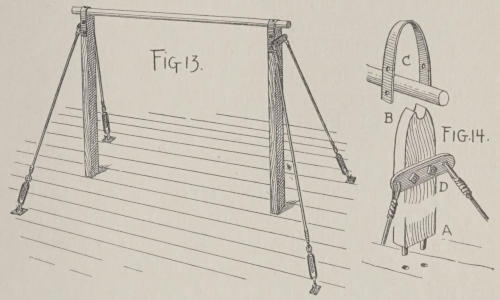
Fig. 13. Fig. 14.
The particular advantage of this bar over a swinging one lies in its absolute rigidity. Also, when not in use, it may be cleared away by loosening the turn-buckles and unhooking them, lifting the pins out of the floor and carrying off the frame bodily.
There are various kinds and shapes of striking-bags to be had at the shops, but a converted Rugby football will answer very well for home use. Remove the bladder and sew two large bone buttons to the leather cover at each[248] end, as shown in Fig. 15. The bladder should then be replaced, inflated, and the cover laced up tightly.
Leather straps, in the ends of which button-holes have been made, are caught over the buttons to form loops to which the ends of the suspension and draw ropes are attached. These straps are reinforced with a patch of leather sewed at the middle, as shown in Fig. 16. The patches will strengthen the straps and prevent them from stretching too much when the ropes are drawn taut.
Between the ball and the floor a spring, or some stout rubber bands, should be placed so as to make the ball rebound quickly when struck.
The portable striking-bag (Fig. 17) is attached to the top of a staff, and is made of leather or canvas and stuffed with paper wads. Or a bladder, inflated the same as a football, may be used. The bag or cover for a bladder should be made of strips of leather or canvas sewed together. The inflated bag is then covered by a stout leather cap. Straps of canvas or leather are sewed to this cap and brought down below the bag, where they are attached to the staff with a thong or cord, as shown in Fig. 17.
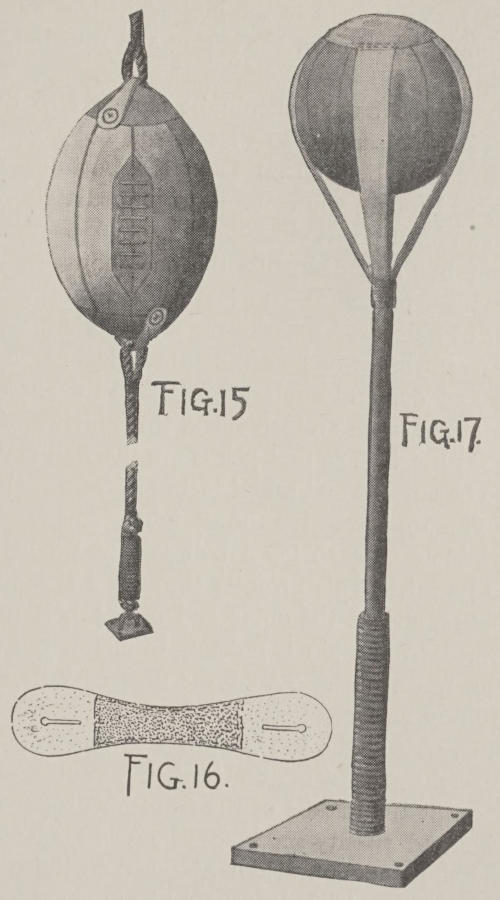
STRIKING-BAGS
Fig. 15. Fig. 16. Fig. 17.
The regulation portable bags are mounted on an iron base, but in our home-made apparatus a plate of hard-wood will have to answer. From oak, ash, or other hard-wood, two inches thick, cut a base fifteen inches square, and round off the edges on the upper side. Make a hole in each corner through which to pass a screw, and a large hole at the middle to receive a spiral spring. The staff (about the size of a broomstick) is screwed down into the top of the spring for five or six inches, or enough to hold it securely; and at the[250] bottom the spring is held in the block with screws or nails driven through the wires of the spring and into the wooden base.
When using the bag it should be fastened to the floor with two or three screws, so that it will not topple over. As it is struck it bends over from the bottom, and the spring, if stiff enough, will cause it to immediately rebound or come to an erect position.
A striking-bag and disk, like the one shown in Fig. 18, may be made from wood and leather, a few thumb-nuts, and a pair of braces. To make the adjustable disk, obtain two pieces of white-wood or pine three inches wide, two feet long, and one and a quarter inches in thickness. Also two other pieces, each an inch thick, three inches wide, and thirty inches long. The first pieces are the wall-plates, and laps are to be cut one and a half inches in from each end, as shown in Fig. 19, to receive the upright pieces.
In the middle of each lap a bolt two and a half inches long is to be set. This projects through a slot cut in the upright pieces, and at the outer end of the bolt a thumb-nut and washer will make it possible to clamp the uprights fast to the wall-plates, so that the disk may be raised or lowered to any required position.
Two slots, as wide as the thickness of the bolts, are cut in each upright with a bit and compass-saw; and on the uncut space, at the middle of the frame, a disk twenty-one inches wide and twenty-six inches long is made fast with screws and short angle-brackets attached to the under side of the rear corners. This disk should be made of hard-wood one and a half inches in thickness, and it is braced from[251] above with two irons that extend from the top of the disk to the upper ends of the uprights. A blacksmith will make these for a few cents each, and they, as well as the other hardware, should be painted black to give them a good appearance.
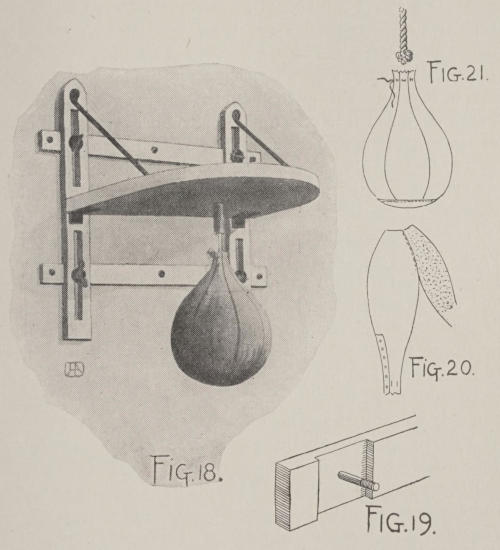
Fig. 18. Fig. 19. Fig. 20. Fig. 21.
The bag is shaped like an inverted balloon, and is made[252] of six pieces of leather, or canvas, five and a half inches wide and fifteen inches long, sewed together at the edges. Each piece should be shaped as in Fig. 17, and when they are sewed together a round cap should be made fast to the large extremity to secure the ends of the side-pieces. A patch is sewed along the edges of two sides to strengthen them and to pass the lacings through, as shown at the lower left-hand side of Fig. 20. This method of construction gives an opening through which to pass a filling of rubber scraps and bits of leather. If a rubber bladder is to be inserted and inflated, this opening will not be required, for the bladder, when collapsed, may be pushed into the opening at the neck.
One inch below the top of the neck some slits are to be made in the leather, through which the throat-laces are interwoven, as shown in Fig. 21. After the knot at the end of the suspension-rope has been inserted in the throat of the bag, the laces are drawn tight and tied. This is the best means of attaching the bag to the rope from which it is suspended; and by means of a hollow stick, which projects down five inches below the under side of the disk, the bag may be centred and held rigidly. As a result it flies up at varying angles from this centre-drop when struck from different sides.
The suspension-stick may be made from a piece of inch-and-a-half curtain-pole, the hole being bored out with a bit. The stick should be inserted through a hole made in the disk eleven inches in from the outer or projecting edge. It should be of such a size that it will be necessary to drive the stick in with a mallet to make it fit snugly. A coat or two of white[253] paint will finish the wood-work nicely, or it may be given a coat of varnish.
A medicine-ball should be ten inches in diameter, and should weigh from three or four to six or eight pounds, according to the size of the boys and girls who use it. The case of a round football may be used, or a leather case may be made of six pieces and two ends, so that it will lace up, as shown in Fig. 22. The case is stuffed with small balls made of pebbles or small stones wrapped in newspaper. The newspaper makes a soft cushion, and does not allow the hard edges of the stones to come in contact with the leather. Larger or smaller stones may be used according to the weight desired, or sand wrapped in paper may be used in place of the stones.
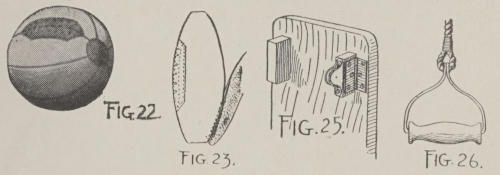
Fig. 22. Fig. 23. Fig. 25. Fig. 26.
If the case is to be made, obtain some russet leather from a shoemaker and cut six pieces, fourteen inches long and six inches wide, as shown in Fig. 23. With doubled linen thread sew the edges together so that the seam is at the inside, as shown at the lower end of Fig. 23. Reinforce two[254] sides of adjoining strips with a patch of leather sewed securely all around the edges and through the middle. Punch holes along the patch half an inch from the edge, through which to lace the draw-strings, as shown at the left-hand side of Fig. 23. At the open ends of the leather case sew on circular patches, four inches in diameter, to securely hold the ends of the six leather sides. The case will then be ready for the filling.
By substituting a bladder for the filling, this medicine-ball may be used as a volley-ball. The volley-ball is played over a net, either in the “gym” or out-of-doors, in a fashion similar to Badminton. It may be played by any number of persons at the same time, the object being to keep the ball in motion over the high net.
No apparatus for home exercise covers the field so generally and thoroughly as the chest-weights, or pulley-weights. No instructions are necessary, for the boy who uses the apparatus can follow his own idea for strokes, and every muscle in the body may be easily and pleasantly exercised, there being sufficient variation in the movements to relieve them of monotony.
An exerciser similar to the one in Fig. 24 may be constructed out of a piece of plank, two pulleys, a pair of sash-weights, and some cotton rope or clothes-line.
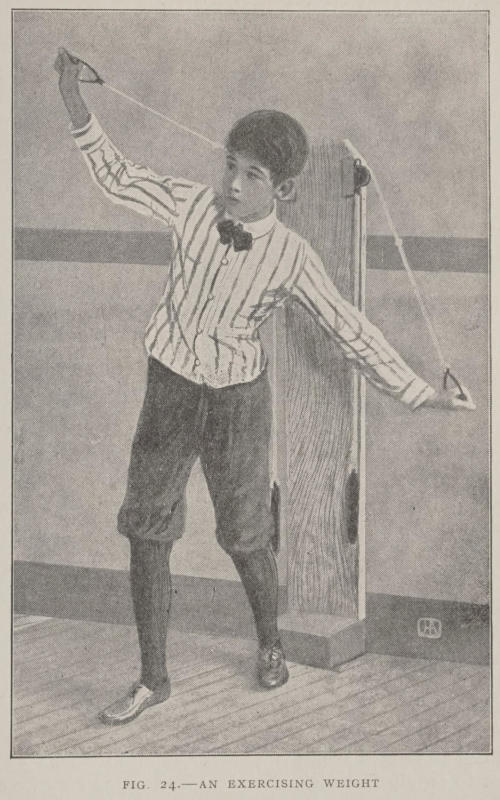
FIG. 24.—AN EXERCISING WEIGHT
Obtain a piece of pine or spruce plank twelve or fourteen inches wide, five feet long, and one and a quarter inches thick; also another piece to form the foot, so that it will project six inches from the base of the plank. Two blocks of wood, four inches long, two inches wide, and an inch thick, will be necessary for the pulleys to swing on. Attach these to the upper end of the plank by means of hinges, as shown in Fig. 25. They should stand out from the board, and in from the edges, the distance of the width of the hinge-leaf, as also shown in Fig. 25. Plate-pulleys are screwed fast to the front edges of these blocks, through which the ropes pass that raise the weights.
The foot-board should be padded with hair or excelsior and covered with leather or burlap, so that the weights may drop on it without making any noise.
From two old tin pails remove the handles and bend the wires around so that a rope may be passed through the eyes at the ends, as shown in Fig. 26. At a hardware store purchase a pair of five-pound sash-weights, and pass the rope ends through the eyes. They should then be spliced or bound with fine line. When the ropes are reeved through the pulleys, a knot should be made in each one, so that it will chock in the top of the pulley and allow the weights to just reach and lightly rest upon the foot-pad. Therefore, when the handles are released the weights will not fall about on the floor as they would otherwise do. The ropes should be about five feet long from the eyes of the weights to the handles. That is quite sufficient to give a good long stroke while bending the body forward or from side to side.
This exerciser may be screwed fast to the rail that should extend all around the “gym,” and also into the floor at the foot to steady it. Lighter or heavier weights may be employed,[257] as the strength of the boy will warrant, but light weights are preferable to heavy ones for continued use.
In Fig. 27 a good idea is given for the arrangement of an attic gymnasium; it shows the locations of the paraphernalia in a room about fourteen by sixteen feet. A smaller room may be arranged in a somewhat similar manner, but each piece of apparatus must be cleared away directly it is out of use.

Fig. 27.
Across the top of the room, from a window-casing to a batten screwed fast to the opposite wall, a ladder may be[258] suspended. Over the window-casing it would be well to attach a batten, so that the ladder will not spring out of place. A rope hanging from one end will make it possible to reach the rings.
A strip or band of wood four or five inches wide should be nailed all around the room four feet above the floor, against which to place parts of the gymnasium equipment, and on which to hang dumb-bells, Indian clubs, wands, and ball-bars, as shown in the illustration.
Under the trapeze or rings it is well to place an old mattress, a useful thing in the event of a fall. If the room is wide enough, double sets of hooks may be driven in the ceiling-beams from which both a flying trapeze and rings may be suspended. When one or the other is in use, the extra apparatus may be drawn up or to one side of the room. A light room is always more cheerful than a dark one, and plenty of ventilation is necessary in the home gymnasium.
A miniature theatre, equipped with curtain, flies, drops, wings, and several good sets of scenery, is an unfailing source of interest and amusement. It has long been popular in Paris even as a professional form of entertainment. Fig. 1 gives the front elevation of a miniature theatre; and Fig. 2, a side view, illustrates the location of the working parts, and the manner of arranging the wings, drops, and flies.

Fig. 1.
This theatre must be made of such a size that when it is placed at one end of a room the audience will have a good view of the fore, middle, and back ground. A good size for the stage is four feet wide and five feet long over all, the front being slightly curved, as shown at B in Fig. 3. The proscenium should be four feet wide, three feet high, and with a sight-opening three feet wide and thirty inches high.
The proscenium is made from three boards seven inches wide and seven-eighths of an inch thick. The upper corners are bevelled and mitred, so that the inner edges will be recessed, as shown in the plan drawing Fig. 3 A A. The top-rails are caught at the front to the top of the proscenium with screws, and are supported at the rear and middle by[260] uprights, the lower ends of which are let into the sides or edge of the stage, and then made fast with glue and screws, as shown at C C C C in Fig. 3. Cross-braces at the back and middle of the top are screwed to the top-rails for strength. Bracket or brace pieces are caught at the rear of the last rail and to the rear of the last uprights midway between[261] stage and top, and are made fast with glue and screws, as shown in Fig. 4. These will hold the framework securely in position.
Gas, electric light, or candles may be used for the footlights. If gas is employed a small pipe should run along under the front of the stage. Over this pipe a tin cornice is arranged with holes made through it every three inches. These holes should be just large enough to admit gas-jets which project through it, as shown in Fig. 5. The supply of gas can be controlled at one side by means of a key, so that the lights may be lowered or turned up full. If candles are used they should be arranged on a board, so that as they burn lower and lower the board can be raised. If electric lights are available, they are the best of all, since the danger of fire is reduced to a minimum. The small sockets, wire, and lamps used for Christmas-trees can be employed, and will give very good results.
After the constructional work of the stage and frame is complete, it will be necessary to make the scenery and equipment. It will be best to have two curtains, the first a fancy one which can be painted on muslin or a window-shade. Window-shades come printed with pictures on them, and these can be strengthened with oil paints diluted or thinned with benzine. A very pretty outer curtain can be made from a printed Japanese silk panel, such as are for sale in the art and dry goods-stores. This can be sewed on a plain piece of goods, and the upper end made fast to a shade-roller, as shown in Fig. 9. The main curtain may be of denim, stout muslin, or any suitable cloth or fabric. It is nailed to a round stick (a curtain-pole is preferable), which is cut at the ends as shown in Fig. 6. The draw-string is wound in this groove, and so the curtain is raised and lowered. The shade-roller curtain is the outer one, and is attached to the frame at the top, and just back of the proscenium, as shown at B in Fig. 2. The main curtain is just inside the outer one, and is made fast to a stick near the outer curtain-roller. When down, the roller rests on the stage just back of the proscenium, as shown at C in Fig. 2. When the curtain is rolled up to the top of the proscenium-opening, a few turns of cord are taken about each end of the roller in the groove. The cords then pass through screw-eyes to the back of the stage-frame, where they can be held on a small cleat. Both cords pass through the same eyes, so that the pair of strings may be operated by one hand. The drop-curtains at the back of the stage are painted on window-shades, the rollers of which are hung on blocks at the under side of the top-rails and close to the rear uprights, as shown at A A A in Fig. 2.
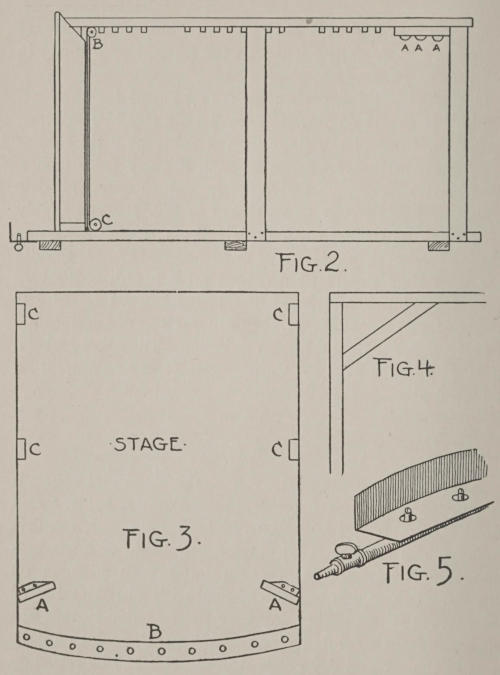
DETAILS OF STAGE
Fig. 2. Fig. 3. Fig. 4. Fig. 5.
The flies are strips of muslin painted to represent sky in out-door scenes and ceilings in interior sets. The flies are tacked on a stick, the ends of which project beyond the body part of the fly so that they may rest on the top-rails of the stage-frame, as shown in Fig. 7. The fly part drops down two or three inches below the upper framework, so as to be visible to the spectators. The wings are of card-board or stiffened muslin tacked on frames, the bottoms of which rest on the stage. The upper part is held between the runners,[264] or cross-rails, fastened to the under side of the top-rails, as shown in Figs. 1 and 2.
The front and back of a wing is shown at Fig. 8. The front, A, is the smooth side on which the tree or other feature can be painted. The back, B, shows how the frame is made to support this piece of scenery. The frame should be constructed of pine sticks three-quarters of an inch wide and half an inch thick. Where they cross each other laps should be cut out of each piece, so that one will lie flat in the lap of the other. The surfaces of all the sticks being on one plane, the frame offers a flat surface for the material to back against.
An independent piece of scenery, such as the house, tree, fence, and bushes shown in Fig. 10, will have to be built upon a frame, and a foot must be provided so that it will stand on the stage independent of any top, bottom, or side braces. The manner of doing this is shown in Fig. 11, the two feet being “loaded” with pieces of lead at the ends of the feet so that the house cannot topple forward. Very pretty scenes can be made from card-board and of stiffened goods, such as crinoline, over which the painting can be done. Books, magazines, and photographs can be drawn on to offer suggestions for scenery and interiors, and the smart boy, who has some idea of perspective, can design and make some most attractive stage-settings for this miniature theatre.
The actors and actresses should be celluloid or papier-maché dolls, their feet being attached to thin strips of wood, which can lie flat on the stage and be operated from the sides. When the stage is on a line with the eyes of the audience, these thin strips will hardly be noticed. Jointed dolls may be used for the actors who have occasion to sit during the performance, but it is difficult to bring about the change of posture without destroying the illusion. Trap doors and other pieces of stage machinery may be added as found necessary, and there is no limit to the ingenuity that may be exercised in equipping our miniature stage.
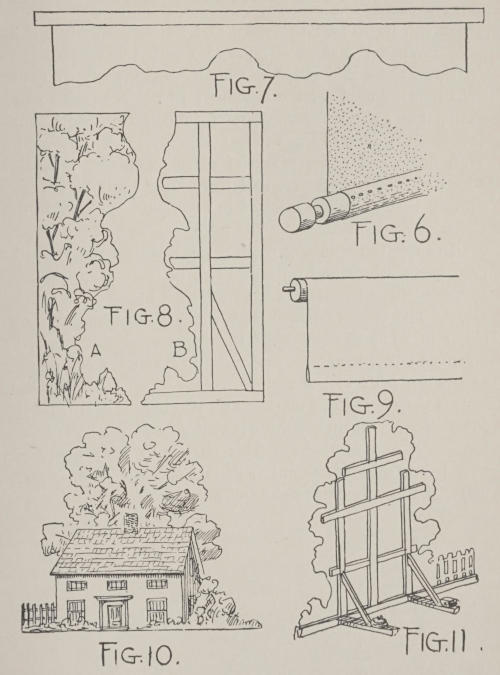
SCENERY SETS
Fig. 7. Fig. 8. Fig. 9. Fig. 10. Fig. 11.
Of course the speaking parts are taken by boy and girl performers, who stand on either side of the stage, and are concealed from the view of the spectators by screens or curtains. The stage-manager and his assistant stand still closer in, so as to manipulate the puppets. A curtain-bell arranged under the stage, and rung by a knocker or electric apparatus, adds to the realism.
This theatre is to be mounted on two horses, and it must so be screened off that nothing is visible but the proscenium, fore-stage, and footlights. This curtaining may be done with heavy muslin, or Canton flannel of dark color, or any material through which light will not show.
When once a boy realizes what may be done in the way of fitting up his den or room, he is sure to take an interest in the subject. A certain amount of manual skill and artistic feeling are, of course, desirable, but these qualities may be cultivated, and to a much greater extent than one would at first be willing to believe.
The color schemes, designs, and general suggestions in artistic handicraft that may be carried out in fitting up a boy’s room are almost without limit; but the following ideas are all practical, and the illustrations and explanations should enable the young craftsman to get satisfactory results at the minimum of labor and expense.
In the selection of woods from which to build furniture, the natural product of the locality in which the boy lives must be taken into consideration. Some States grow pine, white-wood (cottonwood), poplar, or cypress, while in others spruce, hemlock, maple, and fir will be found easier to obtain. In the Far West, gumwood, redwood, cedar, and cypress form the staple supply. The cost of the wood is a matter to be considered, and often the more artistic result may be secured by using an inexpensive wood, since the[268] beautiful grain of the finer varieties can only be brought out by the skilled and experienced workman. Many woods have an open and broad grain that, if carefully filled and varnished over, will give a very pleasing effect. Chestnut, butternut, quartered oak, and ash have this quality, and all of them are adapted to furniture construction and room trimmings. For chairs and other furniture, spruce, apple-wood, and cypress will give good results; and all of them have a pretty grain when stained and varnished. Ash is harder, and makes good, solid furniture. If not found too difficult to work, it will prove a very satisfactory and serviceable wood for chairs, tables, benches, and other pieces of furniture that are subjected to hard usage.
In the construction of the various pieces of furniture illustrated, the simple rules of carpentry are to be followed, and only the lap, mortise-and-tenon, and tongue-and-groove joints are employed. These joints must be well made, however, so that perfect unions will result, for every piece of furniture will rack in time if not properly braced. For this reason only the plain joints are advocated for the young workman; and nothing has been said about the dowel, key, and other joints that are frequently employed by cabinet-makers in the general construction of furniture. These latter require much more care and accurate fitting, and for the open and exposed joint the simple forms are far better.
Of all the pieces of furniture in the house, chairs are the ones most used, and, as they are subjected to hard usage,[269] they should be well constructed and the joints carefully made.
In the plain chair shown in Fig. 1 the front legs are sixteen inches high, the back supports are thirty-four inches high, and all of them are one and three-quarter inches square. All the side-rails and the four that support the seat are two inches wide and three-quarters of an inch in thickness, so that the laps cut in the corner-posts (Fig. 2, A and B) will correspond in width and depth. The cross-cuts are made with a fine saw, and the wood removed with a broad firmer-chisel, taking care, however, not to cut deeper than three-quarters of an inch when removing the wood. Use a mallet to help the chisel, but do not seek to take out too much at one time; better try three or four times, and take a moderate bite each time, than run the risk of having a large chunk come out and bring with it some of the wood that should be left for the rail-end to lap against.
The rail at the front is eight inches above the floor, and those at the sides are four inches. At the back the distance is ten inches from the floor to the under side of the cross-rail. Take care to make the saw-cuts inside the two-inch mark, so that the rails will fit snugly into the corner-posts without any play. There is nothing so annoying in a chair as to have it loose-jointed and rickety.
A wooden seat sixteen inches square, with the rear corners cut out to fit around the back posts, is nailed or screwed fast to the top edges of the upper rails all around; and for the back a twelve-by-sixteen-inch piece is cut and screwed fast in the laps cut at the upper ends of the back posts, as shown in Fig. 2 B.
To make a comfortable back and seat, cover the wood with curled hair from an old mattress, or some cotton and dried moss; then tack unbleached muslin over it to hold it in place. For the final covering use burlap, denim, cretonne, or other stout fabric, that can be had at a dry-goods store for fifteen or twenty-five cents a yard. Draw it down and turn it under all around the edges of the back and seat, fastening with small tacks driven at regular distances apart.
Large, oval-headed upholsterers’ tacks painted black will appear to good advantage if driven about two inches apart along the edge of the goods. If they cannot be had, or are too expensive, a very good substitute may be made from sheet-lead or an old piece of lead pipe split open and beaten out flat.
From the sheet of lead cut disks three-quarters of an inch round with a cold-chisel, on the upturned face of an old flat-iron. With a small hammer beat the edges to resemble a hand-wrought nail-head, similar to those you may have seen in an old hand-bellows in a blacksmith-shop. These are to be painted black, and applied to the wood with slim, steel-wire nails, the heads of which will be invisible if they are driven well into the lead. The heads of the screws that fasten the lap-joints can be hidden with these mock nail-heads, as shown in the drawing.
A good black paint for the metal parts of furniture is made by adding dry lamp-black to some brass lacquer or shellac, so it will have the consistency of cream. It is then applied with a soft-hair brush to the surface of the metal, on which it will dry quickly. It often requires two or three days for oil paint to dry on metals, and it lasts no longer[271] than the lacquer or shellac coating. Several small nails driven around the edge of the mock nail-heads will hold them in place, and to all appearances they will look like the large-headed, wrought bellows-nails.
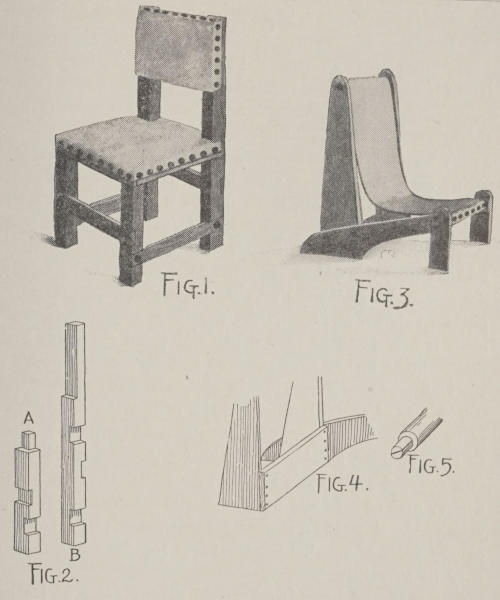
Fig. 1. Fig. 2. Fig. 3. Fig. 4. Fig. 5.
For studying or reading, the chair shown in Fig. 3 will be found a useful piece of furniture.
The wood is three-quarters or seven-eighths of an inch in thickness, planed on both sides, and may be finally stained and varnished or painted. The front posts are fourteen inches high and four inches wide, while the back ones are thirty-four inches high, three inches wide at the top, and eight inches wide at the bottom. The side-rails are twenty-eight inches long, three inches wide at the front, and six inches across the widest place near the rear. The side-rails are fastened outside the rear uprights and inside the front posts, as shown at Fig. 3. At the back, near the foot, the chair is held together with a plate of wood six inches wide and eighteen inches long, screwed fast to the lower edge of the high posts, as shown in Fig. 4.
The top of the rear uprights are bound together with a piece of two-inch curtain-pole, with a saw-cut in the end to the shoulder, as shown in Fig. 5. After it is in place, glue-covered wedges are driven into the saw-cuts to make a key, and so hold the joint securely. Between the front ends of the side-rails a similar piece is placed; or a two-inch square piece of wood, with the front top edge rounded off, may be substituted.
The seat and back is composed of one piece of leather, fabric, or even carpet, caught to the front and top cross-pieces, and adjusted so as to form a comfortable support to the body.
This chair can be made with a shifting back by rounding[273] off the lower ends of the back uprights and attaching them to the side-rails with bolts and washers, one bolt to a side. With two or three corresponding holes in the side-rail and upright, pegs can be fitted into them, or a rod passed through from side to side of the chair, in fashion similar to the well-known Morris chair. The pegs must be stout, or the rod substantially heavy, since the leverage is great and would snap off light pegs or bend a thin rod.
One of the most comfortable pieces of furniture in a boy’s room is a Morris chair, and if properly constructed it should last almost for a lifetime.
Fig. 6 gives a good idea for a solid affair that can be made twenty inches wide and twenty inches deep from outside to outside of corner-posts. The posts are two inches square and twenty-three inches high, and in the front and back ones laps are cut to receive three-inch rails, with the upper edges sixteen inches above the floor. At the lower part of the sides, five inches above the floor, two-inch rails are let into the posts. From these side-rails to the under side of the arms four flat balustrades are mounted and held in position to the lower rails with screws and glue. At the upper end they are mortised into the under side of the arms for half an inch. Two more rails are let into the posts at the inside and on a line with the rails, at front and back, that support the seat and to which the leather is to be attached.
A frame twenty-two inches high is made for the back and covered with leather stretched tight and nailed all around[274] the edges with large, oval-headed upholsterers’ tacks. The back is hinged to the rear rail of the chair, and held in position with a cross-rod, which in turn is supported by wooden pins driven into the end of the arms, as shown in the illustration. The arms are wedge-shaped, five inches broad at the front and two inches at the rear, where the ends are rounded. They are held to the tops of the corner-posts with long, slim screws, the heads of which are covered with the imitation nail-heads described in the making of the plain chair (Fig. 1).
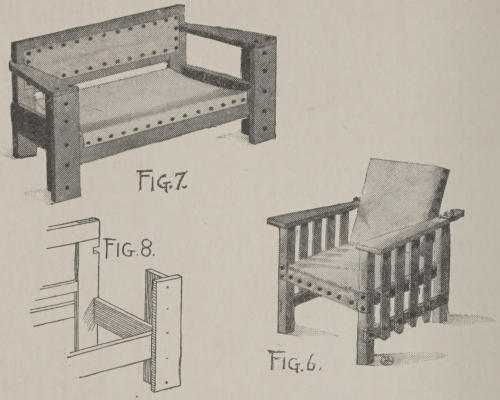
Fig. 6. Fig. 7. Fig. 8.
For the side of a room, where there is space to accommodate it, a settle is a comfortable piece of furniture,[275] and Fig. 7 gives some good lines that can easily be followed.
The back of this settle is forty-two inches long and thirty-two inches high. The seat is sixteen inches above the floor and eighteen inches deep. The front plates are each six inches wide, twenty-five inches high, and seven-eighths of an inch thick. They are attached to the front and side rails of the settle with stout screws and glue, and a line of screws is driven through the front plate and into the edge of the one it laps against, as shown at Fig. 8, which is one end of the settle frame.
The leather forming the seat is drawn over the front and back rails (which are each six inches wide), and is nailed to the wood, as shown in the illustration. The leather is applied to the back in the same manner, and, to hold the edges down, glue may be used.
A chair may be constructed in similar fashion with the same height and depth dimensions, but twenty-four inches wide over all, the side-plates under the arms being four inches wide.
In the illustration of a box-desk (Fig. 9) an idea is shown that the young craftsman can easily work out.
Obtain a box twenty-four inches long, eighteen inches wide, and twelve inches deep. It should be made of planed boards. At the joints drive in a few screws to make them more secure. Cut two pieces of wood thirty-six inches long, four inches wide, and seven-eighths of an inch thick, and attach them to the rear edges of the box when it is stood on[276] end, allowing the lower ends to extend down four inches below the bottom of the box. These will form the back feet. For the front ones, cut two pieces of wood fourteen inches long and six inches wide, rounding off one end, and cutting the bottom out three inches, thus allowing the remaining wood to be three inches wide, as shown at Fig. 10. These are fastened to the lower edges of the box at the sides with screws and glue.
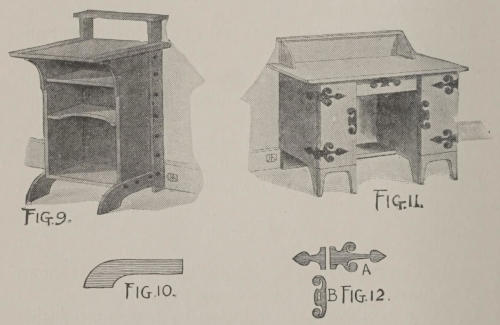
Fig. 9. Fig. 10. Fig. 11. Fig. 12.
Two shelves, ten inches wide, and as long as the inside width of the box, are to be cut and fastened six inches apart, leaving a ten or twelve inch space at the bottom for high books, or a place to put the feet when sitting at the desk. A top twenty-two inches wide and eighteen inches deep is made fast to the top of the box, and if a slant is desired the back of the top board may be propped up for an inch or[277] two with a strip of wood. On the ends of the side-rails that project above the desk-top a ledge six inches wide may be made fast for ink-bottles, pencils, and other accessories. Attached to the upper edges of the box brackets of wood may be arranged to support the projecting edge of the desk-top.
Stain and varnish, or paint, will add the finishing touch to this box-desk.
Two boxes, a drawer, and a broad top can be easily transformed into the writing-table shown in Fig. 11. If well put together and decorated with artistic hinge-straps and escutcheons, the boxes are entirely hidden from sight.
Two boxes, each twenty-two inches long, fifteen inches deep, and ten inches wide (outside measure), are placed on end and made fast under a broad top forty-five inches long and eighteen inches wide. Three inches of the top will project beyond the boxes at the ends and front. This will leave a space nineteen inches wide between the boxes. At the bottom a ledge eight or ten inches wide must be made fast to the bottom of the boxes, on which to rest the feet when writing at the table. This ledge will also serve as a brace, and help to hold together the bottoms of the boxes.
Legs six inches high are cut from wood seven-eighths of an inch thick, and fastened under the four corners at the front of the boxes. At the back, the foot-piece is a board ten inches wide, screwed fast to the lower rear ends of the boxes, so that six inches of it will project down to the floor to correspond with the legs in height. A shallow drawer is[278] made to fit between the boxes, and a slide on runners is attached with screws near the top.
Doors ten inches wide and twenty-two inches high are hinged to the outer sides of the boxes, and from sheet-lead the hinge-plates or straps and the escutcheons are cut with a light cold-chisel and mallet, as shown at Fig. 12, A and B. (For other designs, see Chapter VII., on Decorative Hardware.) The front hinge-plates are eight inches long and four inches wide across the scrolls, and the shorter ends are four inches in length. The flat edges that butt against the hinges must be made to correspond with the hinges in width, but they are no part of the hinges proper, being purely for effect. This hardware is coated with the black metal finish. It is then fixed in place with large-headed nails or with steel-wire nails.
A top board, with half-circular supports, can be made and attached to the rear of the desk-top if thought desirable.
For trinkets, books, and the general assortment of odds and ends that a boy is sure to possess, the whatnot shown in Fig. 13 will be found useful.
It is fifty-four inches high, twenty wide, and twelve inches deep. The cap projects two inches beyond the sides and front. The side-boards are cut up at the bottom, the angle of the coves being ten inches above the floor. Near the top a corresponding effect is obtained by cutting out pieces of wood in the form of shields. The side-ledges are thirty-six inches above the floor, twelve inches long, and seven wide.[279] They are supported by two brackets at each side, five inches wide at the top and six inches deep, cut as shown in the illustration, and made fast with glue and screws.

Fig. 13. Fig. 14. Fig. 15.
The ledge over the drawers is forty inches above the floor, and each drawer is five inches deep. The lower ledge or[280] shelf is twelve inches above the floor, and the front edge is cut in with a compass-saw.
All the wood-work is of stock seven-eighths of an inch thick, and the edges of the shelves are butted against the side-boards, through which screws are passed, the real heads being afterwards covered with the mock nail-heads. The usual stain and varnish will treat the wood nicely and lend a good finish to this useful bit of furniture.
For stamps, coins, minerals, and other valuable possessions, the treasure-chest shown in Fig. 14 is just the thing.
To give the chest an appearance of strength and security, the doors should be made of wood one and a quarter inches thick, while the legs and feet should be of one-and-a-half inch stock. The box is thirty inches long, eighteen inches high, and twelve inches deep (inside measure), and the top projects an inch and a half over the ends and front when the doors are closed. The legs are twenty-eight inches high and twelve inches wide. At the lower ends feet are cut from wood the same thickness as the legs, and made fast to them with screws. A cross-rail six inches wide and cut in at the under edge is mortised and tenoned into the legs twelve inches above the floor; while across the top of the legs a board twelve inches wide is securely fastened, and braced at the back with a four-inch rail, to prevent this base from racking with the weight of the chest.
Shelves and divisions are arranged, according to requirement, within the chest. To close it, two doors are swung[281] on stout hinges, against which lead hasps are mounted to lend an appearance of strength. These are cut from stout sheet-lead, and applied with large-headed upholsterers’ nails painted black. The front hasp-ends should be ten inches long and the return ends five inches in length. Over the key-hole a long hasp may be placed, with a corresponding one on the other door to complete the decorative effect.
For service and comfort when studying or writing, two useful pieces of furniture are shown in Fig. 15.
The top of the table is twenty-four inches wide and forty-two inches long. It can be made from three or four boards of pine or white-wood glued together at the edges and battened at the under side. The front legs should be twenty-seven inches high and two and a half inches square. The rear legs are thirty-nine inches high, and where the table-top joins them laps are cut out on two sides for a depth of one inch, and a corresponding notch is cut from the corner of the ledge so as to fit into the lap. The lower rail at the back is six inches wide, and the lower side-rails are four inches wide. The shelf attached to the top of the rear posts is seven inches wide and forty-two inches long. It need not be more than seven-eighths of an inch in thickness, and the front ends of it may be supported with short bracket sticks which rest on the table-top close to the rear posts.
At both the front and back brace-strips are let into the legs and the edge of the table, as shown in Fig. 15; these pieces are eighteen inches long and bevelled at both ends.
To accurately cut the laps in the legs and table-top, lay a strip across in the proper place, and mark the lines with a pencil; then with a saw cut slowly and accurately on this line to the proper depth. With a chisel cut the wood away and let in the brace-strips, when they can be securely fastened with glue and screws. At both ends shelves may be attached to the posts and the braces, as shown in the illustration. These will make good book-ledges or convenient places for pencil and pen boxes, extra pads, and school trappings. Books may rest on the table under the top shelf. To prevent their falling off at the back, a rail two inches wide is attached to the rear posts and supported at the middle by a short upright block which also acts, as a brace to the middle of the top shelf.
The stool is eighteen inches high, sixteen inches long, and fourteen inches wide. The corner-posts are two inches square, and the rails are two inches wide and three-quarters of an inch thick. At the sides the top-rails support the seat, which is a piece of cowhide attached with nails and glue, over which imitation nail-heads are made fast. The lower rails, at front and back, are three inches above the floor, and the lower side-rails are eight inches above the floor. Stain and thin shellac will finish this wood-work nicely.
There are very few crafts that a boy takes hold of with so much confidence as painting. In the average boy’s mind it merely means getting a pot full of paint, a brush, and daubing it on. This is painting in one sense of the word, but not painting as a real craftsman should do it.
Good painting is a skilled trade, just as are horseshoeing, plumbing, or bricklaying. But this manual is not intended to be an artisan’s guide; all that can be done is to lay down certain principles, and to give the practical hints that may make a boy’s efforts in this line worth while.
It is not necessary that a boy should know how to make paints; that is a branch of manufacture that requires years of experience, improved machinery, and chemical and mineral formulæ. A boy should know, however, what paints are made of, how prepared, and how they are mixed, so that he will be able to work with intelligence and success.
The basis of all good paint suitable for wood-work is lead or zinc. Some painters prefer all lead for outside work, while others take two-thirds of lead and one-third of zinc, and then add the coloring dust or ground colors to get the required shade. Both white-lead and zinc are ground in[284] linseed-oil, and can be purchased in cans, or kegs, ranging in weight from one-pound tins to five-hundred-pound kegs. Zinc is sold in the same kind of packages, and the cost in small quantities is about ten cents a pound. Inside shades of any color are generally made of two-thirds zinc and one-third white-lead; then the dust or ground colors are added to tone down the white to any desired shade. Pure boiled linseed-oil and good turpentine should be used to thin paints. Benzine, naphtha, kerosene, or other oils should never be used in the preparation or thinning of paints unless for special purposes.
To make the best paint for outside use, take two pounds of white-lead and one pound of white-zinc, and mix them thoroughly, adding whatever oil is necessary to render the mixture about the consistency of rich cream. If coloring matter is to be added, it is best to use the ground colors rather than the dry dusts, because the colors ground in oil are much finer, and will mix better with paint than the dusts. Colors ground in oil may be purchased at a paint store for ten or fifteen cents a pound. A portion of the color should be thinned first with turpentine, and then added to the pot of mixed white, stirring the mixture while the coloring is added.
If the paint should not be thin enough to lay on the wood, you may add small portions of turpentine until it is the right consistency. A little experience is the best teacher in this matter, and to make sure, it is well to ask a painter. Painters, and all masters of arts and crafts nowadays, are much more easily approached than they were a few years ago, and a boy who really wants to know, and who goes[285] about it in the right way, can generally get the knowledge or advice he is seeking. When making paint for inside use, take the proportion of two parts of zinc to one part of lead, then mix and thin with oil to the consistency of rich milk or thin cream.
Before new wood-work is painted, all knots or sappy places should be given a coat or two of shellac to “set” the sap. The priming, or first coat, should be composed of equal parts of boiled linseed-oil and white-lead for outside, or zinc with some turpentine for inside work. When this is dry one or two coats are to be laid on, taking care to apply the paint evenly and to work it into all cracks, crevices, and corners. The secret of good work is not in daubing a whole lot of paint on the surface to be covered, but in laying it on evenly and in a thin coating, so that it will neither gum nor run. Two or three thin coats are always better than one thick one, and the extra time spent in putting the thin coats on, and in going over the work several times, will be amply repaid, because the work will last. The thick coat will dry unevenly, and in time will chip, crack, and peel off.
When painting over old wood-work, it is always best to scrape or remove as much of the old paint as possible. Then sand—paper everything smooth, and wash all surfaces of painted wood-work with a sponge and sapolio, or other good scouring soap. If there should be any glossy surfaces to the wood-work it is best to give them a washing with a very strong solution of washing soda. A saturated solution of the soda is best. This is made by adding washing soda to water (about a pound to two quarts), and mixing or stirring[286] it until the water has taken up all the soda it will hold. After the soda-water has been applied to the wood-work, be careful to wash it all off with clear water, changing the bucket of water frequently, so that no traces of soda will be left on the wood-work. Follow these directions explicitly, and do not try your own way nor trust to luck to have the new job look well and last. There is an old saying that “A little putty and paint hide a multitude of sin,” but get rid of as much of the “sin” as you can before the new coat is put on. The soda bath is particularly necessary on old furniture that has been varnished several times. Paint will not hold on varnished surfaces unless the varnish is first cut with soda-water or some of the prepared paint and varnish removers.
It is always best to mix your own paints rather than to purchase “ready-mixed” paints or “prepared paints” at a store. There are, of course, a great many reputable makers of mixed paints, and you may use their preparations if you so desire. But my advice to the young craftsman is to purchase the raw materials of a good dealer and learn how to mix his own paints.
When you have finished using your brushes they should be washed out—first with turpentine, then rubbed out in kerosene oil and laid away for future use. If they are to be used again within a few days, it will not be necessary to wash them out, and they may be allowed to stand in water. Bore a hole through the handle, and slip through a stout wire so that the ends of it will rest on the top edge of a can. The brush should then be placed in the can so that it will hang on the wire but not touch the bottom, as shown in Fig. 1.[287] Then water is put in until it just covers the bristles, as shown at A. Never drop a brush into a pail or can of water for even so short a time as overnight. The brush sags and causes the bristles to curve, as shown at B, and it is then a hard matter to get them straight again. The several kinds of brushes that a boy will need for his work are shown in Fig. 2. A is a regular wire-bound bristle brush which can be had at a paint or hardware store in several sizes; B is known as a “sash tool”; C is a flat floor or varnish brush; D is a sizing, kalsomine, or whitewash brush; and at E a round-liner or stipple brush and a flat tool are shown. For light work the tin-ferruled, cedar-handle flat bristle brush can be had in sizes ranging from one to six inches in width.
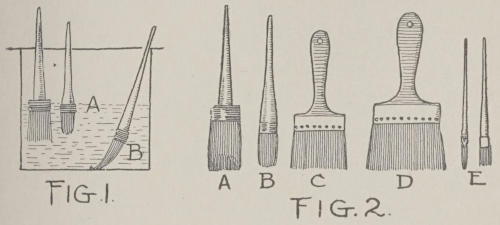
Fig. 1. Fig. 2.
There is nothing that freshens up a room so much as repainted wood-work, newly papered or tinted walls, and kalsomined ceilings; and while it may not be possible for a boy to become an expert paper-hanger, it is quite within his ability to tint walls and ceilings, paint wood-work, and varnish the floors. If he has any artistic faculty whatever[288] he can do a great deal of effective decorating, and this is a subject that we will now discuss at greater length.
There is no secret in the art of decorating. Good judgment, good craftsmanship, and common-sense, coupled with the use of the best materials, will always bring about good results.
The schemes that are shown in the illustrations on the following pages are those that any boy can carry out; and with a fair knowledge of carpentry, painting, and other crafts he will find it an enjoyable task to change his room into one containing characteristic features of his own invention or creation.
A very simple effect is shown in Fig. 3, and for this room it will not be necessary to remodel or change any of the wood-work. After removing all old paper from the walls with hot water and a sponge (and cleaning off the ceiling also), the walls and ceiling should be given a coat of size. This is made by dissolving a handful of good ground or flake glue in a pailful of water, and then painting it on the wall with a wide brush. Do not slop the size over the floor, nor have your brush too wet with the glue-water when you are using it. Try to work it in well rather than attempt to lay it on thick. When it is dry you can kalsomine, paper, or tint over the walls, and the size will help to hold the covering material in place. The wood-work in this room is painted white or a light shade of any color that is easily washed and kept clean. If paper is to be used on the side walls, some very good patterns can be selected at a stock house that will not cost more than twenty-five cents a roll.
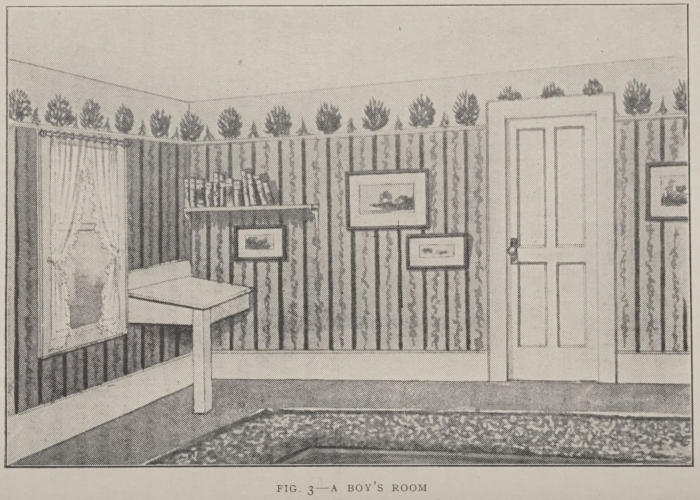
FIG. 3—A BOY’S ROOM
The pattern shown in this scheme is in stripes and running vines. Above the picture-moulding the wall is tinted or papered with a light-buff paper. With some apple-green fresco-paint the laurel-bush tops are drawn in above every other stripe, if they are wide enough apart. This makes a good finish to broad stripes that would otherwise stop at the moulding. A small desk can be built in one corner. It has a hinged top, and within it writing-materials may be kept. Above the desk a book-ledge may be attached to the wall with two brackets. Simple curtains at the windows and a painted or stained and varnished floor, with a carpet rug at the centre, will complete the decorating of this room. The cost should not exceed ten dollars.
Of the many attractive schemes for the decoration of the bedroom, there are none so pleasing and lasting as the plain paper and an ornamental frieze.
A full-pattern paper soon becomes tiresome, and while there are thousands of pretty figured papers adapted to bedrooms, at least one-half of the bedrooms in our homes are overdone or poorly papered. Small figures and as nearly neutral shades as possible should be used, as they are restful to the eyes, particularly in time of sickness. In Fig. 4 a pleasing scheme is shown, and while its beauty lies in its simplicity, it is quite as inexpensive as it is attractive.
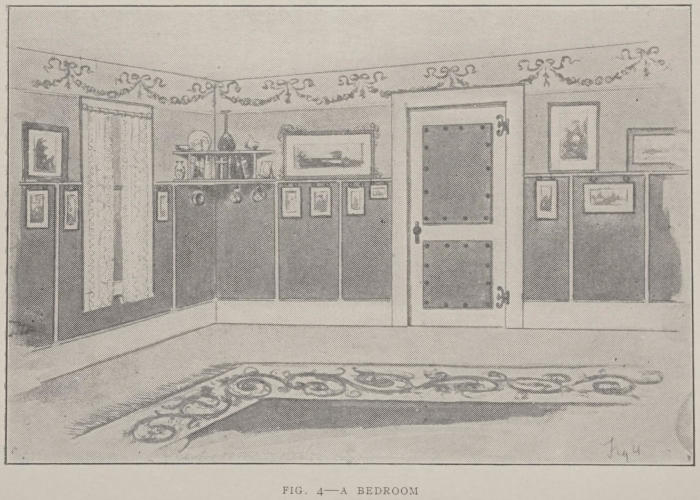
FIG. 4—A BEDROOM
Pink is the general tone, and the wood-work is painted cream color or light ivory. Four feet and six inches above the floor a rail is run around the room, and between it and the surbase vertical strips are made fast to divide the wainscot into panels.
Plain cartridge or ingrain paper is hung on the wall above the surbase, and between the rail and picture-moulding a lighter-pink paper is applied. This may be a finely figured paper, or a narrow, satin-striped paper that can be had at twenty-five to fifty cents a roll. A border paper with garlands and ribbons, to match the shade of the others, may be had by the yard or roll in several widths. Light shades of soft green or robin’s-egg blue, with white wood-work, always make an effective and cheerful combination.
An artistic effect for the door may be secured by making thin panels for the upper and lower sections, and covering them with a fabric or burlap as near the shade of the paper as it can be matched. These are attached to the door with a few large, oval-headed nails painted black. Sheet-lead escutcheons and hinge-straps can be made and applied to the wood with oval-headed upholsterers’ nails painted black. Any other metal-work in the room is to be coated black.
Pink, black, and cream, or pale-green, black, and ivory color make pleasing and cheerful combinations for bedroom decoration, and they do not become tiresome.
A feature in this scheme is the mode of suspending small pictures from the rail by means of harness-rings and large-headed nails painted black. The larger pictures hung above the rail are arranged so that the bottom of each is on a line with or touches the rail.
The arrangement and scheme for one side of a model boy’s room is shown in Fig. 5. In this attractive room the wood-work is white, or very light in color, and the walls a soft, light-tea or olive green. The border above the picture-moulding is a light shade of old pink ingrain paper on which the wreath and garland border is painted in fresco colors or stencilled.
At one side of the room a generous chest of drawers can be built in a corner, and three feet up from the floor a long drop-ledge may be made fast to the wall and arranged so that hinge-brackets will support it. When not in use for drawing or studying, the brackets can be folded in against the wall and the ledge dropped down. Above this ledge, and extending from the chest of drawers to a window or door, a compartment-nest of shelves may be made from three boards with shorter ones for partitions. This is supported every two feet of its length with brackets screwed securely to the under side of the bottom shelf and to the wall. At the top it is also secured with small strips of metal screwed fast to the back edge of the top shelf, and through which screws pass into the wall. Short curtains of some light material may be hung from a wire stretched along the under side of the top shelf and caught up to it in one or two places with staples.
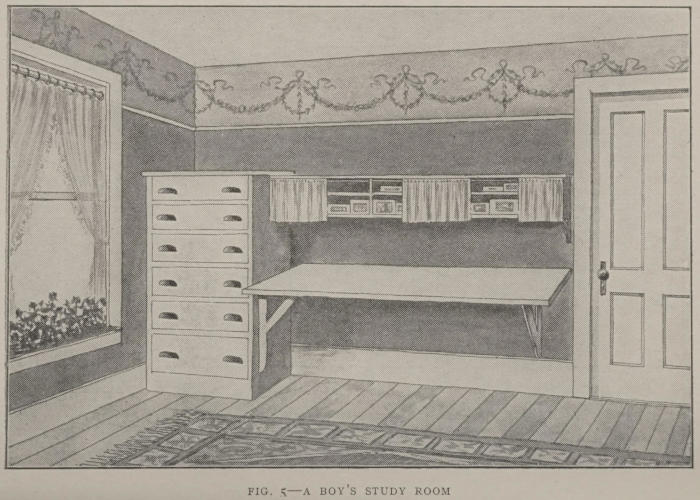
FIG. 5—A BOY’S STUDY ROOM
The floor in a boy’s room should be of stained and varnished narrow boards over which a rug can be thrown. This makes it possible for the outer edges of the floor to be wiped up frequently, and does not allow dust to settle at the corners or edges as it would in a carpet. All the metal-work, such as gas-brackets, hinges, hasps, escutcheons, handles, and catches, should be given a coat or two of black finish, which will lend them the appearance of being wrought iron.
The panelled wainscot in Fig. 6 is formed of vertical strips of wood four inches wide and four feet high, mounted above the surbase. On top of these a six-inch band of wood is carried all around the room, on which a five-inch ledge is mounted, the latter being supported on brackets which line with the centre of the vertical strips. The doors, door and window casings, surbase, and wainscot-rails are painted white, and all the hardware is black.
Hinge-straps of lead are cut and fastened to the doors and casings with large, oval-headed nails. To cover the panels in the doors, one large panel is made from thin wood. It is covered with burlap and nailed fast to the side of the door facing the room, with large-headed nails, or mock nail-heads not less than one inch in diameter. Four-inch ledges are placed over the door and window casings. These are supported by brackets at the ends that line with the middle of the casing uprights.
The walls above the wainscot-ledge are papered, and the panels in the wainscot are covered with burlap glued to the wall. The burlap on the panels and doors may be in a coffee or light-brown color, and the paper should then be a light shade of old green. The ceiling is tinted light buff.
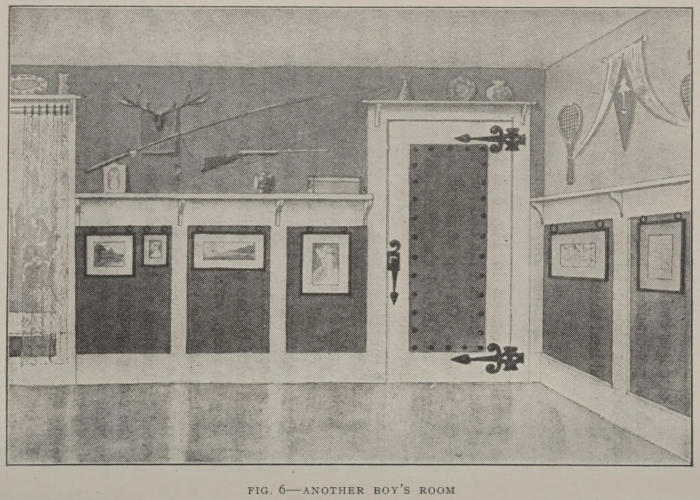
FIG. 6—ANOTHER BOY’S ROOM
If a boy has some younger brothers or sisters, he can fix up their room or nursery in some such manner as shown in Fig. 7. The walls are to be cleaned and sized; then the wood-work is painted white, and a toy ledge or rail is made fast with small brackets, two feet and six inches up from the floor, or about on a line with the window-sills.
The lower part of the wall is to be covered with dark-colored burlap, and above the ledge a lighter-colored burlap or denim is applied with heavy paste, to which a handful of glue has been added.
Another but narrower rail is made fast to the wall about on a line with the middle rib of the windows. Above that the walls and ceiling are painted in imitation of the blue sky with fleecy white clouds floating about. Paint in some birds flying in the air, and one or two perched on the tops of the window and door casings. If this work is well done it will have a very realistic appearance. Pictures may be hung above the toy ledge and under the top strip by means of large rings painted black.
The art of stencilling, although a very old one, is constantly being revived through the efforts of amateur craftsmen. Many of the art textiles now to be had in the art and dry-goods stores have printed patterns in imitation of this style of decoration. Nothing in the way of machine-printing, however, can equal the hand-stencilled fabrics.
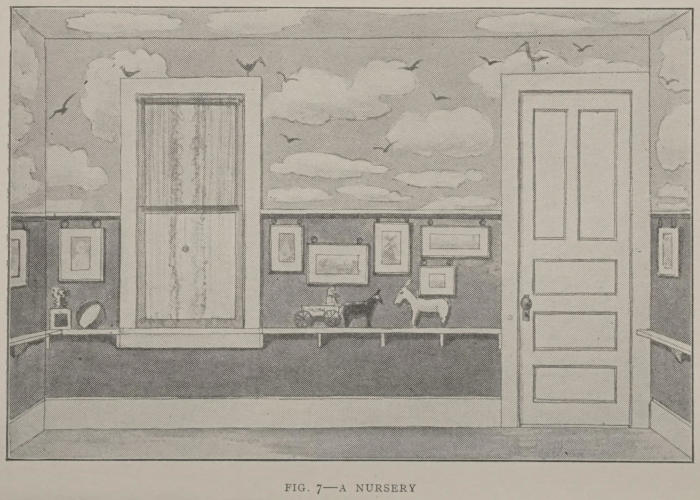
FIG. 7—A NURSERY
Simple figures are easily stencilled on fabrics, papers, or walls, and the beginner will be wise in using the small, clearly defined figures; then, as proficiency is acquired, the more intricate and ornate patterns and designs may be employed. Every young craftsman should cut his own stencil-plates from fibre or oil-board. It should be about the thickness of two ordinary calling-cards, and stiff enough to hold its shape. The design is drawn directly on the material, or on a piece of brown paper, and then transferred to the board. With a sharp knife-blade the outline is carefully cut, taking care to leave the bridges which are necessary to hold the parts together. This is clearly shown in Fig. 8, which is a small stencil for a fleur-de-lis. In Fig. 9 A the effect is shown after the pigment has been applied to the fabric or wall. If the ornament had been printed or stamped, however, it would have been made without any breaks, or as shown in Fig 9 B.
Fresco colors should be employed for stencilling on walls, but on fabrics aniline colors or diluted oil-paints may be used to good advantage. When preparing colors for fabrics, the tube oil-paints, or body colors ground in oil, should be employed. They should be thinned with benzine, and placed in the bottom of a dish or saucer, so that the stencil-brush will take up the colors at the tip ends of the bristles. Fresco colors for walls should be used thick, or about the consistency of rich cream, while those of oil or aniline need not be thicker than milk. Regular stencil-brushes must be used for this work. Such brushes may be had at any paint store, and will appear as shown in Fig. 10. Stencil-brushes are round, something like a shaving-brush, but the bristles are stiffer and are stubbed or cut square at the ends.

Fig. 8. Fig. 9. Fig. 10. Fig. 11. Fig. 12. Fig. 13.
When cutting your stencils, keep turning the oil-board so that you always make the cut towards you. Lay the material on a smooth piece of close-grained wood, or a sheet of zinc, and hold your knife with the blade in a vertical position, and not to one side or the other. Do not[301] make bevelled cuts. Straight ones are necessary or there will be smeared edges.
For a stencil-plate to make the garland and ribbon border shown in the frieze of the room (Fig. 4), a one-half section only is necessary (see Fig. 11). The full length of a garland is marked on the wall by indicated dots, with chalk or pencil; then the half garlands are stencilled all around the room. When completed, the stencil-plate is carefully wiped off; then it is reversed and the remaining halves are done. The stencil-plate for the wreath ribbon and garland border shown in the room (Fig. 5) is illustrated at Fig. 12. This is a half garland and wreath, and is used as described for Fig. 11. The stencil-plate shown in Fig. 13 can be used as the frieze or border in Fig. 6. This is an empire design, and its dignity and beauty make it a fitting ornament for any room in a house.
There is always a demand in the house for convenient places in which books, pamphlets, magazines, and papers may be kept, thus avoiding the necessity of scattering them over tables and shelves that are properly reserved for other things. Regular bookcases are suitable for a library, arranged especially for the purpose of harboring books, but for the sitting-room, bedroom, or hall the odd rack, shelf, hanging cabinet, or convenient nook is an acceptable addition to the ordinary furniture.
Among the following illustrations may be found a variety of ideas in book receptacles. Any of them can be made at home by the boy craftsman, of inexpensive materials that may be at hand, or cheaply purchased from a carpenter.
All of these designs are entirely practical, and may be constructed with the aid of ordinary tools, the joints, laps, and matched edges being of the simplest forms. The staining, decorating, and finishing of these pieces of odd furniture are easily within the average boy’s ability, and if the instructions are carefully followed the results should be most satisfactory.
Of these designs the wall-rack (Fig. 1) is perhaps the easiest to construct, since it is formed of but three shelves and some narrow rails.
A convenient size will be from twenty-seven to thirty-six inches long, twenty inches high (from top to bottom shelf), and eight inches deep. The extreme height from top to bottom, along the middle wall strip, is about thirty-eight inches. The wood should be three-quarters of an inch in thickness, planed on both sides, and free from knots or sappy places. The strips, excepting the centre-piece at the back, measure two and a half inches in width, and where one crosses another a lap is cut in each, as shown in Fig. 2. This may be done with a fine saw and chisel, and the joint held firmly with glue. Where the shelves join the uprights at the ends a groove is cut in the end-rails to receive the ends of the shelves, as shown in Fig. 3. The curved sections of the rails, the back-board, and the tops of the upright strips at the back should be cut with a compass-saw and afterwards sand-papered or dressed down with a wood-file. All the edges of the wood-work should be rounded by means of a small plane or sand-paper, since sharp corners are not desirable on useful furniture.
Long screws should be driven through the end-strips and into the ends of the shelves to hold them firmly in place. To cover the screw-heads and lend them the appearance of being large, wrought-headed nails, false heads should be made from scraps of thick sheet-lead and attached to the wood with slim, steel-wire nails. To make these heads,[304] disks three-quarters of an inch in diameter are cut from sheet-lead with a cold-chisel and mallet, the work being imposed on the upturned face of an old flat-iron. With a light hammer the edges are beaten to give them the appearance of anvil-made nails, such as were used years ago in decorations, and on antique chests, doors, leather-covered furniture, and walls laid in tooled leather. These nails were hand-made, and crude but artistic in appearance; they are always effective when used in connection with leather and wood-work.

Fig. 1. Fig. 2. Fig. 3. Fig. 4.
The ornament under the lower shelf of the rack is drawn on the bare wood, and tinted in colors to match the natural flowers and leaves. Use oil-paints thinned slightly with[305] turpentine, so as to give the appearance of a stain or dye rather than of an opaque color. All the wood-work is then stained some desired shade, and the outline of the ornament is either burned pyrographically or lined with dark-brown paint in imitation of a burned line. A bluish-gray is a pretty color for this wall-rack, and it can be made by thinning Payne’s gray and adding a small proportion of any good blue, such as cobalt, ultramarine, or cerulean. The stain should be applied thin, with a flat brush, and then partially wiped off with a soft rag. When dry, a coat or two of shellac will give a lustre to the stain, hold the color, and render an egg-shell gloss to the wood-work. (See Chapter XII. for instruction in Pyrography.)
A book-nest of quaint shape is shown in Fig. 4. It is formed of a back-board, two shelves, three brackets, and two slats that connect the shelves at the ends. This is a small piece of furniture and is intended to fill a small space; it should be from eighteen to twenty-four inches long. The shelves should be ten inches apart, and the under side of the lower one is supported by a long bracket, at the middle of which small corner shelves are arranged, as shown in the illustration. Holes may be made in these brackets, through which the stems of pipes can be inserted. The curved parts of the wall-plate are cut with a compass-saw and finished off with a wood-file.
It is not necessary that this home-made furniture should be absolutely smooth or the lines perfectly straight. A[306] slight variation from the manner in which shop-made furniture is constructed adds to the effectiveness of these book-racks and holders, and gives them the rough-and-ready artistic appearance that is characteristic of the “mission” and other popular styles of modern craftsmanship.
A simple arrangement of shelves in the form of a book-rack is shown in Fig. 5. Where there is room to accommodate a small standing receptacle of this nature, this design will be found both useful and ornamental.
The top shelf is about forty-two inches high from the floor, and in width the rack may be made to fill the available space, say from two to four feet. The corner-posts are of wood two inches square, and where the shelves are attached portions of the wood are cut away, as shown in Fig. 6. The shelf corners are cut out in such a manner that half an inch of the shelf edge enters the post, where it is held in place by means of glue and screws.
The screw-heads are covered with false nail-heads of lead. These, when finished, should be painted a dead black in imitation of wrought iron. An old green or a weathered oak color would be appropriate for this rack.
For the corner of a room where space is valuable an idea is suggested for a corner-nook (see Fig. 7). This is nothing more than a well-made box arranged with wall-plates that[307] extend down below the bottom of the box, and to which the ornamental wood-work over the box is attached.

Fig. 5. Fig. 6. Fig. 7.
The wings, or angle-shelves, and the brackets at the sides should be made to conform with the general proportions of the design. The working construction is so clearly shown that it is not necessary to minutely describe the smaller details. The shelves should be nine inches apart, and the width of the box must be governed by the space that can be allotted to it. The ornament at the bottom of the wall-plate is painted on, and then outlined with a dark-brown paint or burned. The wood-work is tinted an olive-green, or other desirable color, then shellacked.
An odd but useful piece of furniture is shown in the illustration of a book-tower (Fig. 8). It is suitable[308] for the corner of a room where the available space is limited.
This tower should be twelve or fourteen inches square and about seven feet high. The corner-posts are two inches square and the shelves three-quarters or seven-eighths of an inch in thickness. The shelves are let into the posts (as shown in Fig. 6) and securely fastened with long screws. The side slats are of thin wood. They are let into the edges of the shelves, where they may be fastened with glue and long, slim, steel-wire nails. Each joint or attachment should be finished with a lead nail-head, which should be painted black.
A very good dead-black paint for metals is made by thinning shellac to the consistency of milk, then adding some dry lamp-black until it is about the thickness of cream. This is applied in thin coats with a soft, flat brush. If one coat does not thoroughly cover the metal, another may be applied after the first one is absolutely dry.
Around the top of this book-tower a rail is arranged three or four inches above the top shelf, to serve as a guard for articles of bric-à-brac placed thereon. With the arrangement of slats shown in the drawing, the books are distributed in such a manner that the titles may be read from both directions instead of from one side only.
A unique design for hanging-shelves is shown in Fig. 9.
For general use the rack should be thirty inches long, the ends thirty inches high, and the shelves seven inches wide.[309] The space between the shelves should be ten or eleven inches, while the total height of the middle back strip is thirty-six inches. The other parts should be made in proportion to the drawing, and where the shelves join the sides mortises should be cut, through which to pass tongued ends, the latter being fashioned on the shelf ends, as shown in Fig. 10. With a brace and bit holes are made to receive wooden pins, or keys, that will lock the wood-work together.
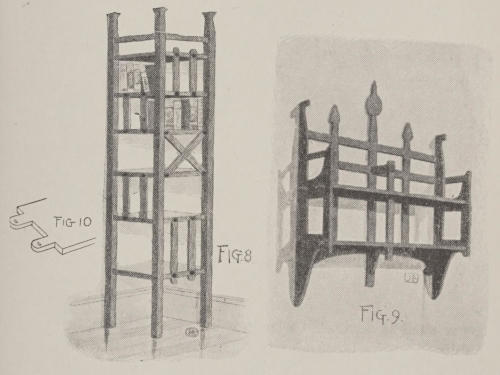
Fig. 8. Fig. 9. Fig. 10.
Olive-green will be an appropriate color for the wood-work. When attached to the wall, care should be taken to anchor it firmly and with heavy screws to the studs behind the plaster.
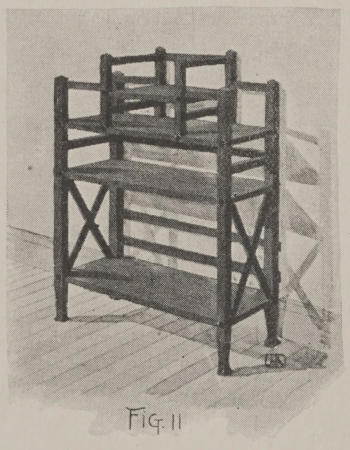
Fig. 11.
In the design for a book-castle (Fig. 11) the shelves and rails are arranged in such a manner that books may be slipped in from the front and also from both sides. The lower shelf is devoted to large volumes, portfolios, or serial publications in large sheets. The top shelf and the one under it are for volumes of medium size, while the small deck above the shelves makes a convenient receptacle for magazines.
The wood-work should be stained and varnished, or painted to match the trim of the room.
A novel idea is shown in the illustration of a book-chair (Fig. 12). A Morris chair may be made over on this plan, if the side spindles are removed and the receptacle is constructed beneath the seat. A very low Morris chair cannot be used, however, since the available space between the seat-rail and the floor is too cramped. Both sides of the chair are arranged to receive books, and at the front a wooden panel is fitted below the seat-rail, as shown in Fig. 13.
Cushions of burlap, tapestry cloth, or canterbury cloth may be made to fit the seat and back; they are held on with straps. The cushions may be filled with feathers, curled hair, cocoa fibre, moss or even cotton batting. Javanese kapok is perhaps the best of the lower grade material. It costs twenty-five cents a pound, and takes about two and a half pounds for a chair.
The ornament at the front of the chair is painted on and outlined with the pyrographic point; or a dark-brown line may be painted on with a fine brush.
For a library or sitting-room, the book-table shown in Fig. 14 will be found a convenient and useful piece of furniture.
A good size for this table is: length, forty-two inches; width, twenty-four inches; and height, thirty inches. The drop-shelves at the ends should be nine inches below the[312] top of the table, while the drawer need not be more than four inches deep. The legs are two and a half inches or three inches square. The slats at the sides of the bookshelves are let into the table-top and the shelf (see Fig. 15) and apparently anchored by means of large nail-heads. The top is attached to the frame by means of cleats screwed fast to the top inner edges of the rails. Through these cleats screws are passed up and into the under side of the table-top, as shown in Fig. 16.
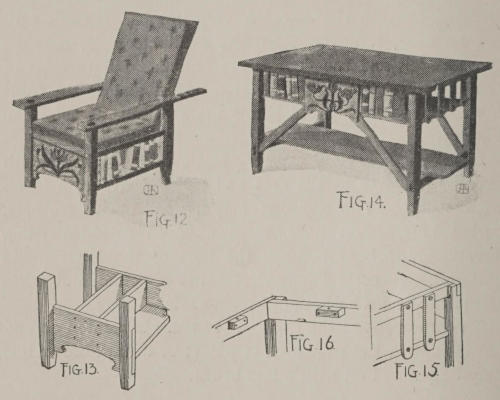
Fig. 12. Fig. 13. Fig. 14. Fig. 15. Fig. 16.
White-wood is a good material of which to make the table, since it takes a stain nicely. Finish with a coat or two of shellac.
A convenient rack for magazines and periodicals is shown in Fig. 17.
The rack has three shelves and an enclosure at the top to hold extra large pamphlets. The two uprights and the cross-strip at the top are three-quarters of an inch thick and two and a half inches wide. The uprights are twenty-four inches long, and the cross-piece measures eighteen inches from tip to tip. Four inches from the top the uprights are cut, as shown in Fig. 18 A, so that a lap-joint can be formed. The uprights are spaced ten inches apart from the inside edges, making the total width fifteen inches.
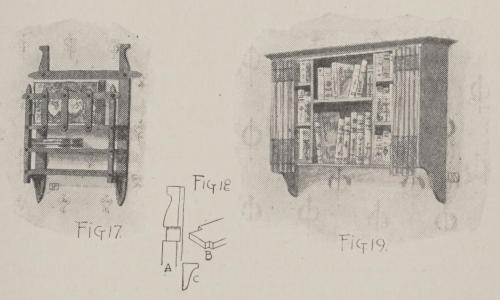
Fig. 17. Fig. 18. Fig. 19.
From half-inch wood cut three shelves fifteen inches long and six inches wide; also two corner-posts from wood an inch square. Cut the end of each shelf as shown in Fig. 18 B, so that one notch will fit against the upright and the[314] other against the corner-post. From the half-inch wood cut two brackets three inches long and two and a half inches wide at the top, as shown at Fig. 18 C. These hold up the bottom shelf, and the other shelves are supported in turn by the corner-posts and the back, to which the shelves are securely attached with screws and glue. The corner-posts are fifteen inches high, and near the top laps are cut half an inch deep and one inch wide into which a cross-rail will fit. Three thin slats one inch in width and six inches long are made fast across the front, and above the top shelf, to form the pamphlet or periodical rack. The nail and screw heads may be covered with brass upholsterers’ tacks painted black to suggest the idea of a large nail, or imitation wrought-iron nail-heads may be made by cutting disks out of sheet-lead and slightly beating the edges so as to imitate the hammer-marks of wrought-iron work. These disks are secured to the wood with slim steel nails, the heads of which, when driven in with a light hammer, become imbedded in the soft lead. A subsequent coating of black paint will conceal the nail-heads completely.
Fig. 19 is an idea for a receptacle for a few books, bric-à-brac, and some magazines to hang against the wall. Boxes of various sizes may be used for this purpose, according to the available wall space, but for general use two shoe-cases should be cut down so as to make them thirty inches high and seven inches deep. In each one two shelves can be arranged.
The boxes are held together at top and bottom with boards seven inches wide and thirty-six inches long. Between the boxes a shelf may be fastened about midway between the top and bottom boards. A wooden back is not necessary to this case, as the wall itself will answer the purpose; but around the top edge a strip of cornice-moulding is to be mitred at the corners and attached with long, slim nails or screws. Under the lower corners wooden brackets may be fastened to the wall, or when the shoe-cases are being cut down one side may be trimmed, with the compass-saw, in the form of a bracket end. A rod fastened at the top and under the moulding will support light curtains, but this last feature may be omitted at pleasure.
A nursery is not quite complete without some receptacle for the accommodation of the children’s scrap and picture books. A simple and useful design is shown in Fig. 20.
A well-made box of thin boards, planed on both sides, forms the basis for this bookcase. It should be of medium size and not more than seven inches deep. Remove one side or the top, so as to leave it open at the front, and arrange a shelf in the open space. The box should be at least sixteen inches high to accommodate two rows of books, and it would be better to have it eighteen inches. Two brackets eight inches high and six inches wide at the top are placed under each end of the box. Across the top, at the back, a wall-plate is cut and attached with two slim screws that pass down through the narrow part near the[316] ends and into the back of the box at the top. Around the top of the box a narrow strip of moulding should be mitred and fastened with steel-wire nails. The wood-work may then be given a coat of stain and shellac. Across the front of the box and at the top a brass or iron rod may be attached at the ends, from which curtains are suspended by means of rings.

Fig. 20. Fig. 21.
When fastening this case to the wall, it would be well to drive two or three screws through the back of the box and into the wall-studding, otherwise the weight of books might tear it away from its bracket anchorage.
In Fig. 21 an odd shape for a book-rack is shown.
This is also made from a box by removing one side and resetting it closer to the other side. A portion of the[317] lower end is sawed off, and a part of the bottom is cut away so as to form a small, quarter-circular bracket. The extending upper end of the box is supported with a short bracket, as the illustration clearly shows, and under the box two large brackets ten inches deep and the width of the back and side support the rack in position. Two wall-plates four inches high at the angle are attached at the top of the box with screws. A curtain-rod is attached at the top of the case from which a curtain may be hung, and the ledge formed by the top of the case and the quarter-circular bracket will accommodate a few pieces of bric-à-brac or a photograph frame or two. If the box is high enough, two shelves may be arranged so that three lines of books can be accommodated; otherwise one shelf will have to suffice.
A place to put books and a place to keep bats, golf-clubs, lacrosse-sticks, and other things that are always around, is a convenient possession.
Here is a solution of the problem: The case shown in Fig. 22 should be about five feet six inches high and three feet wide. The shelf across the top would hold a number of books, and underneath are two beautiful tuck-away places. If, my friend, you are a college boy, the curtain could be of your college colors; the rest of the case stained a becoming color. The door is fastened by a big wooden latch, and a pair of iron hinges would add very much to the style of the bookcase.
If, however, you are of a studious frame of mind, and[318] have been fortunate enough to collect a number of books, the second case would probably be more to your liking.
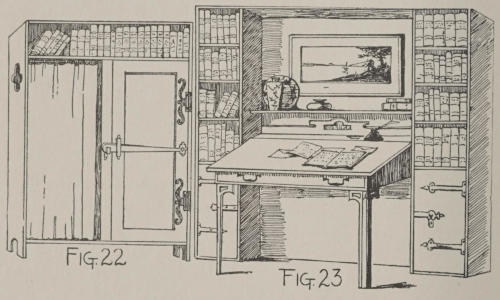
Fig. 22. Fig. 23.
We will suppose that you have already a desk. Make two upright rows of bookshelves far enough apart to allow the desk to be placed between them. Shut off the lower part of the shelves, on each side, with a door, which may be decorated with iron hinges or blackened metal. These false hinges are of course placed against the real ones on which the door swings, and are purely ornamental. These little closets make fine places in which to store unsightly books and magazines which look untidy but which one always wants to keep. There is a shelf over the top of the desk on which could be placed a row of plates, a tankard, or photographs; and a poster or nice little etching would give interest to the big panel. This panel, by-the-way,[319] need not be made of wood, but could be closed in by a piece of colored burlap or buckram. The case would then have to be braced by three slats of wood nailed across the back behind the buckram. When completed it will appear as shown in Fig. 23.
Two interesting and useful pieces of furniture are shown in the drawing of a book-ledge and stool (Fig. 24), and as the main shelf is but fourteen inches wide it will not occupy a great deal of space in a room.
The main shelf is forty-two inches long, fourteen wide, and one inch and a quarter thick. The side pieces, or legs, supporting it are twelve inches wide and thirty-three inches high, with V-shaped pieces cut from the foot of each one. These pieces are thirty-six inches apart, and arranged between them, and twenty inches above the floor an under ledge eight inches wide is fastened with long screws and brackets. Nine inches above the main ledge a top shelf is supported on side legs, which, in turn, are propped at the outside with wood braces, or blocks, six inches high and four inches wide at the bottom. The side supports are placed the same distance apart as the underside pieces, and are held in position on the top of the main ledge with short dowels, or pegs, driven in their under end, and which fit into holes bored in a corresponding position in the ledge. This upper section may be omitted, however, if the plain ledge is preferred.
The stool is twelve inches square and twenty-two inches[320] high. The top is covered with a stout square of leather caught all around the edges with nails and imitation nail-heads. The lower rails that bind the posts together are one and three-quarter inches wide and seven-eighths of an inch thick. The posts are one and three-quarter inches square, and the rails are let into them three inches up from the floor. The top rails are the same width, and all let into the top of the posts with the lap-joint union, where they are glued and screwed fast. Small brackets under these rails will add an element of support, and they can be dressed out of seven-eighths-inch wood with a compass-saw, and made fast with glue and screws. These brackets are comparatively small, being two and a half inches wide and four inches deep, but they must be cut accurately to fit well.
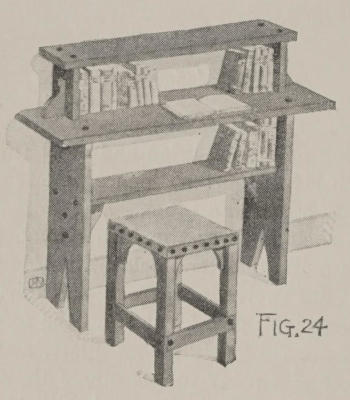
Fig. 24.
Among the many useful and attractive pieces of furniture that a boy can make to help furnish a home, clocks and timepieces offer a good field for endeavor. Now, a clock is more often looked at than any other piece of furniture; consequently, it should be a thing of beauty rather than a distracting eyesore. And, since it is no more expensive to construct a clock on good lines than on poor ones, there is no reasonable excuse for the inartistic, commonplace designs that are displayed for sale by jewelers, department stores, and house-furnishing shops.
Several good designs for simple and artistic cases are shown on the following pages, and none of them are too intricate to be made at home by the boy who has gained some knowledge in the handling of tools. There is nothing in their construction that requires the services of a cabinet-maker, and the movements may be had from a clock-manufacturer, or perhaps taken out of an old or unsightly case. For instruction in the use of the pyrographic-point, see Chapter XII.
Thin white-wood or pine boards, sheet-lead, stain, and shellac are some of the simple materials needed; and the[322] tools required will be those that may be found in every household, such as a saw, hammer, plane, awl, square, mallet, compass-saw, and brace and bit. Some steel-wire nails, glue, sand-paper, and black paint will complete the list of necessaries, and the various small accessories may be had at a hardware store at a nominal outlay.
A design for a simple bracket-clock is shown in Fig. 1, and the case is so plain in construction that any smart boy can easily make it from thin pieces of board half an inch in thickness, half a yard of burlap, and some sheet-lead.
The box part of the clock is eight inches square and three and a half inches deep. The brackets are extensions of the sides, cut as shown in Fig. 2 A; they drop eight inches below the bottom-board of the case. The dial and glass frame measure six inches in diameter, and to fit them to the box it will be necessary to cut a hole in the front of the case five and a half inches in diameter, as shown in Fig. 2 B. The shelf-top to the box is bevelled at the under side, and is attached by means of glue and nails; it overhangs one and a half inches at the front and ends. The sides and front of the box are then covered with tinted burlap in a soft, old-green, red, or tan shade, and the exposed wood-work is stained a color to match. When dry it is given a coat or two of thin shellac to lend a lustre to the grain and stain.
To hide the joint between the cap and the body of the clock, a round piece of wood, such as a dowel, should be[323] inserted and nailed fast; or a narrow strip of picture-moulding can be used.
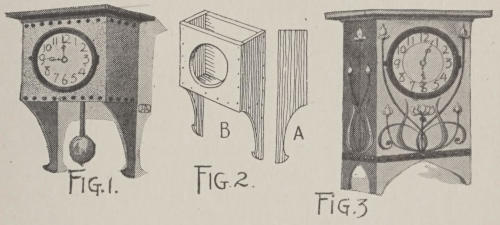
Fig. 1. Fig. 2. Fig. 3.
If it is impossible to find the large nails that bind the corners at a hardware store, they may be made from sheet-lead. Disks half an inch in diameter are cut from the lead by means of a small cold-chisel and mallet. The edges of the disks are beaten with a tack-hammer to give them the appearance of a rough, hammer-headed nail. These disks are painted with a dead-black paint, made by adding a small portion of dry lamp-black to thin shellac, and applying it to the metal-work with a soft brush. These heads are attached to the clock, as shown in the illustration, at regular distances apart, with thin, small-headed, steel-wire nails, which when driven in and painted with the black preparation become invisible.
The movement, which may be of either the spring or weight kind, is attached to the back of the case before the dial is made fast, and the pendulum-rod is dropped through a slot cut in the bottom-board.
If the mounting is bothersome, however, a clock-maker[324] will arrange it and adjust the dial and space the hands properly.
A metal hanger at the top and two long, slim screws driven through the bottom of each bracket will hold this clock in place against the wall.
A simple but artistic mantel-clock is shown in Fig. 3. It is seven inches wide, thirteen inches high, and three and a half inches deep. It is made from thin white-wood, pine, cypress, or almost any soft wood.
The top, or cap, is of half-inch wood, and it projects one and a half inches beyond the front and sides. A small moulding, or a dowel, is cut and mitred around the top under the cap. At the bottom the feet are made by cutting out pieces of the wood with a compass-saw. A small pendulum movement is mounted against the back before the dial and glass frame are set in place.
The ornament on the front and sides is outlined with pencil, and after the wood-work is stained a soft-brown, an old-green, or any desired shade, the lines of the ornament are pyrographically burned. Or they may be painted with a dark-brown paint in imitation of pyrography. Below the ornament a half-inch band of sheet-lead is laid around the body of the clock and held on with large, oval-headed upholsterers’ nails painted black.
An attractive wall-clock is shown in Fig. 4, page 327. With a movement having a fifteen-inch pendulum, the case[325] should be ten inches wide, twenty-four inches high, and four inches deep. A circular opening is made at the upper end of the box, and an oblong one at the lower end through which the pendulum may be seen. The box is covered with burlap in some desirable shade; it is applied with glue and large-headed nails, or dummy heads.
The ornamental design is cut from sheet-lead and applied with slim, steel-wire nails. The frame around the lower opening is cut from lead and applied over a piece of glass which is cut and fitted to the opening. The stems to the buds are made of thin telegraph wire, bent to the proper shape, and applied with small staples made from pins.
The top is cut from white-wood five-eighths of an inch thick; it overhangs the sides and front two inches. Where the top is applied to the body of the clock, the joint is hidden with a small strip of moulding, or a dowel mitred at the corners, and attached with slim, steel-wire nails.
The large nail-heads all along the edges are made from sheet-lead beaten to represent wrought-iron bellows-nails, and fastened on with thin, steel nails, and afterwards painted black.
The bottom of the box should be arranged on hinges, and caught with a small bolt so that it may be dropped in order to start the pendulum, and also to adjust the screw at the bottom of the rod.
A pleasing combination of colors for this case will be light, olive-green burlap, black metal-work, and old-brown wood-work. The pendulum-ball may be of bright brass or blackened. Equally effective are combinations of red burlap and brass trimmings, or old-gold-colored burlap and[326] Pompeian-green metal-work, made by tinting all the metal parts with a light and dark olive-green paint blended together on the parts.
For the space over a mantel, or wherever it may be convenient to hang it, a substantial high wall-clock is shown in Fig. 5. It is ten inches wide, thirty inches high at the front, and four inches deep, with the bracket-ends and the fancy top-pieces extending five or six inches beyond the body of the clock at top and bottom.
In construction it is somewhat on the lines of the “mission” furniture, the pieces being tongued and pinned, with a heavy slatted front.
The wood-work is five-eighths of an inch in thickness. The cross-rails are two inches in width, and the upright ones and the lattice are one and a quarter inches in width. The ends of the cross-pieces are shaped as shown in Fig. 6. When passed through mortises cut in front of the side boards they are held in place with wooden pins.
At the back, near the top and bottom, two-inch cross-strips are let into the side boards. The ends should project two inches beyond the boards at both sides, and holes are made in them through which screws are passed to anchor the clock to the wall.
An eight-day movement, with a twelve-inch pendulum, is made fast to a back-board, and on the front-board, to cover a hole eight inches in diameter, a large dial and glass are fastened.
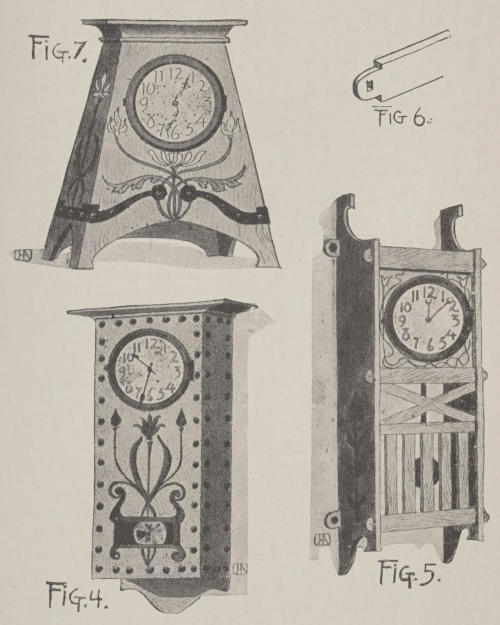
HANGING AND MANTEL CLOCKS
Fig. 4. Fig. 5. Fig. 6. Fig. 7.
The ornament at the sides and on the front-board around the dial is cut with a carving-chisel, and tinted to darken the lines. Stain and varnish will be a desirable finish; or the stain alone may be used should an old, dull appearance be desired.
The design for a mantel-clock that is odd in shape and striking in appearance is shown in Fig. 7. It is seven inches wide at the top, underneath the cap, and ten inches across at the base. In width it varies from three inches at the top to four and a half inches at the base.
The case is made from three-eighths-inch white-wood and joined with glue and nails. The top is of core-moulding that may be had at a carpenter-shop or planing-mill. It is mitred to fit at the front and ends.
The metal straps are of lead and the ornament is tinted and outlined. A great deal of the beauty of this design is in its coloring, and, unfortunately, this cannot be reproduced. The wood-work is in light golden-brown, the buds in orange, toning down to a deep red at the base, or similar to the colorings of the California poppy. The stems and leaves are in several shades of green, and the entire ornament is lined by the pyrographic-point, or painted with a line in dark brown. The straps, nails, and glass frame are in dead black, and the cap-moulding is in a darker shade of brown than that employed for the body color of the case. A pale, old-pink dial, on which black numerals are painted, completes this harmonious color-scheme.
A quaint clock is shown in Fig. 8, and it is quite as simple to construct as it is in appearance.
It is fourteen inches wide, twelve inches high, and four and a half inches in depth. A six-inch dial and glass are mounted on the front, and in the bottom of the movement-box a narrow slot is cut to accommodate the swing of the pendulum-rod.
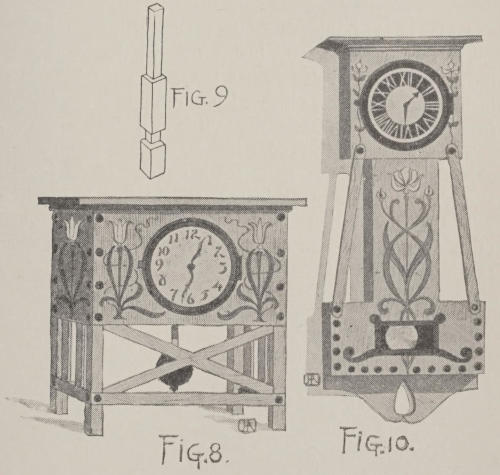
Fig. 8. Fig. 9. Fig. 10.
White-wood boards three-eighths of an inch in thickness[330] are fastened to corner-posts, having the two upper sides cut away as shown in Fig. 9. Laps are cut at the lower end of each corner-post into which the rail fits, as also shown in Fig. 9.
The same general description given for the other cases applies to this one, and after the ornament is stained and lined the surface of the wood may be lightly lined from top to bottom with the pyrographic-point.
A case of old-fashioned design is shown in Fig. 10.
The top measures eight inches square; the waist is five inches wide and twelve inches long; and the base is six inches high and twelve inches long. Two bars are fastened from the top to the base; they pitch at a slight angle.
The average depth is four inches, and the top, or head, extends out over the waist for a quarter of an inch, or enough to make a break in the straight line of the front.
The ornamentation is carried out as described for the other designs, and if properly constructed this clock should present a very unique appearance.
Among the many convenient pieces of furniture that a boy can make for the home, there are, perhaps, none that are so handy and generally useful as screens, shoe-boxes, and settles of various kinds.
Screens in particular are of so many and varied designs that it would be quite impossible in this short chapter to give more than a few of the simpler forms; but they will serve as hints for others.
One of the easiest screens to make, and perhaps the most generally useful, is that shown in Fig. 1. This is a light-screen, which may be easily taken from one room to another.
Four rails of pine or white-wood are cut and tapered at one end for the tops, and slightly cut away at the other for the bottom, as shown in the illustration. The rails are four feet six inches long, two and a half inches in width, and seven-eighths of an inch thick. Dowels five-eighths of an inch in diameter are used for the cross-sticks. They can be purchased at a hardware store or from a cabinet-maker, and should be cut twenty-four inches long. Holes[332] are to be bored in one edge of each strip, into which the dowels are driven, and fastened with glue and small nails. Four or five dowels will be sufficient for each wing, and they should be spaced evenly, the first one four inches below the top of the rails and the bottom one ten inches above the floor.
The wings are fastened together with two or three hinges, so that the screen may be folded and stood in a closet or behind a door when not in use.
Some pretty figured material, such as China silk, silkoline, cretonne, or printed cotton goods may be used for the covering, which is to show on both sides of each wing. It should be from three to five feet wide, so as to allow for some fulness. One end of the goods is tacked to the top dowel; then it is passed around the bottom dowel and brought up to the top, where it is again tacked fast. Some narrow gimp and brass nails will hide the edges of the goods at the top, and to hold the material in place a few tacks may be driven along the bottom dowel.
The wood-work should be painted, or stained and varnished, before the covering material is put on. If a dull finish is desired, some dark paint may be thinned with turpentine and rubbed on with a soft cloth, then partially wiped off and allowed to dry. It will not be necessary to varnish or shellac the surface, but a little beeswax can be dissolved in turpentine and rubbed on.
When an open fire is burning on the hearth a screen that will protect the eyes from the glare, and yet allow the heat[333] to reach the lower part of the body and the feet, is a useful piece of furniture.
A simple screen of this description is shown in Fig. 2, and for a living-room or bedroom it should measure thirty-six inches long, forty-two inches high, the screen proper being eighteen or twenty inches wide.

Fig. 1. Fig. 2. Fig. 3. Fig. 4. Fig. 5. Fig. 6. Fig. 7. Fig. 8.
The uprights are of wood two inches square, and the cross-rails are seven-eighths of an inch thick and two inches wide. The joints are mortised and tenoned, and held with screws and glue, while the apparent fastenings are large, round, mock nail-heads. The feet are cut from[334] hard-wood seven-eighths of an inch in thickness, as shown in Fig. 3, and attached to the bottom of the upright posts with glue and screws, the vertical edges of the feet being let into a lap cut in the posts. Each foot will then measure eighteen inches across at the bottom, and twelve inches high from the floor to the top of the lap cut in the posts.
Leather, burlap, denim, tapestry-cloth, or any good covering fabric, may be used for the screen. This material should be tacked on the top and bottom rail with large upholsterers’ tacks painted black.
A design may be lightly drawn on the fabric with a pencil, and afterwards painted in oil or water colors, or the ornament may be stencilled on with aniline colors, as described in Chapter XIX.
For a bedroom a convenient screen is shown in Fig. 4. This is properly called a shoe-screen, since there is a ledge made fast to the lower part of it to serve as a rest for the foot when lacing or buttoning shoes. There are also two rows of pockets on the inside of the screen, into which shoes, slippers, and sandals can be slipped.
A convenient size to make this screen is three feet six inches high and two feet six inches wide. The foot-ledge should not be more than fourteen inches above the floor and six inches wide. The frame may be made from any easily worked wood, since when it is painted, or stained and varnished, nothing but the grain will show. The uprights should be three inches wide, seven-eighths of an inch thick, and three feet three inches long. Lap or[335] dowelled joints should be made at the top corners, and at the foot of both pieces notches are to be cut in with saw and chisel, as shown at Fig. 5. The foot-pieces may then be driven up in place and made fast with screws or slim nails driven through the projecting ends of the side uprights and into the feet. The feet are of wood seven-eighths of an inch thick, sixteen inches long, and six inches high. The pattern may be drawn with lead-pencil on the wood; then, with a compass-saw, cut the wood on the lines, having first clamped the piece in a vise to hold it securely. The foot-shelf is made fast to the screen after the covering material is in place, and at both ends it is supported with brackets, the lower ends of which are made fast with screws.
A cross-rib should be made fast in the screen-frame midway between the top-rail and the one to which the ledge is attached, and a line of tacks is driven through the covering material and into the frame on both sides. This is to give a better finish, and also to support the rows of pockets when full of shoes.
The strip of denim for the pockets is seven inches wide and hemmed on both edges. It is then caught to the covering material so that generous pockets will be formed, each one being large enough to accommodate a pair of shoes.
The front of the screen may be covered with a fancy-figured material fastened on with small tacks; over this a gimp to match the material can be laid and held down with large-headed tacks, such as may be purchased at upholstery supply stores. The painting, staining, or varnishing should, of course, be done before the fabric, or covering material, is made fast to the frame.
At night it is often agreeable to have a bedroom door left open. Yet one does not want to sleep in an actual draught, and a screen such as is shown in Fig. 6 will be found most useful.
This screen is in one piece, six feet six inches high and eighteen inches wide. The frame is made from pine, white-wood, or any other wood to match the trim of the room. Two cross-rails are fixed so as to remain equal distances apart, thus forming three panels to the screen. Hinges are arranged at one edge, which in turn are made fast to the door-casing, so that when the screen is not in use it can be thrown back against the wall; or, if thought preferable, eyes may be driven in the casing and hooks in the edge of the screen, so that it may swing as if on hinges, and yet be lifted off at will and set away in a closet. An eye on the door and a hook on the screen will serve as a fairly secure fastening against intrusion. Any pretty material that matches the paper of the room may be used to cover this screen, and the edges should be bound with gimp and large-headed tacks to give it a good appearance.
For a dining-room, living-room, or library, an attractive design for a heavy fire-screen is shown in Fig. 7. This is constructed of oak, ash, or other hard-wood. It is thirty-six inches wide, forty-two inches high, and the rails and feet are one and one-eighth inches thick. The uprights and[337] cross-rails are four inches wide, and the top and bottom of each upright are cut as shown in Fig. 8.
The cross-rails should be mortised in the uprights, or they may be made fast by butting one end against an edge and securing the joint with dowels. The feet are fourteen inches across at the bottom and fifteen inches high. They are glued and screwed in the laps cut at the lower ends of the uprights, and the screw-heads are covered with imitation wrought-iron nail-heads beaten from sheet-lead and attached with steel-wire nails, the heads of which are invisible when driven into the lead.
The side of the screen which faces the fire should be covered with burlap, denim, or other stout cotton fabric. The outer side of the screen should be faced with leather, on which the ornamental design is followed out with stains and pyrography (see Chapter XII).
The leather should be caught to the frame with tacks placed two inches apart, and also glue. Over the tacks imitation lead heads may be secured with slim, steel nails.
In the drawing of the window-seat with under ledge (Fig. 9) an odd but useful piece of furniture is shown. It is made from two boards fourteen inches wide and forty inches long, two end-pieces fifteen inches wide and twenty-two inches high, and four brackets eight inches on the right-angle edges. These latter are necessary to brace the top and ends, as shown in Fig. 10 A A.
The top shelf, or seat, is eighteen inches high from the[338] floor, and the under ledge is made fast eight inches below it. The fastening is made with screws and liquid glue, and allowed to stand several hours before the drapery is attached.
For the upholstery material the dry-goods stores offer quite a variety of stuffs from which to choose. The least expensive are burlap, denim, cretonne, and some of the heavy, cotton, printed goods. Other fabrics, richer in appearance and more lasting, are velour, tapestry-cloth, rep, and brocade. Goods of this class will cost from fifty cents to several dollars a yard.
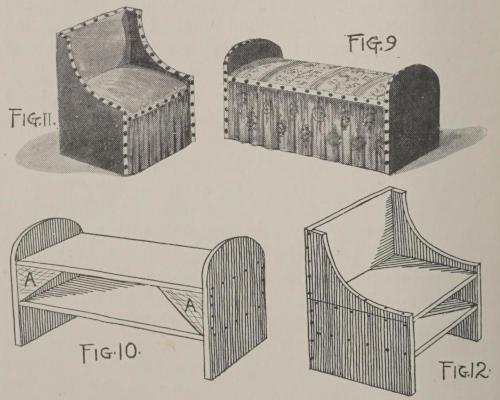
Fig. 9. Fig. 10. Fig. 11. Fig. 12.
To upholster this seat, obtain some curled hair from an[339] old mattress, and spread it over the top board, having first tacked a piece of unbleached muslin along one edge of the seat. When a sufficient quantity of the hair is on the board, draw the muslin over it, and tack it down along the other edge and at the ends. Over this the fabric can be drawn and tacked.
The end boards are covered with plain goods of the same color as the seat and flounce, and the edges are bound with gimp an inch wide, held down with large, oval-headed upholsterers’ tacks painted black. Across the back of the seat (the part that goes against the wall or window-base) plain goods can be drawn and tacked, or it may be left open.
The front is provided with a flounce made by shirring the goods on a stout cotton cord and tacking it along the front of the top board, then covering the tacks with gimp and nails, as shown in the drawing. A coat of paint or shellac at the inside will finish the wood-work, and it will then be ready for use.
A shoe-box seat is easily made and upholstered, and will be an acceptable addition in any bedroom (see Fig. 11). The sides are eighteen inches wide, thirty-six inches high at the back, and twenty-two inches at the front. The seat and ledge under it are each eighteen inches square, and the boards forming the back extend down to the floor. The parts are put together with screws and glue; then the seat is upholstered with curled hair, as described for the window-seat (Fig. 9).
The framework for this seat could be made from a box with the bottom and one side removed. The arms should be cut from a separate piece of wood and screwed fast, as shown in Fig. 12 by the line along the shaded side.
Plain or figured goods may be used for the covering material. It is drawn and caught with tacks at the edges; then the joints may be hidden with gimp and large-headed tacks. If it is possible to procure some English bellows-nails they will add an artistic effect to the trimming. If they cannot be had, very good imitation heads may be cut from sheet-lead with a pair of old scissors or shears. After beating them about the edge to flatten them and lend a hand-forged effect, these disks should be attached to the wood with long, slim finishing-nails of steel wire, which, when driven into the heads, become imbedded in the lead and are not seen. They should be painted black with a solution of shellac in which some dry lamp-black has been mixed to the consistency of cream. Apply with a soft brush.
In the illustration for a dressing-room settle (Fig. 13) a comfortable piece of furniture is illustrated, and in Fig. 14 its construction is clearly indicated.
The ends are three feet high and sixteen inches wide. The back-boards extend from the top of the ends down to the floor, and are attached with screws. The seat and under ledge should be from thirty to forty-eight inches long, according to the space it will occupy against the wall or under a window.
The upholstering is done as described for the other pieces of furniture, save that a more elaborate ornamentation is suggested for the end-pieces. The design is drawn in free-hand, and then embroidered on with heavy linen thread. Mother or elder sister will have to help out with the needle-work.
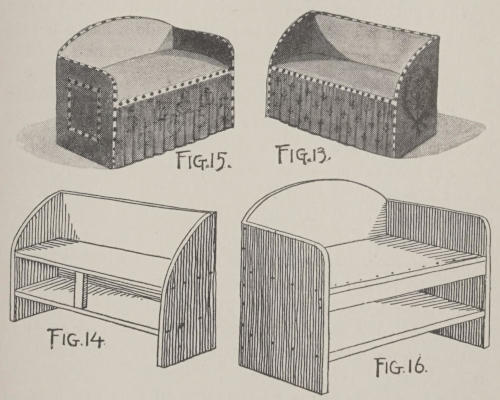
Fig. 13. Fig. 14. Fig. 15. Fig. 16.
A short settle with under ledge (Fig. 15) is another comfortable piece of bedroom or sitting-room furniture. In Fig. 16 the constructional diagram is shown for the arrangement of its sides, back, and under ledge.
The ends are sixteen inches wide and twenty-three inches high. The back extends down to the floor, and above the ends it curves or rounds over, extending up about five inches higher than the tops of the ends. Under the seat a strip of wood two and a half inches in width is attached at both ends, and the front edge of the seat is screwed fast to it. This acts as a support, and obviates the necessity of a brace block.
When putting on shoes it is convenient to have a short bench on which to rest the foot, and while a hassock will answer well enough, it is not so good as a bench or so easily handled.
Fig. 17 shows a neat foot-bench that is easy to construct from four pieces of wood. In Fig. 18 page 345 the plain bench is shown, while at B a view of the inverted bench is given so that the cross-bar may be seen.
The top board is eighteen inches long, ten inches wide, and an inch thick. The ends, or legs, are seven inches high and eight inches wide, with a V notch cut in from the bottom of each. These feet are set fourteen inches apart, so that there will be two inches of overhang at each end of the bench; that is, the top will extend two inches over the legs at each end. The brace shown at Fig. 18 B is two inches wide, twelve and a half inches long, and an inch in thickness.
The four parts are put together with glue and screws; then the top is padded with curled hair and upholstered as already described.
From two canned-goods boxes the combination shoe-box and seat may be made, as shown in Fig. 19, Fig. 20 being the structural plan.
The left-hand box in Fig. 20 has the lid removed, and a shelf is inserted so as to divide it into two compartments. The other box is provided with a hinged lid. Instead of making the hinges fast to the edge of the box, a strip an inch or two wide should be attached to the rear of the box, and to this the lid is hinged, as shown in Fig. 20. The two boxes are screwed together, and a back is provided for the one on the right. The board forming this back should extend the entire length of the two boxes, and should be secured to them with stout screws. The tops of the boxes are padded with hair, and the sides are covered with upholstery material of any desirable color and quality, the edges being bound with gimp and nails.
The inside of the low box and the under side of the lid should be provided with denim pockets, as shown at Fig. 21. These pockets are formed by tacking a strip of denim to the wood and allowing fulness enough to accommodate a pair of shoes or slippers.
It furnishes the inside of such boxes nicely to line them with unbleached muslin tacked at the corners and edges. Where wood is exposed in the ledge and shelf seats a coat of paint or shellac is desirable.
Three well-made boxes, two of a size and one longer, will[344] make the foundation for a double shoe-box and seat, such as is shown in Fig. 22.
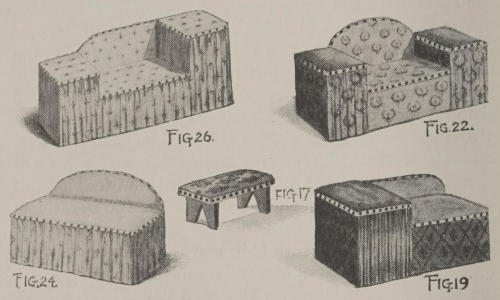
Fig. 17. Fig. 19. Fig. 22. Fig. 24. Fig. 26.
In Fig. 23 the structural arrangement is indicated. The end boxes are provided with two shelves each, and the middle one is fitted with a back-board, which is rounded over at the top and projects about six inches above the top of the end boxes.
The middle box is provided with a lid and hinges which are made fast to a back strip, so that when the lid is raised it will not fall again, but will stand out an inch or two from the back-boards.
Fig. 24 illustrates a useful piece of furniture. The box part, or frame, is thirty-eight inches long, sixteen inches wide, and fifteen inches high, and the top of the back is[345] fourteen inches above the seat. The structural plan is shown in Fig. 25.
Four inches from the bottom a ledge is arranged, and at the middle a division-brace is placed. The unions may be made with nails, but screws are preferable.
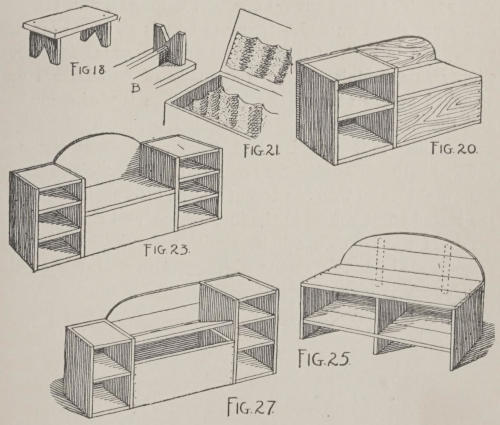
Fig. 18. Fig. 20. Fig. 21. Fig. 23. Fig. 25. Fig. 27.
The back is made from two boards shaped into a curve with a draw-knife and plane and held together with battens, as shown by the dotted lines in Fig. 25. The battens extend down behind the back of the box, and the ends are made fast with screws to support the back. The back and seat are padded with curled hair and covered with unbleached muslin, over which the upholstery material is[346] drawn and tacked to the edges. A valance of some pretty figured goods to match the seat and back is made, and tacked around the upper edge of the box. Wide gimp and large-headed upholsterers’ tacks will finish the edge of the seat and back, and it would be well to give the wood-work a coat or two of paint or stain.
In the illustration of the window-seat and shoe-box (Fig. 26) a substantial and useful piece of furniture is illustrated.
It is made of three boxes screwed together, as shown in Fig. 27. The lid of the middle box is hinged, and the end boxes are stood on end. One end box is shorter than the other, and in both of them shelves are arranged for shoes, slippers, or sandals. A back is made of two boards and attached at the rear of the boxes. The top of each box and the face of the back are padded with curled hair or moss filling that may be had from an upholsterer, and covered with some upholstery material. Buttons and string are caught down into the top of the padded surface to give the tufted effect shown in the illustration, and the sides and fronts of the boxes are hidden with valances. Gimp and large-headed nails finish the edges as shown, and when the wood-work is given a coat of paint this window-seat and shoe-box is ready for use.
In and around the house there is opportunity for the creation of a number of useful articles that can be made by any boy who is at all handy with tools. For example, the tops of doorways and windows in a dining-room may be improved by the addition of narrow shelves, or ledges, on which old plates, slim jugs, or some quaint old bottles may rest.
These ledges may be made from pine, white-wood, cypress, or other wood to match the trim. The wood should not be more than half or five-eighths of an inch in thickness, as shown at Fig. 1. The shelves should be three or four inches in width, with a straight front, or slightly curved, as shown in Fig. 2. This curve is called a serpentine line, and may be shaped with a draw-knife; or, if the wood is soft, it can easily be cut with a compass-saw and finished off with a draw-knife and sand-paper.
Two brackets cut from wood the same thickness as the shelf will support it at either end. These are cut three inches wide at the top and from six to eight inches long, in the shapes shown in Fig. 3.
It gives a more attractive finish to extend the ends of the[348] ledge two or three inches beyond the door or window trim, as shown in the illustration of Fig. 1.
For cups and small pitchers a plate-rail may be arranged around the walls of a dining-room, as shown at Fig. 4.
A wall-plate six or eight inches wide is made fast to the wall about five feet up from the floor, and to it, at intervals of twenty to thirty inches, brackets are screwed fast. These are cut in one of the forms shown in Fig. 3, and are three inches wide. The top shelf is four inches wide, and is laid on the tops of the brackets and pushed back against the wall, where the rear edge is screwed fast to the top edge of the wall-plate. Where the rail meets a doorway or window-casing the corner is rounded, as shown in the illustration. This may be done with a compass-saw and small plane. A narrow strip of wood is nailed fast to the top of the rail about two inches out from the wall, to prevent the plates from sliding off.
A narrow plate-rail may be attached to the wall higher up, or about in the position occupied by a picture-moulding. Shorter brackets should support it, and they may be attached directly to the wall without the aid of a wall-plate, since the latter would give a heavy appearance to a rail at that height.
It is hardly advisable to give definite dimensions for the cup and plate rack (Fig. 5), since it should be designed in[349] accordance with the amount of wall room that may be available. The rack shown in Fig. 5 is intended for a wall space three feet wide and seventy-two inches high. The two uprights are made of white-wood thirty-nine inches high, three inches wide, and half an inch thick. The lower ends are tapered, as shown in the drawing, and the upper ends are fashioned with a compass-saw. The brackets are six inches wide, nine inches long, and half an inch from the outer edge a depression is cut in the top to receive a half-inch dowel.

Fig. 1. Fig. 2. Fig. 3. Fig. 4. Fig. 5. Fig. 6. Fig. 7. Fig. 8.
The shelves on which the plates rest are three inches[350] wide and twenty-one inches long. The dowels extend from three to six inches over each end, as shown in the drawing. From their under-sides cups may be suspended on hooks screwed into the wood. The front edges of the shelves are provided with a strip of wood fastened on with slim, steel-wire nails, to prevent the plates from, sliding forward, as shown in Fig. 6, which is a plan of the arrangement of bracket, shelf, and dowel. The dowels can be had at a hardware store for two or three cents each, and from a quarter of an inch to the diameter of a small curtain-pole.
The cup and plate pyramid (Fig. 7) is another attractive dining-room feature and is very simple to construct. Three of the shelves are cut with a serpentine front, as shown in Fig. 8 A, and measure twenty-six, twenty-two, and eighteen inches respectively; while the top one is twelve inches long and cut as shown in Fig. 8 B. The shelves are six inches wide at the middle, and three of them are two and a half inches wide at the ends.
Short brackets one and a half inches wide and two and a half inches long support the shelves at the ends. Under the middle of the bottom shelf a large bracket five and a half inches wide and eight inches long is cut and made fast with long, slim screws driven down through the bottom shelf. A notch is cut at the front of each shelf, and a corresponding one in the staff that binds the shelves together, so that they are spaced, from the bottom up, eleven, ten, and nine inches apart. Slim, steel-wire nails two inches long will[351] secure the brackets to the wall, or long, slim screws may be used.
For the house that is not built with a butler’s pantry, or for the mother who does her own housework, the tray and drop-ledge shown in Fig. 9 will be found a very convenient piece of dining-room furniture.
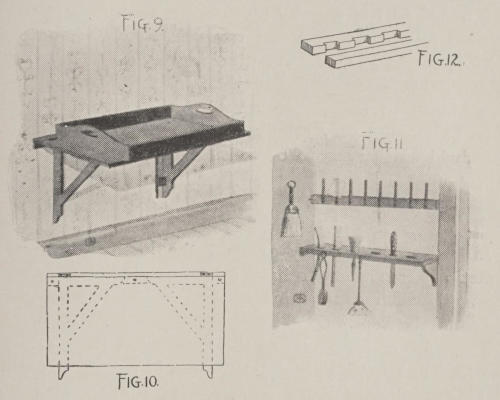
Fig. 9. Fig. 10. Fig. 11. Fig. 12.
Two brackets on hinges will support the shelf when it is up. When it is dropped the brackets fold in against the wall, as shown in Fig. 10.
The ledge and brackets are of pine wood three-quarters of an inch thick and planed on all sides and edges. The[352] tray is of white-wood five-eighths of an inch thick, and put together securely with glue and screws. The ends and handle-grips are cut with a compass-saw and finished with sand-paper; then the tray is stained and varnished to match the shelf and brackets.
Back of the drop-shelf a strip of wood two inches wide is fastened to the wall by means of a wall-plate securely screwed to the studding, and two vertical plates one inch thick make an anchorage for the brackets. The latter are attached by means of flat hinges, and the shelf proper is also hinged to the two-inch wall-plate. All these parts must be screwed very solidly together if the safety of the household crockery is to be considered.
In the butler’s pantry or near the kitchen sink it is sometimes convenient to have a brush-rack and some cup-pins, on which cups, drinking-glasses, and small hollow-ware may be kept.
These are easily made, as the illustration (Fig. 11) will show. The cup-pins are dowels sawed in five-inch lengths, and then made fast to a square pine stick with slim screws passed through holes that have first been made with an awl. The rack is then attached to the wall with screws passed into the studs or uprights behind the plaster.
The brush-rack is made from two pine sticks, one of which is cut out in places, as shown in Fig. 12. The two sticks are then screwed together and supported on brackets. Brushes kept in a drawer or on a shelf do not dry properly,[353] so that it is always best to place them where they have a free circulation of air.
In a cellar or store-room it is often convenient to have a portion of the shelves arranged so that their contents can be locked up. For this purpose Fig. 13 shows a slat door arranged in front of several shelves and hung on hinges. At the lower edge a hasp and eye may be made fast, so as to make a padlock available.
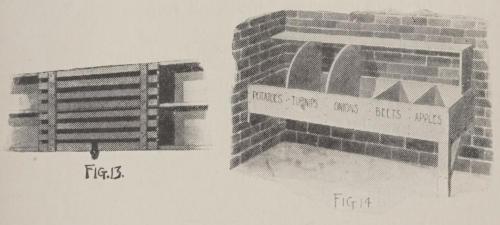
Fig. 13. Fig. 14.
The slats are from one-half to seven-eighths of an inch thick and two inches wide; they are fastened to battens with clinch-nails or screws driven from the inside. A smart boy can make any number of these doors so as to lock up a whole lot of shelving, but for convenience of handling they should not be more than four feet long.
For a corner of the cellar, and where it is convenient to the staircase, a very useful vegetable-bin may be made from[354] a few boards and slats (Fig. 14). The bin may be of any width and length, but for a house of the average size, it need not be more than six feet long and eighteen inches wide each compartment being from sixteen to eighteen inches wide.
The front, back, and ends are ten inches high, and two of the partitions are the same height. The partitions for the potato and turnip compartments should extend eighteen inches above the top of the bin, since these vegetables bulk largely. The bin rests on two battens nailed to the brick or stone foundation-walls of the cellar, two feet above the floor. At the exposed corner a foot, or leg, twenty-four inches long, supports it. The bottom of the bin is made of long slats nailed an inch apart, so that the dirt from the vegetables will fall through to the floor, from which it can be easily swept up. The ventilation from the slat bottom prevents the vegetables from decaying as quickly as they would in a box or barrel with a tight bottom.
Across the tops of the high partitions, and propped up at the exposed end of the bin, a shelf or ledge ten inches wide will accommodate cabbages, lettuce, bunches of carrots and beets, parsnips, and various other vegetables. In the illustration only five compartments are shown in the main part of the bin, but a bin of almost any length can be constructed according to the space available and the requirements of the family.
For the kitchen, a rack on which to hang spoons, ladles, saucepans, cups, and other small accessories to the culinary department is shown in Fig. 15.
It can be made to fit any wall space in a kitchen, but the brackets should be twenty inches high and ten inches wide at the top. They may be made from most any wood one and a half inches square, and put together with lap-joints. Three rails, seven-eighths by two inches, are attached to the inside of the front bracket-rails or supports, with long, slim screws or steel-wire nails. All the wood-work is painted two coats of white enamel, or any color to match the wood-work of the kitchen. Brass screws or galvanized nails are driven in the bars at regular distances apart, on which to hang the utensils, and the rack is then to be securely attached to the wall.
Every house should contain a medicine-chest, where the necessary boxes and bottles containing the family medicines may always be found in time of need. Chests may be made in any size and shape, and adapted to the spaces they may occupy on a wall or in a bath-room closet.
A convenient chest is shown in Fig. 16, and in Fig. 17 is given the plan of construction. For the average household it should be made eighteen inches wide and twenty-four inches high, with two shelves arranged so that the space between the lower one and the bottom of the box will be eight and a half inches. The space between the upper one and the top should be six inches, and between shelves seven and a half inches. The top and bottom wall-plates should measure four inches wide, and they are attached to the top and bottom of the box by means of screws driven into the edge of each through the top and bottom of the box.
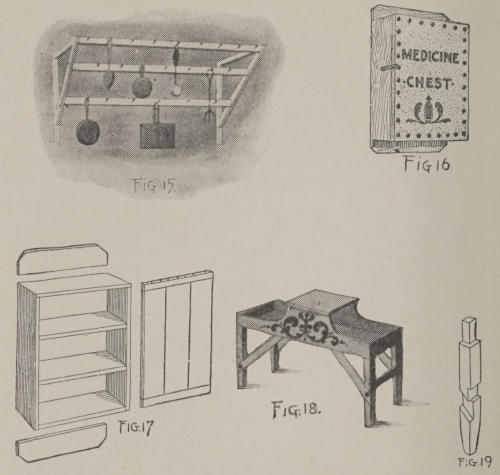
Fig. 15. Fig. 16. Fig. 17. Fig. 18. Fig. 19.
A door is made from three pieces of board across the ends of which battens are made fast, as shown in the plan drawing. This is attached to the box by means of hinges, and a catch at the other side will keep it closed. The wall-plates and sides of the chest should be stained and varnished, and the door covered with burlap glued fast or tacked at the inner side. The letters, ornament, and imitation nail-heads are cut from sheet-lead, scraps of which can be purchased at a plumber’s shop, shaped with a shears, or an old knife, and light mallet, and afterwards trimmed with[357] a penknife blade or a file. They may be attached to the door with slim, steel-wire nails, and painted black with a coating made by adding dry lamp-black to thin shellac, and applying it in one or two thin coats with a soft-hair brush.
Be careful to anchor this chest securely to the wall, as bottles are heavy and their weight must be taken into consideration.
In the illustration of a convenient plant-tray (Fig. 18) an idea is suggested for a receptacle that will accommodate several small pots in the lower tray and a large pot, or jardinière, on the middle deck.
The tray is thirty-six inches long and twelve inches wide and at the ends is four inches deep. But at the middle the sides are eight inches high, and support the stage or deck, which is thirteen inches square.
The tray is made of wood three-quarters of an inch thick and planed on both sides.
The legs are two inches square and twenty-four inches long, and at the bottom they are slightly tapered with a draw-knife and plane.
They are fastened to the inner side of the tray at the corners with long, slender screws driven down through the bottom of the tray and into the top of the legs.
Bracket-braces are let into the legs in lap-cuts made with saw and chisel, as shown at Fig. 19, and at the ends rails are let in between the legs to hold them rigidly.
The screws attaching these joints may be covered with mock nail-heads. The ornament at the side of the tray is[358] cut from sheet-lead with a stout pair of shears, painted black, and applied to the wood with flat-headed tacks or gimp-nails.
The available room in any clothes-closet can be more than doubled by adopting clothes-hangers and a rod. Fig. 20 shows the plan of a closet seen from above.
The projections around the outer edge represent hooks, while the bar through the middle and the cross-sticks represent the space gained.
Fig. 21 shows the usual rail and shelf, but under them are the bar and hangers that represent the new feature. This is a great improvement upon the ordinary closet, even when drop-hooks are used under the shelves for the support of hangers carrying clothes. The work necessary for this arrangement is very simple.
Obtain two sockets and a small curtain-rod, and fit the rod into the sockets screwed to the wall under the hook-rail, taking care to drive long, slender screws through the plaster. From a hardware or house-furnishing store obtain a number of coat-hangers composed of a wood bar and iron hook. These can be had at all prices from two for five cents to twenty-five cents each, or if it is impossible to purchase them they can be sawed out of wood by any boy and provided with iron-wire hooks. The bars are eighteen inches across and slightly curved at the top, like one’s shoulders. Underneath the bars, near the ends, small hooks may be screwed into place, on which trousers may be hung by using clamps (Fig. 22). In this manner[359] from four to six suits can be hung to every running foot of the pole.
This method will keep the coat or trousers in shape. If loops are sewn fast to the skirt-band, the skirt will hang on the two lower hooks much better than on a single hook, when this system is applied to mother’s or sister’s closets.
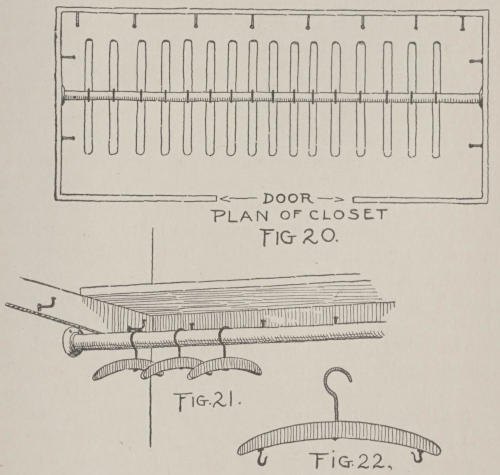
Fig. 20. PLAN OF CLOSET
Fig. 21. Fig. 22.
This device is so simple and useful that once tried it will always be used, and where economy of space is a feature,[360] this idea is a valuable one for both the city and country house.
A comfortable divan banked up with pillows is always an inviting addition to a room, and helps to furnish it. In Fig. 23 an idea is given for a piece of furniture that will serve a double purpose—that is, a couch and a skirt or trousers press, with a compartment for shirt-waists or fancy waistcoats.
In Fig. 24 the box, or framework, is shown. It is five feet six inches long, twenty-eight inches wide, and fifteen inches high.
The tray is ten inches deep, and divided into a long and short compartment. This is supported by the ends, which are fifteen inches high, and made from several pieces of board with matched edges. Corner-brackets at front and back lend additional strength, and prevent the frame from racking.
The top, or lid, is made from several matched boards held together with two or three battens; it opens on three or four stout hinges securely screwed into the wood of the back.
A valance is made of some good upholstery material, and tacked all around the upper edge of the box. For the couch proper use a mattress which is to be placed on the lid, and covered with the cloth used for the valance. This should be tacked securely to the under side of the lid. This will hold the mattress in place and make a good finish for the edges of the top.
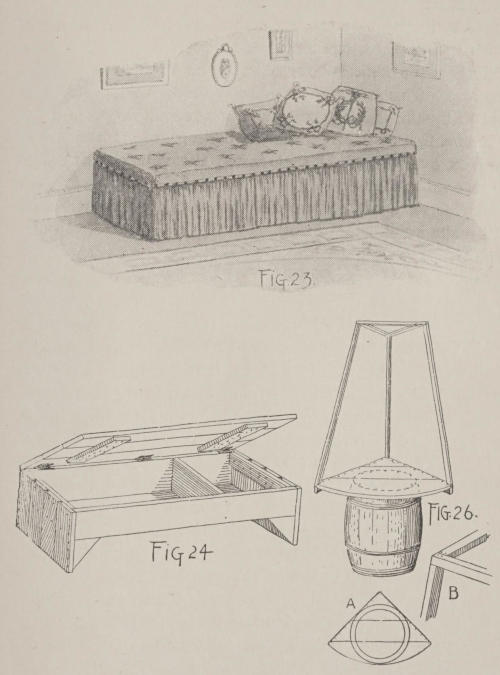
LOUNGE AND CORNER DRESSING-TABLE
Fig. 23. Fig. 24. Fig. 26.
Make a few holes through the lid, and with a long needle pass a string up through them, through a stout button and down again, where the string is to be tied around a tack, and then the tack is driven in so as to hold the string securely. This will give a tufted effect to the cushion top, and will make the mattress more secure.
Run a line of gimp or narrow belting around the top of the box over the tacks that fasten the valance, and with large, oval-headed upholsterers’ tacks make a line of heads three inches apart all around the sides and front. This will make an effective finish.
A very pretty dressing-table for the corner of a girl’s room is shown in the illustration (Fig. 25). This can be made by a boy for his sister, or by a girl with a liking for such work. As shown in Fig. 26, it is built up on a sugar barrel, which is thirty inches high and twenty-four inches across at the widest place. When it is inverted, screws or nails can be driven through the bottom to hold the triangular ledge or table-top in place.
Three boards should be cut to form a quarter of a circle thirty inches long on the two straight sides, as shown in Fig. 26 A. The sweep, or curved edge, is one-quarter of a five-foot circle. Fig. 26 A also shows how this quarter-circle is placed on the top of the barrel.
To keep the boards together, two battens thirty inches long are nailed or screwed underneath the straight edges.
Screws rather than nails should be used in fastening the quarter-circle to the barrel. They will not pull out or work loose so readily as nails.
The canopy top is supported on a framework consisting of three sticks, each three feet long, and a triangular top made of three short sticks, as Fig. 26 shows. At the top the sticks are joined as shown in B, and the lower ends are attached to the table-top with long, slim, steel-wire nails.
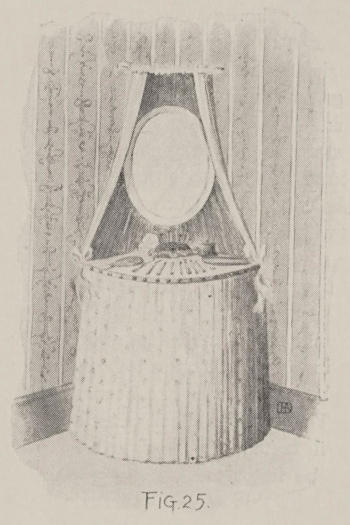
Fig. 25.
If the color scheme of the room is pink, pale-green, or canary color, this same color may be carried out in the drapery. Sateen or colored cotton goods may be overlaid with a dotted swiss or scrim, and tacked to the framework.[364] At the bottom a valance is made and caught to the circular edge of the ledge, which is covered with gimp held by brass-headed tacks.
The upper sticks of the frame are bound with strips of white muslin before the drapery is attached. This is to prevent the wood from showing through the goods, and also to make an anchorage in which some stitches can be taken, if necessary, to hold the canopy drapery in place.
For this top it will be necessary to have two swiss or thin scrim coverings, between which one thickness of the colored material is laid. Both sides of the drapery will be seen, and it is necessary to show the colored goods on both sides.
A shirred band of the goods may be arranged along the top stick of the canopy, and bows at the corners of the top and the edge will add to its appearance.
An oval or square mirror in a white or light enamelled frame can be suspended by wires from the top.
The directions as to methods and the suggestions of designs given in this book open a broader and more inviting field, it is believed, than has been accessible in similar form before. That there is need of a new handy-book comprehensive, well tested, and designed on practical modern lines seems to be indicated by the popularity of the preceding volumes in this series: Harper’s Outdoor Book for Boys and Harper’s Electricity Book for Boys, which, together with Harper’s How to Understand Electrical Work, form the modern “Boy’s Own Library.”
THE END